
- Amazon River
- Galápagos Islands
- Indonesian Archipelago
- Mekong River
- Irrawaddy River
- India Cruises
- Pacific Coast
- Patagonia Cruises
- Machu Picchu
- Iguazu Falls
- Brazil Travel Guide

Top 10 Brazil Tourist Attractions You Have To See
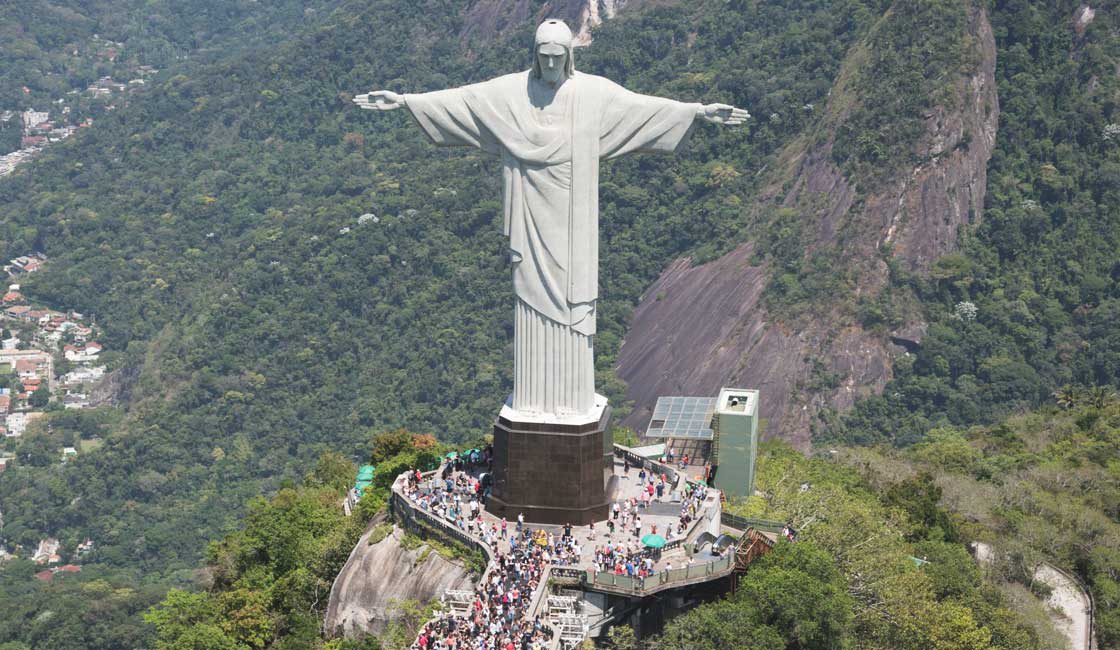
The largest country in South America, Brazil occupies almost half the continent. Nearly all of it is in the Southern Hemisphere, and much of it is tropical, with vast stretches of rainforest filled with exotic plants and wildlife. The country’s 4600-mile-long Atlantic coast is lined with golden-sand beaches, and its interior is filled with mineral resources. Portugal was the colonial power that ruled Brazil until 1822. The national language is Portuguese and a strong Portuguese influence is evident in Brazil’s colonial architecture and decorative arts. Below are what we consider the top attractions worth visiting on a vacation to Brazil .

Cristo Redentor
Christ the Redeemer
One of Brazil’s most iconic monuments and Rio’s most visited attraction , the statue of Christ the Redeemer was completed in 1931 and stands 98 feet tall, with horizontally outstretched arms spanning 92 feet. The work of Polish-French sculptor Paul Landowski and Brazilian engineer Heitor da Silva Costa is made of reinforced concrete clad in a mosaic of thousands of triangular soapstone tiles. The statue stands on a square stone pedestal about 26 feet high, which itself is situated on a deck atop the mountain’s summit. The base encloses a chapel that is popular for weddings. The statue has become emblematic of both the city of Rio de Janeiro and the whole nation of Brazil and is the largest Art Deco-style sculpture in the world.
In addition to the symbolic importance within the Catholic community, the statue is also one of the New Seven Wonders of the World and provides spell-binding views over Rio de Janeiro and the bay from the summit of Corcovado, 2310 feet above the city. The area on which it stands is part of the Tijuca National Park, and a rack railway climbs two miles to a broad plaza at the top. A mid-point stop on the railway leads to trails through the Tijuca National Park, replete with springs, waterfalls, and a wide variety of tropical birds, butterflies, and plants.

Way to experience the falls
Iguaçu Falls
At the point where Brazil, Paraguay, and Argentina meet, ten miles before joining the Parana River, the Iguaçu River flows over rough, uneven ground, and then, amidst the exuberant forest, spectacularly hurls itself into a semicircular chain of 247 irregular waterfalls that thunder down into the gorge below. Just above the falls, the river is constricted to a quarter of its usual width, making the force of the water even stronger. Some of the falls are more than 330 feet high and they cover such a broad area that you’ll never see all of them at once, but you do get the broadest panorama from the Brazilian side.
A visit to the Iguazu falls is a heart-stopping, visceral experience, while the power and noise of the cascades, which extend nearly 1.85 miles, will live forever in your memory. The falls lie split between Brazil and Argentina in the UNESCO-acclaimed Iguaçu National Park, where subtropical rainforests are home to more than 1,000 species of birds and mammals, including deer, otters, ocelots, and capybaras. Catwalks and a tower offer different perspectives, and one bridge reaches all the way to the largest water curtain, known as the Garganta do Diabo (Devil’s Throat), which drops more than 262 feet into a creamy white pool. You can cross to the Argentinian side for closer views from catwalks that extend farther into the center of the falls. The two sides offer different perspectives and views, so it’s a good idea to plan to see both.
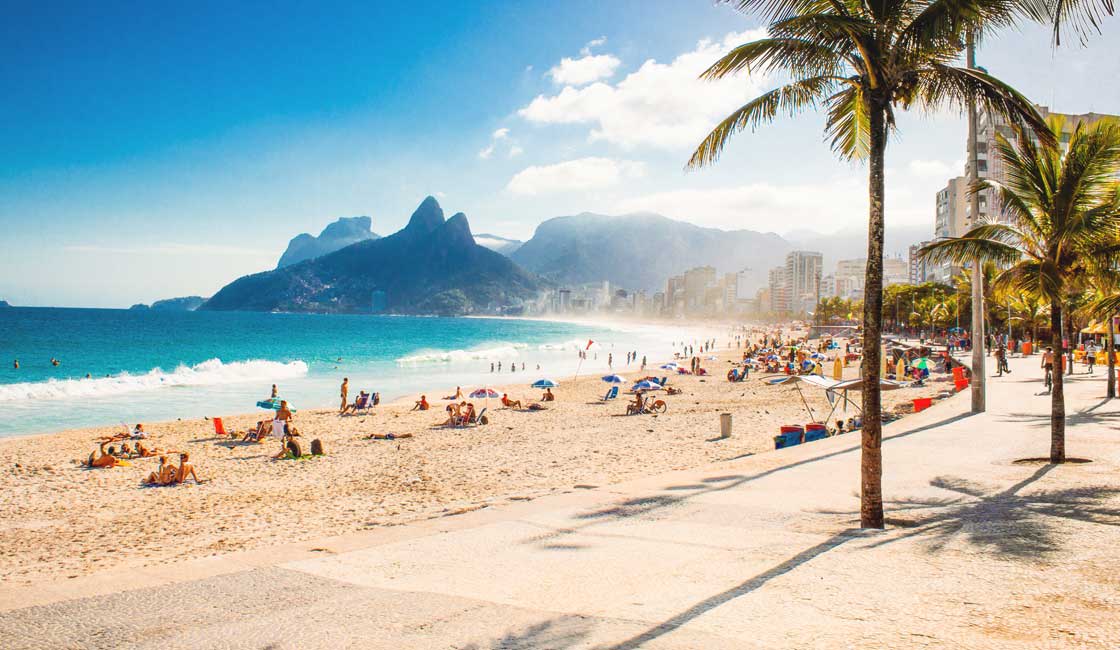
Copacabana, Rio de Janeiro
Occupying a narrow strip of land between the mountains and the sea, Copacabana − downtown Rio’s most fashionable district − follows Avenida Nossa Senhora de Copacabana, and is famous for its magnificent two-and-a-half-mile curved beach. Skyscraper hotels, apartment houses, cafés, shops, nightclubs, restaurants, theatres, live music bars, street fairs, and pubs line the waterfront. The neighborhood is a blend of Brazilian soul; it is crowded, rowdy, and traditional. However, the most powerful draw in Copacabana is still the fantastic view of the coast and the incredible white-sand beach alongside the rolling surf.
The beach is separated from the buildings and the traffic by a broad promenade paved in black and white mosaic in a rippled pattern inspired by Rocio’s Square in Lisbon, Portugal. The huge strip of sand bordering Copacabana Beach is not the result of a natural process; during the ’70s, a large land reclamation increased the area of the beach, which is a popular playground filled with sun-worshippers whenever the weather is fine.
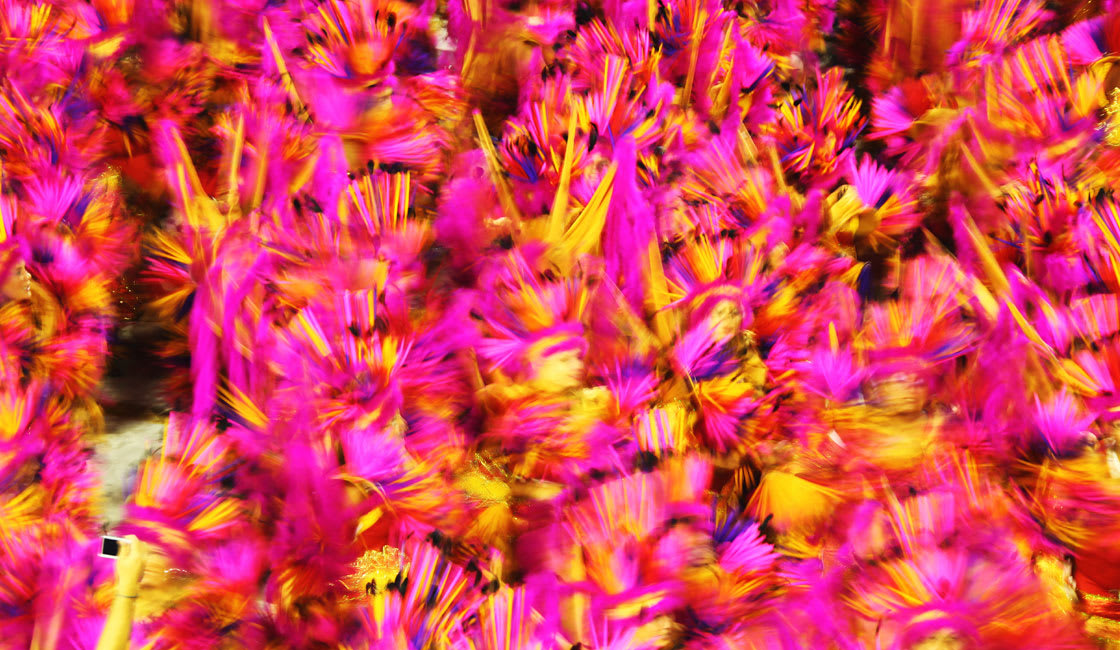
Carnaval (Carnival), Rio de Janeiro
Rio de Janeiro Carnaval is one of Brazil’s top tourist attractions − the mother, the mecca, the king of all carnivals. Every year, just before the beginning of Lent, Rio de Janeiro transforms into the biggest party on the planet, a party that is attended by five million people from all around the world. Few shows match Carnaval’s extravaganza for color, sound, action, and exuberance. This is not just another boisterous street party, but a carefully staged showpiece. The highlight of attending Rio Carnaval is witnessing the world-renowned Samba Parade hosted in a purpose-built stadium called the Sambódromo, where dancers and musicians from the competing samba schools strut their stuff in a dazzling explosion of brilliant costumes.
Carnaval is an exhilarating time to be in Rio, all the businesses unrelated to Carnaval shut down and the Brazilians completely embrace the carnival spirit, joining street parties across the city. You’ll also find Carnivals in Salvador, Bahia, Recife, and other Brazilian cities.
Bordered by Arpoador Beach on one end and Leblon Beach on the other end, Ipanema Beach is considered one of the main centers of activity for the city of Rio and one of the most expensive places to live. Known as the “Little Paris” of Rio, it is renowned for its avant-garde art galleries, bookstores, movie theaters, hotels, restaurants, and cafés, which make it a popular social zone year-round. The same wave design of Copacabana’s wide promenade continues here, separating the sand from the buildings. Sunday is especially busy, with an antique market at Praça de Quentaland and the Feira de Artesanato de Ipanema, alive with music, street food, art, and handcrafts with vendors selling everything from wooden dolls to swizzle sticks topped with parrots, making it fun a festive for families visiting Brazil .
Pelourinho, Salvador
Pelourinho is the historic city center of Brazil’s former colonial capital, Salvador . The cobblestoned streets and vibrantly colored buildings are a picturesque example of how the African, indigenous, and European cultures, which were thrown together in Salvador, have converged throughout the centuries. This old quarter has been named a UNESCO World Heritage site for its exceptional collection of 17th- and 18th-century colonial buildings, the finest such assembly in South America. This is where you’ll find Salvador’s most beautiful churches and monasteries, built at a time when Brazil was the source of Portugal’s riches, and the plentiful gold was lavished on the colony’s religious buildings.
The finest and most opulent of the city’s churches is São Francisco, built in the early 1700s and filled with intricate carvings covered in gold. Pelourinho means “whipping post” in Portuguese, and this was the location of the slave auction in the days when slavery was common. Slavery was outlawed in 1835, and over time, this portion of the city, though home to artists and musicians, fell into disrepair. In the 1990s, a major restoration effort resulted in making the area a highly desirable Brazil tourist attraction.

Ipiranga Museum
Art Museums of Sao Paulo
Sao Paulo holds some of the best collections of fine arts in Latin America, and the buildings in which they are housed are architectural landmarks as well. The Museu de Arte, MASP, is considered the premier art museum in Brazil, displaying the continent’s most comprehensive collection of Western art, with representative works by artists from Classical antiquity, the Renaissance, the Baroque period, along with plentiful works by Brazilian and other Latin American artists. The museum is a Modernist landmark conceived by Italian architect Lina Bo Bardi; bright red concrete elevates the building structure above ground making the museum stand out from the neutral-colored high-rise buildings that surround it. There are 73 bronze sculptures by Degas and works by Renoir, Manet, Van Gogh, Matisse, Picasso, and Miró.
At the Museu de Arte Contemporânea, in Ibirapuera Park, you’ll find more than 8,000 works of art. This is one of Latin America’s largest collections of 20th-century Western art, comprising the most important artists, art movements, and tendencies of modern and contemporary art. It includes works by Picasso, Chagall, Kandinsky, Miró, and Modigliani along with major Brazilian painters. Additionally, Museu do Ipiranga, set above Versailles-inspired formal gardens, houses paintings, and decorative arts.
For a different type of art, don’t miss Batman’s Alley, an open-air gallery of street art by local and international artists. It is in the bohemian Vila Madalena neighborhood, where you’ll also find art galleries showing the works of well-known and rising Brazilian artists and craftspeople.
Cathedral of Brasilia
This striking modernist building is an architectural icon of Brazil, designed by renowned architect Oscar Niemeyer. The round church has 16 concrete columns representing hands raised to heaven. The columns converge to a central elevated circle, soaring 138 feet towards the sky while allowing the natural light to flood in through a glass roof offering a glimpse to the heavens with angels suspended above the congregation. Not only that but the building is surrounded by a shallow pool that reflects its beauty.
Botanical Garden of Curitiba, Paraná
The postcard-worthy botanical garden is one of Curitiba’s main attractions and rightly so because it has an impressive and colorful garden and has a fantastic greenhouse. The Park is packed with flower gardens, with ideal places for picnics. Moreover, the external garden has a lovely French style with beautiful designs and walks between the areas colored by flowers and a fountain that provides beautiful photo opportunities. Inside the glass-and-steel greenhouse, it is possible to see species of plants typical of tropical areas.
Sugarloaf Mountain, Rio de Janeiro
Sugarloaf Mountain is arguably one of the most important tourist attractions in Brazil. The rounded rock peak juts out of a tree-covered promontory, rising nearly 1300 feet above the beaches and the city. Its summit offers jaw-dropping views of Rio and the harbor, together with the thrill of riding suspended in a cable car between SugarLoaf and the Morro da Urca, a lower peak from which a second cableway connects to the city. Rio’s first settlement began below these peaks, near the long Praia da Urca beach, and you can tour one of the three early forts there, the star-shaped Fort São João.
While Rainforest Cruises aim to provide accurate and up-to-date information, we make no representations as to the accuracy or completeness of any information herein or found by following any link on this site. Rainforest Cruises cannot and will not accept responsibility for any omissions or inaccuracies, or for any consequences arising therefrom, including any losses, injuries, or damages resulting from the display or use of this information.
You may also like

Best Places To Visit In The Pantanal To See Wildlife
One of the largest, most pristine, and most biologically vibrant wetlands in the world, the Pantanal offers South America’s all-around best wildlife-viewing opportunities. The “Kingdom of Waters,” as it’s sometimes called, easily […]
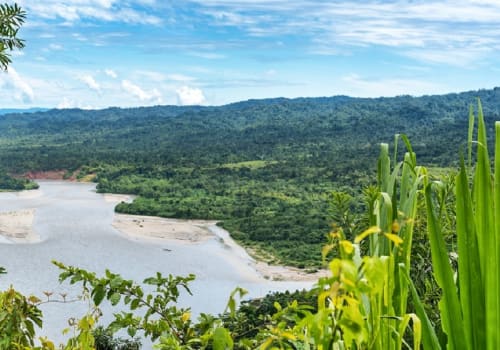
5 Best Places To Visit The Amazon Jungle To See Wildlife
One simply runs out of superlatives describing the rainforest of the Amazon Basin (the so-called “Amazon jungle” of popular conception). About the size of the conterminous United States, this biggest river basin […]
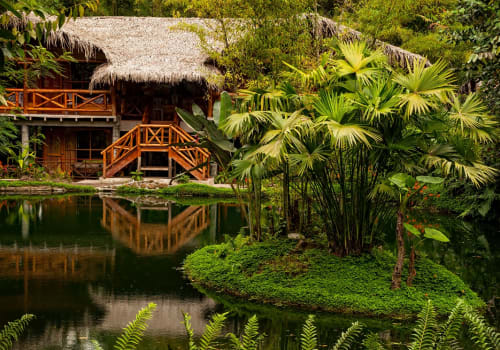
8 Luxury Amazon Rainforest Hotels: Where To Stay In The Amazon
The Amazon Rainforest is by far one of the most mysterious and exciting locales to visit in all of South America. Teeming with abundant wildlife, exotic trees and plants, and even indigenous […]
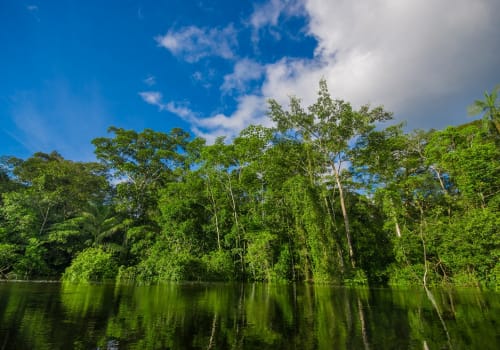
11 Tourist Attractions In The Amazon Rainforest You Must See
When it comes to untouched nature in a wildlife-rich environment, the Amazon Rainforest is one of the last places on earth to explore. Even hearing the word Amazon conjures up images of […]
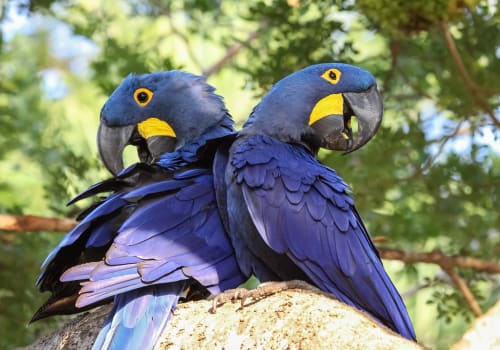
Pantanal Honeymoon | Lodges & Itinerary Ideas For Lovers
Are you looking for a honeymoon destination full of romance and adventure at the same time? Perhaps one in a remote location in a South American country full of different landscapes and […]

Pantanal Family Travel: Top 7 Things To Do With Kids
If you’re looking for a new destination for your family vacation this year, why not consider one of the most remote and naturally unique regions in all of South America? The Pantanal […]
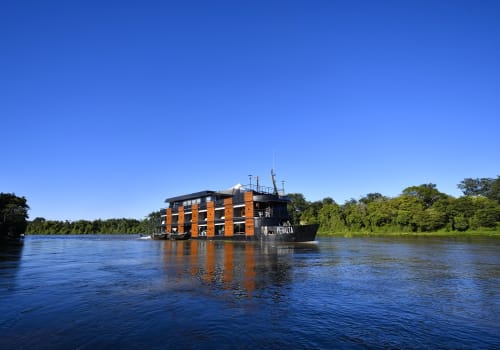
Where To Stay In The Pantanal
While exploring the Pantanal wetlands region in Brazil, where you lay your head at night is an important decision to make. While you may worry your options are limited, consider that several […]
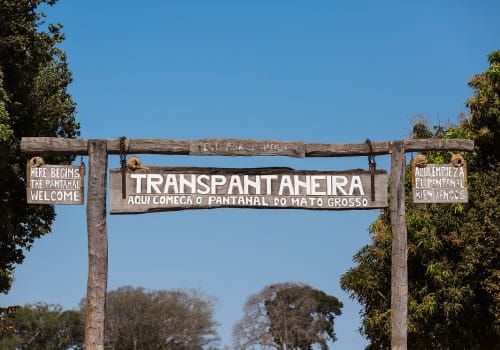
5 Amazing Attractions You Must See In The Pantanal
If you’re looking for a South American adventure unlike any other and a location not teeming with crowds, then head to the Pantanal region of Brazil. Tucked within the western part of […]
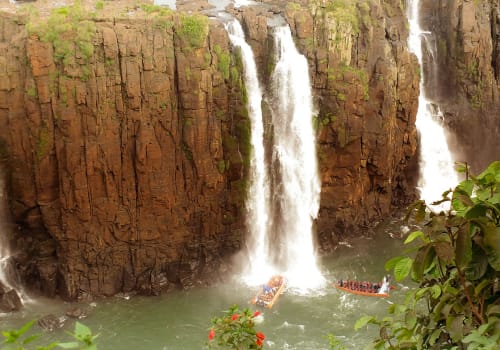
Brazil Vs Argentina: Which Side Of The Iguazu Falls Is Best?
Brazil vs Argentina, it’s a long-standing battle. The two countries compete in regards to almost everything: from their football teams to their natural wonders, from their tourist attractions to their barbeques, to […]
On the Lookout for Expert Advice & Offers?
Join over 20,000 discerning travelers and be the first to receive our monthly exclusive discounts, inspiring travel content and expert tips, straight to your inbox.

- Charter (Private)

DEAL FLASH: Get Free Flights On The Nov 27 Thanksgiving Amazon Cruise Aboard Zafiro
- South America
- 20 Must Visit Attractions In...
20 Must-Visit Attractions in Brazil

As the largest country in South America , Brazil is a vast playground for the intrepid traveller with everything from dense, exotic rainforest to bustling, dynamic cities, as well as sprawling national parks and glorious, jaw-dropping beaches. If you’re feeling spoilt for choice, here are the 20 attractions that are must-sees in Brazil.
Foz do iguaçu.
Foz do Iguaçu are one of the largest waterfalls in the world. This impressive natural phenomenon straddles the border of Brazil, Argentina, and Paraguay and is made up of hundreds of powerful cascades that tumble down into the fast-moving body of water below. A highlight is the Devil’s Throat, an 80-metre fall where visitors can look over the edge of a wooden platform that crosses the top.

Christ the Redeemer
One of Brazil’s most iconic monuments and Rio’s most visited attraction, Christ the Redeemer captures the imagination and hearts of hundreds of thousands of travellers each year. In addition to the symbolic importance in the Catholic community, the statue is also one of the New 7 Wonders of the World and provides spell-binding views over Rio de Janeiro.
Fernando de Noronha
Made up of a collection of 21 islands, Fernando de Noronha is a slice of paradise in Brazil. As a protected national marine park, the area is home to a diverse and rich ecosystem that includes dolphins, reef sharks, tropical fish, and rays. Famed for its undeveloped beaches and rugged, green coastline, it is a picturesque retreat and ideal for scuba diving and snorkeling.

Sugarloaf Mountain
One of Brazil’s most visited natural wonder is Sugarloaf Mountain in Rio de Janeiro, a rounded peak surrounded by the sea. Visitors take a cable car to the top to enjoy panoramic views over the city, the coastline and across the ocean – the most rewarding time to go is at sunset when the lights of the city twinkle below, while the sun casts shades of pink, orange, and red across the sky and sea.
Lençóis Maranhenses National Park
Located in the north of the country, Lençóis Maranhenses National Park is a striking desert landscape made up of sloping white sand dunes that stretch tall and wide, and dotted with rainwater lagoons that nestle between the valleys of the sand banks. The largest lagoons there are Lagoa Azul and Lagoa Bonita.

A huge wetland that swallows up the west of Brazil before sprawling into Bolivia and Paraguay, the Pantanal is a wildlife haven rich in a diverse ecosystem of rare and wonderful creatures. Nature lovers can spot hundreds of species of birds, in addition to large mammals such as jaguars and capybaras. Some of the most famous residents there are the thousands of caimans.

Become a Culture Tripper!
Sign up to our newsletter to save up to $1,656 on our unique trips..
See privacy policy .
Amazon rainforest
One of the most ecologically complex regions in the world, the Amazon rainforest is an extraordinary natural wonders. The dense forest provides fertile grounds for thousands of endemic species, while the Amazon river provides a home for incredible freshwater life, including the elusive pink river dolphins.

Chapada dos Veadeiros
Stretching across the central of Brazil is Chapada dos Veadeiros, an immense national park comprising deep canyons, hardy vegetation, and imposing quartz crystal formations. It is a fertile ground for several orchid species that grow wild throughout the park, and local residents include jaguars and armadillos.
Pelourinho, Salvador
Pelourinho is the historic city centre of Salvador in the state of Bahia. The vibrantly coloured buildings are a picturesque example of how the African, indigenous and European cultures, which were thrown together in Salvador, have converged throughout the centuries.

Located in the exotic northeast of Brazil, Fortaleza is a coastal city with strong winds that have attracted adrenaline-junkie kitesurfers for years. Watch the surfers race across the sea’s surface, their trajectory temporarily broken by impressive, daredevil leaps. The city is famed for its fresh, locally-sourced seafood with beachside restaurants in abundance serving Fortaleza’s delicious cuisine.
Jalapão State Park
Jalapão State Park is in the lesser-known state of Tocantins, yet the park has long been on the radar of curious travellers who love adventure. Known for its deep-orange dunes, raging rivers, and cascading waterfalls, it is a prime example of untouched wilderness that will keep any intrepid visitor satisfied.

Dunas de Genipabu
Just a short drive from Natal in the state of Rio Grande do Norte, the Genipabu dunes are an ever-changing collection of sand dunes that are shaped and reshaped by the daily winds that come off the coastline and whip over the sands. The region offers a host of adventurous activities such as buggy rides, camel treks and sledging down the sand dunes.
The charming colonial city of Olinda sits in the north of the country, in the state of Pernambuco. Located on a hilltop, it is a cultural wonderland of churches, museums, and buildings that have kept their colonial façade. The best time to go is during carnival when the city comes alive with vibrant, colourful street celebrations that reflect its strong African roots.

Porta de Galinhas
With its crystal clear waters and white, pristine beaches, Porta de Galinhas has deservedly earned the title as one of the most beautiful beaches in Brazil. When the tide comes in, the shoreline fills up with warm pools, locked between walls of coral and filled with a thriving ecosystem of marine life. It is possible to see marine turtles here, as well as seahorses for the observant snorkeller.
Mount Roraima
A rock formation that seems straight out of The Lost World, Mount Roraima is an imposing flat-top mountain that extends across the borders of Brazil, Venezuela, and the less-explored Guyana. To reach the top takes between seven and 10 days, but those that try will be treated to unforgettable views and waterfalls on the way.

Inhotim is located outside of Belo Horizonte in Minas Gerais, and has inspired art lovers across the world. The open-air art gallery is located on the grounds of a 5,000-acre botanical gardens and houses sculptures, art pavilions and interactive masterpieces from both Brazilian and international artists.
A region teeming with natural resources and wildlife, Bonita in the southwest of the country is recognised for its ecological importance and has become a well-protected haven. With freshwater pools and waterfalls alive with thriving shoals of tropical fish, it is a must-visit for any keen nature explorer. One of the highlights is Gruta do Lago Azul, an underground flooded cavity that stretched more than 200 feet deep and home to the fossiled remains of prehistoric animals, such as sabre-tooth tigers. The source of the mysterious, underground river that has yet to be discovered.

Chapada Diamantina
This large national park is teeming with an extraordinary range of biodiversity from rare orchids to large animals such as giant anteaters and armadillos. The large flat top rock formations with long, sloping plains beneath them create breathtaking views and scenery.
Cathedral de Brasilia
This cathedral with its circular-inspired ceiling is the masterpiece of Brazilian architect, Oscar Niemeyer. The all-around stained glass walls slant up to a single point in the ceiling and allow natural light to flood in, creating an airy atmosphere. The cathedral has a capacity of 4,000 people, watched over by angels that hang suspended from the ceiling.

Bento Goncalves
The landscape of Bento Goncalves comprises sloping hills, rows of grapevines and quaint rivers, ringing a persistent bell that sounds of the Italian countryside scenery. That’s unsurprising, given the area is largely influenced by Italian immigration in the 1800s. The area is replete with wine regions, locally-produced foods such as cheese and jams, and the streets are lined with charming boutique restaurants and places to eat.
Culture Trips launched in 2011 with a simple yet passionate mission: to inspire people to go beyond their boundaries and experience what makes a place, its people and its culture special and meaningful. We are proud that, for more than a decade, millions like you have trusted our award-winning recommendations by people who deeply understand what makes places and communities so special.
Our immersive trips , led by Local Insiders, are once-in-a-lifetime experiences and an invitation to travel the world with like-minded explorers. Our Travel Experts are on hand to help you make perfect memories. All our Trips are suitable for both solo travelers, couples and friends who want to explore the world together.
All our travel guides are curated by the Culture Trip team working in tandem with local experts. From unique experiences to essential tips on how to make the most of your future travels, we’ve got you covered.

Food & Drink
The best brazilian desserts you need to try.

Guides & Tips
The most beautiful sunsets on earth.

Places to Stay
The best campsites and cabins to book in brazil.

The Best Hotels to Book in Brazil for Every Traveler

The Best Destinations for Travellers Who Love to Dance

The Most Beautiful Botanical Gardens in the World

The Best Private Trips to Book for Reunions

The Best Resorts in Brazil

See & Do
Everything you need to know about rio’s pedra do telégrafo.

The Most Beautiful Coastal Cities to Visit With Culture Trip

The Best Villas to Rent for Your Vacation in Brazil

The Best Private Trips to Book for Your Dance Class
Culture trip spring sale, save up to $1,656 on our unique small-group trips limited spots..

- Post ID: 1315118
- Sponsored? No
- View Payload

- Virginia Beach
- History & facts
- Famous people
- Famous landmarks
- AI interviews
- Science & Nature
- Tech & Business
Discover something new everyday
Famous places
- Food & Drinks
- Tech & Business
Famous places , Travel
Brazil’s Top 30 Tourist Attractions: Discovering the Wonders of South America

Rafael Rabello de Barros , CC BY-SA 3.0 , via Wikimedia Commons
Read Next →
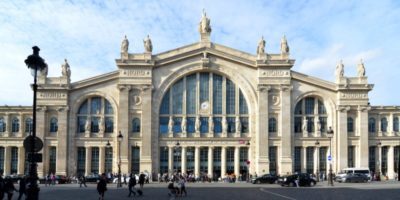
Things to do Near Gare du Nord Station
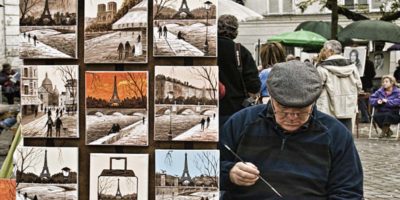
Paris - Our top 10 lists
Top 45 souvenirs to bring back from Paris

28 things you probably didn’t know about Sacre-Coeur basilica in Paris
1. christ the redeemer (cristo redentor).

Nico Kaiser , CC BY 2.0 , via Wikimedia Commons
2. Sugarloaf Mountain (Pão de Açúcar)
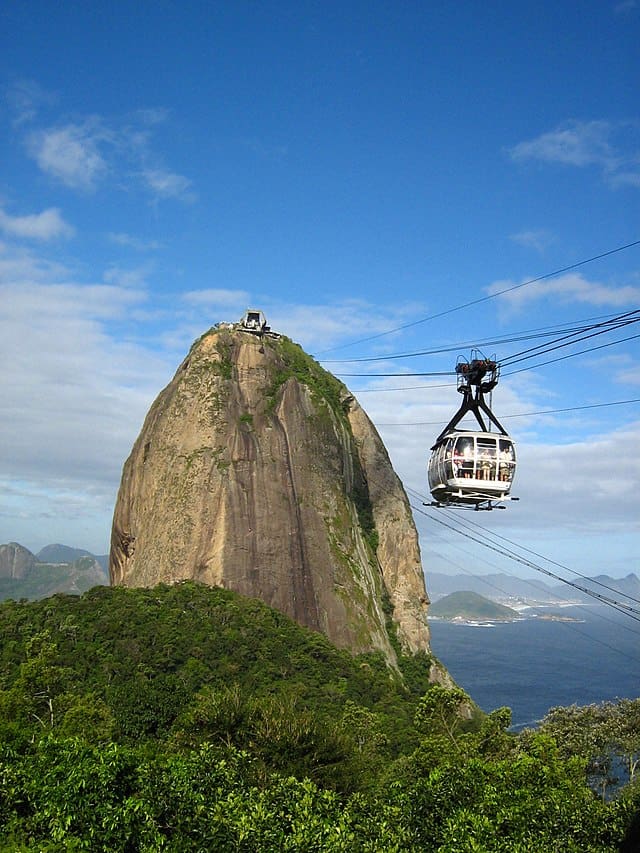
Wutzofant. , CC BY-SA 3.0 , via Wikimedia Commons
3. Iguazu Falls (Cataratas do Iguaçu)
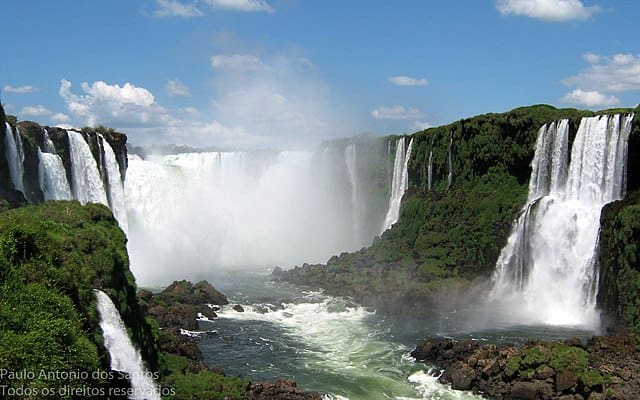
Paulo Antonio Santos , CC BY 3.0 , via Wikimedia Commons
4. Amazon Rainforest
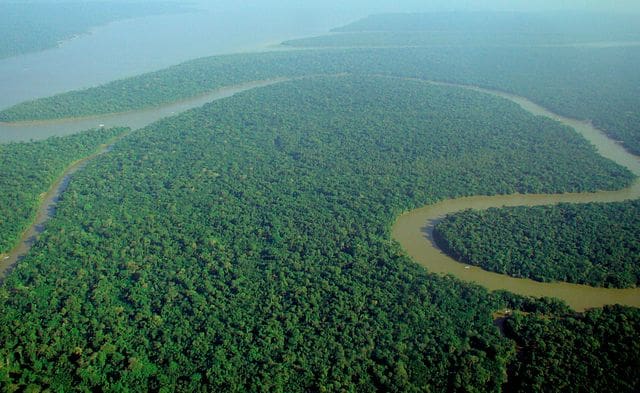
lubasi , CC BY-SA 2.0 , via Wikimedia Commons
5. Pantanal
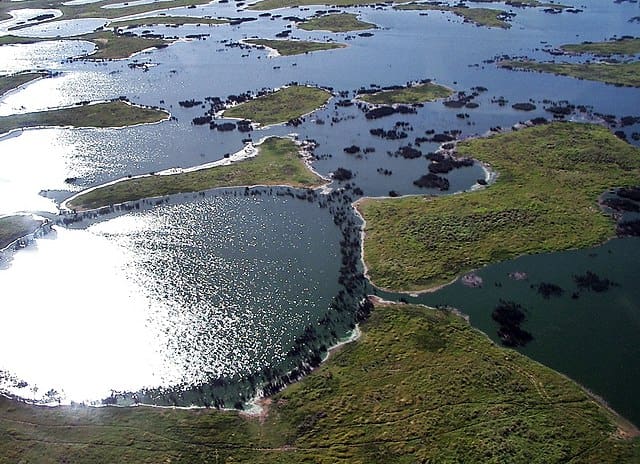
Alicia Yo at the English-language Wikipedia , CC BY-SA 3.0 , via Wikimedia Commons
6. Salvador
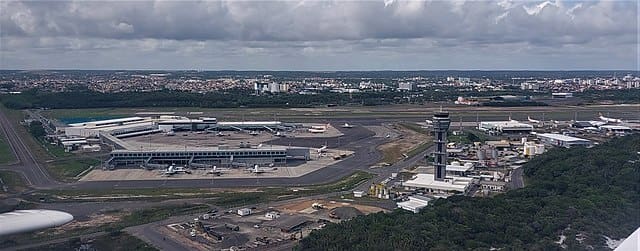
PT-AVJ , CC BY-SA 4.0 , via Wikimedia Commons
7. Fernando de Noronha
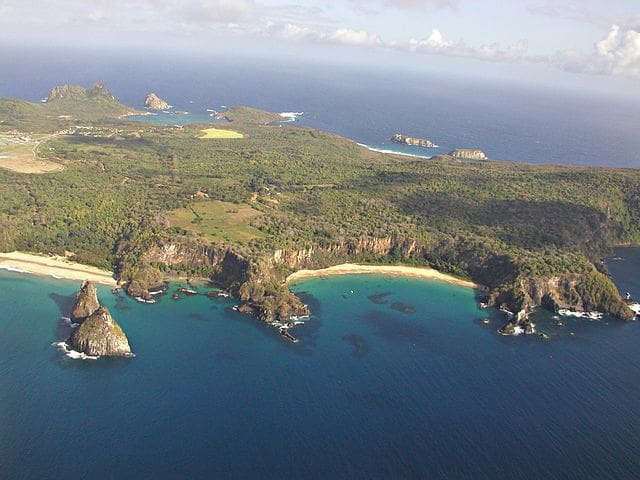
https://upload. wikimedia .org/wikipedia/commons/6/6b/Fernando_de_Noronha_-_dois_Irm%C3%A3os_-_praia_do_sancho.jpg
8. Brasília
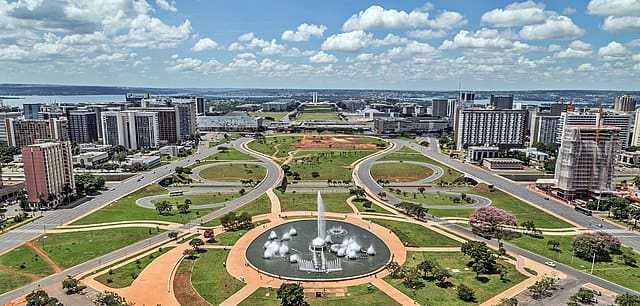
Arturdiasr , CC BY-SA 4.0 , via Wikimedia Commons
9. São Paulo
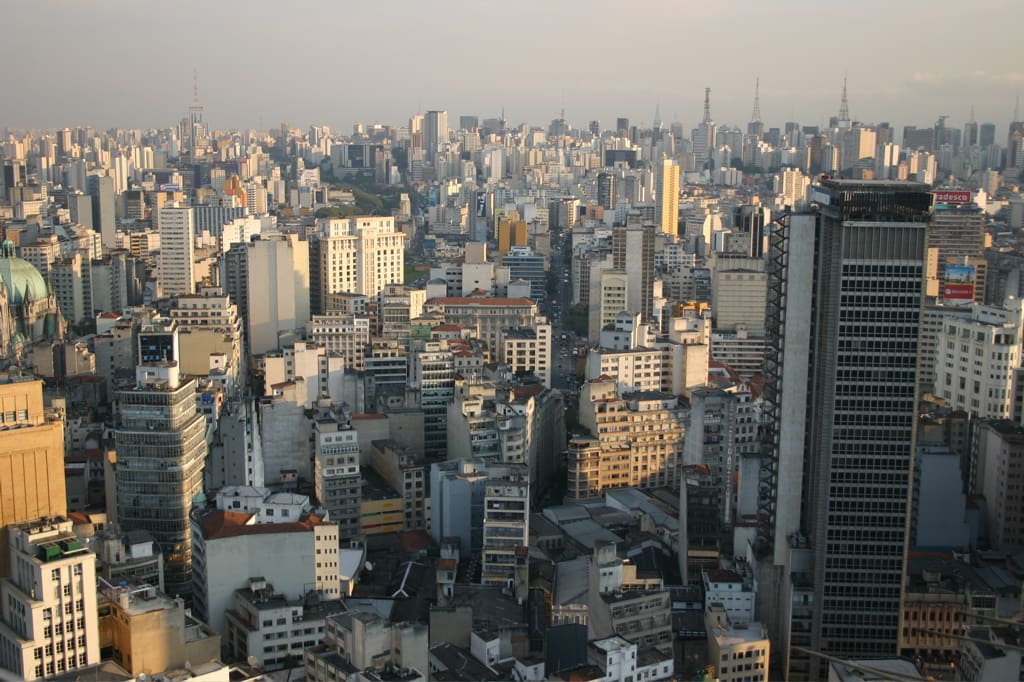
Thomas Hobbs , CC BY-SA 2.0 , via Wikimedia Commons
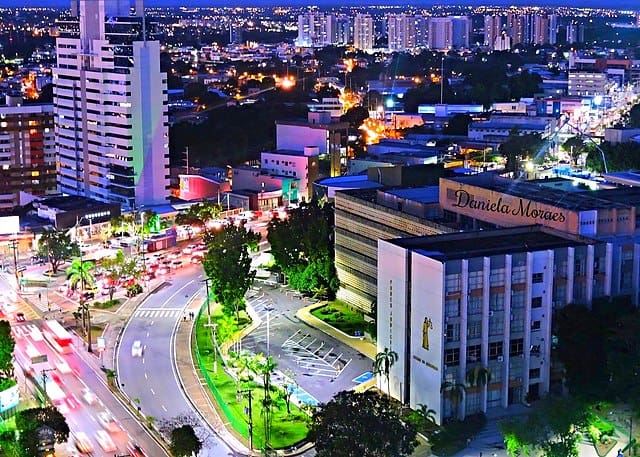
Daniela de Oliveira Moraes , CC BY 2.0 , via Wikimedia Commons
11. Ouro Preto
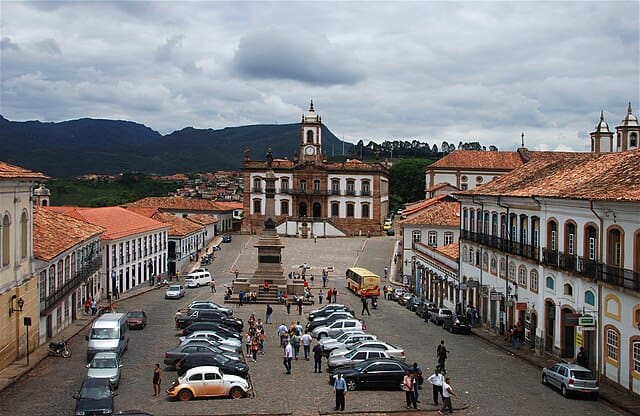
Alvesgaspar , CC BY-SA 3.0 , via Wikimedia Commons
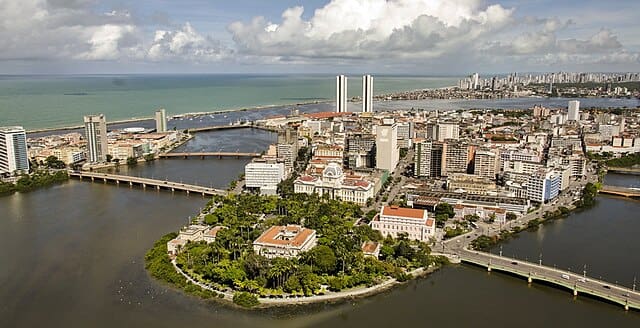
Portal da Copa/ME , CC BY 3.0 BR , via Wikimedia Commons
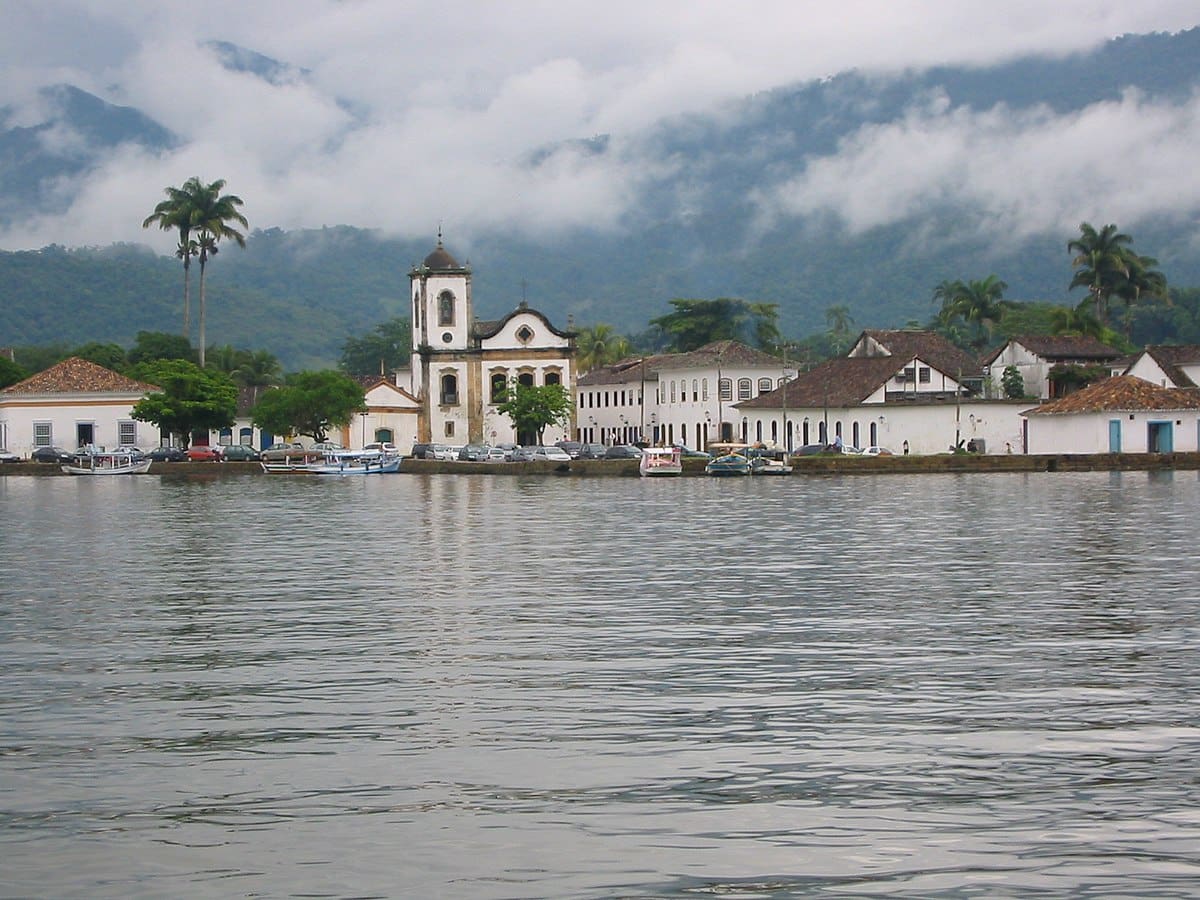
Lampiao3 , Public domain, via Wikimedia Commons
14. Chapada dos Veadeiros
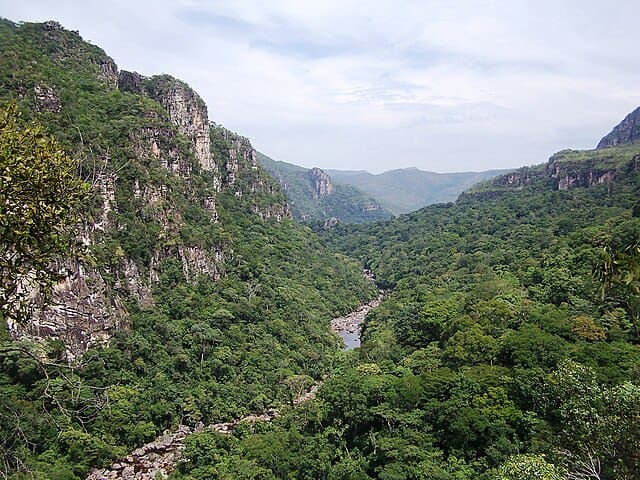
Marina Campos Vinhal , CC BY 2.0 , via Wikimedia Commons
15. Lençóis Maranhenses National Park

Julius Dadalti , CC BY-SA 4.0 , via Wikimedia Commons
16. São Miguel das Missões
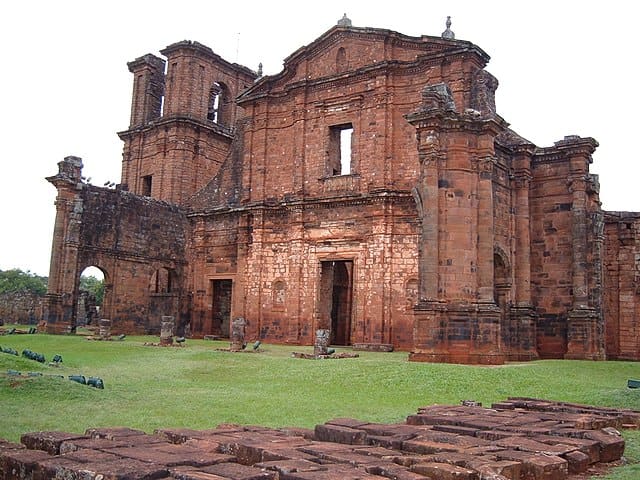
JefersonSouza , CC BY-SA 4.0 , via Wikimedia Commons
17. Ilha Grande
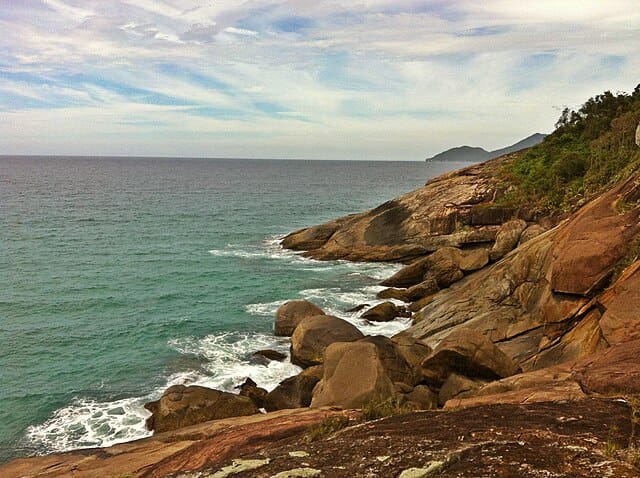
TMbux , CC BY-SA 3.0 , via Wikimedia Commons
18. Petrópolis

PU1JFC , CC BY-SA 4.0 , via Wikimedia Commons
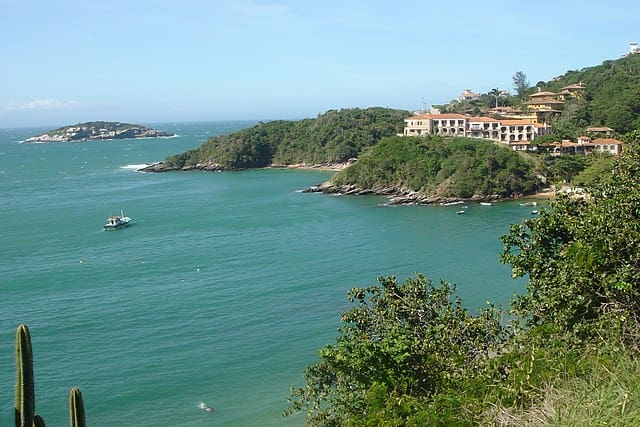
Mariordo Mario Roberto Duran Ortiz , CC BY-SA 3.0 , via Wikimedia Commons
20. Carnival in Rio de Janeiro
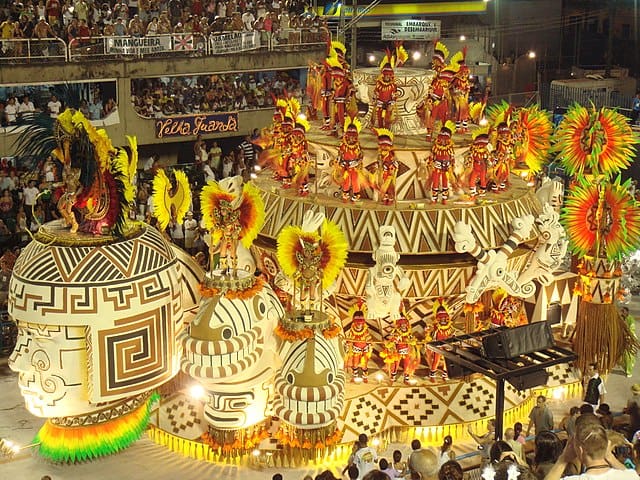
Sergio Luiz , CC BY 2.0 , via Wikimedia Commons
21. São Paulo Museum of Art (MASP)
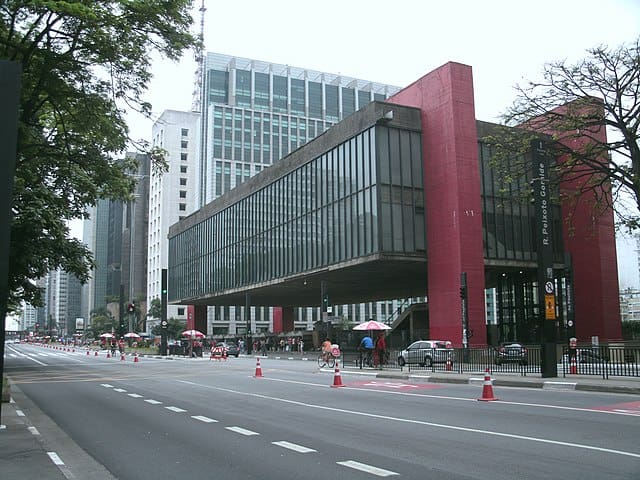
CORRETOR-CARVALHO , CC BY-SA 3.0 , via Wikimedia Commons
22. Inhotim
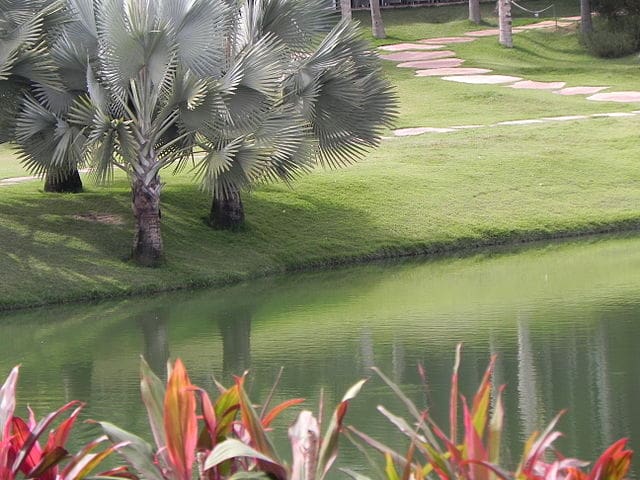
Jadderbh , CC BY-SA 3.0 , via Wikimedia Commons
23. Teatro Amazonas
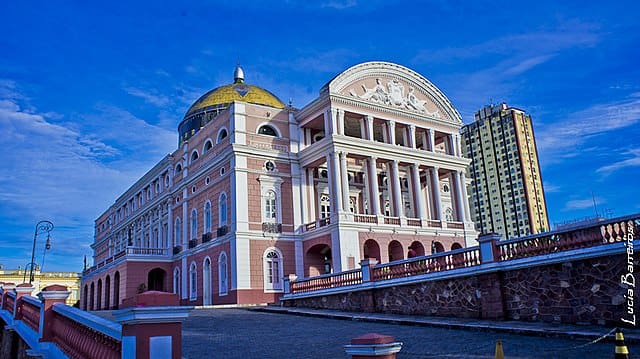
Lucia Barreiros da Silva , CC BY-SA 4.0 , via Wikimedia Commons
24. Serra da Capivara National Park

Paulo César Pamplona Barreto de Sousa , CC BY-SA 4.0 , via Wikimedia Commons
25. Ilhabela
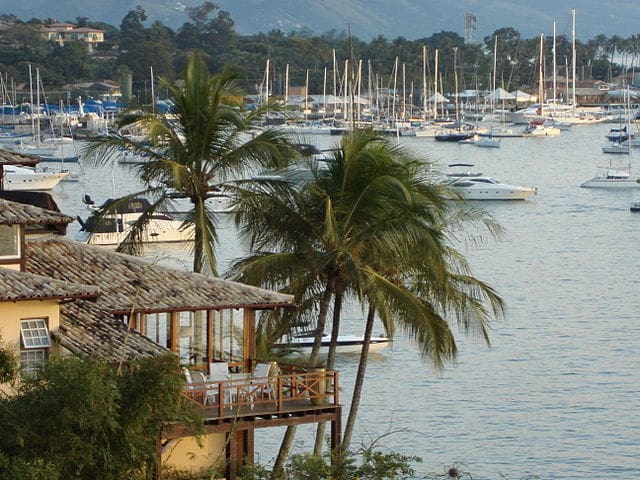
Jurema Oliveira , CC BY-SA 3.0 , via Wikimedia Commons
26. Praia do Forte

Glauco Umbelino from Moro em Belo Horizonte, Brasil , CC BY 2.0 , via Wikimedia Commons
27. Canoa Quebrada

Jorge Brazilian from Rio de Janeiro, Brazil , CC BY 2.0 , via Wikimedia Commons
28. Itaipu Dam

Angelo Leithold , CC BY-SA 3.0 , via Wikimedia Commons
29. Caldas Novas

Eric Gandolph , CC BY-SA 4.0 , via Wikimedia Commons
30. Maracanã Stadium

Brazilian Government , CC BY 3.0 BR , via Wikimedia Commons
Planning a trip to Paris ? Get ready !
These are Amazon’s best-selling travel products that you may need for coming to Paris.
- The best travel book : Rick Steves – Paris 2023 – Learn more here
- Fodor’s Paris 2024 – Learn more here
Travel Gear
- Venture Pal Lightweight Backpack – Learn more here
- Samsonite Winfield 2 28″ Luggage – Learn more here
- Swig Savvy’s Stainless Steel Insulated Water Bottle – Learn more here
Check Amazon’s best-seller list for the most popular travel accessories. We sometimes read this list just to find out what new travel products people are buying.
Vanessa is a passionate writer driven by a never-ending desire to travel the world. She enjoys yoga and reading when she is not venturing into jungles or trying foreign foods. Vanessa writes engaging travel pieces for DW in which she highlights culinary delights, historical insights, and hidden gems and also enjoys science and nature articles and has written about famous scientists. She has a special talent for capturing her audiences’ wanderlust transporting them with engaging storylines that give them a taste of what it is like to immerse themselves in a destination.
Hello & Welcome

Popular Articles

Top 20 Streets to See in Paris

Paris in two days

Top 15 Things to do Around the Eiffel Tower

The Best Way to Visit Paris Museums

Top 15 Fashion Stores in Le Marais
Visit europe with discover walks.
- Paris walking tours
- Montmartre walking tour
- Lisbon walking tours
- Prague walking tours
- Barcelona walking tours
- Private tours in Europe
- Privacy policy
© 2024 Charing Cross Corporation
Rio de Janeiro Travel Guide
Courtesy of Anna Gibiskys | Getty Images


17 Best Things to Do in Rio de Janeiro, Brazil
If it's your first time in Rio, you can't pass up people-watching along the white-sand shores of Copacabana or Ipanema . But don't spend all your time at the beach; the Marvelous City has more spectacular natural beauty to offer with sites
- All Things To Do

Christ the Redeemer Christ the Redeemer
This iconic landmark is a must-see attraction in Rio. Recognized as one of the New Seven Wonders of the World, this statue of Jesus Christ stands with arms outstretched to the city from above Corcovado Mountain's staggering 2,310-foot elevation.
Started in 1922 and completed in 1931, the monument – made of concrete and covered in soapstone mosaic tiles – stands 124 feet tall as a religious and cultural symbol of the Brazilian people's warm and welcoming culture. The monument rests atop Corcovado Mountain in the Tijuca National Park and is the most famous attraction in Rio de Janeiro, visited by nearly 2 million people each year. Recent travelers recommend visiting on a day with clear skies since the vantage point is the best in the city. Many also advise going as early as possible to avoid the crowds.

Tijuca National Park Tijuca National Park
U.S. News Insider Tip: After a day of hiking, head over to Os Esquilos ("The Squirrels"), the national park's only restaurant. Visit between May and October when Rio's temperatures drop to enjoy fondue paired with red wine next to the roaring log fire. – Sarah Brown
Outdoorsy types love exploring this expansive green rainforest. Covering more than 9,600 acres, Tijuca National Park sits within the Atlantic Forest and is one of the largest urban forests on the planet. The natural beauty of the park can't be understated: it features varied terrains, waterfalls, caves and more than 1,600 plant species and more than 300 different species of mammals, birds, amphibians, and reptiles.

Jardim Botânico Jardim Botânico
Spread out across more than 350 acres, this botanical paradise awes its visitors with more than 7,000 indigenous and exotic species of flora. This serene garden hosts everything from orchids to Amazonian trees to large ferns, and is a haven for wild animals such as marmosets, frogs and tropical birds. The gardens were originally created in 1808 by Regent Prince D. João to acclimatize spices from other regions. Since its debut to the public in 1822, the verdant sanctuary has become a haven for locals and tourists; Albert Einstein even dropped in. The national park is also known as a premier botany and ecology research center.
Travelers relish the garden's tranquility, the abundance of nature, and recommend taking guided or self-driven thematic tours of the park's various sections. The park also includes a playground, souvenir shop and the Garden Café restaurant.

Popular Tours

Full Day: Christ Redeemer, Sugarloaf, City Tour & Barbecue Lunch
(2355 reviews)
from $ 83.00

Rio's Full Day: Selarón Steps, Christ & Sugarloaf – Tickets & Lunch Included
(1470 reviews)
from $ 146.00

The Best Half Day in Rio with Christ Redeemer and Sugar Loaf Hill
(767 reviews)
from $ 84.50

Boat Tours Boat Tours
With its iconic coastline and mountainous backdrop, Rio de Janeiro is best explored from the water. Boat tours offer a unique perspective of the city, giving visitors opportunities to admire its stunning beaches, islands, and landmarks from a different angle. There's a variety of boat tours to suit different preferences, including daylong boat tours and scuba diving excursions.
A scuba diving trip takes about five hours. Trips usually go to Cagarras Island – just off the coast of Ipanema – or to Arraial do Cabo – east of Rio. Those who have never dived before will get a quick lesson from experienced divers and will be accompanied in the water by a guide during their entire swim. Qualified divers can go ahead and enjoy the underwater biodiversity. Rio Natural Ecotourism and Itaway Eco Tours are two favorite vendors among tour-takers. Prices start at $130 per person.

Lapa Lapa free
If you come to Rio to revel in samba and other Brazilian music, Lapa is the place for you. This festive neighborhood ignites at night when locals swing their hips and sip on delectable cocktails. Brimming with rows of botecos (typical Brazilian bars), clubs and live music venues, Lapa's seductive night crawl certainly isn't lacking excitement or charm.
You'll definitely want to check out Rio Scenarium , the most popular Brazilian club that features three stories, vintage decor and a long list of craft cocktails. Other popular bars and nightclubs include Leviano , known for its variety of music ranging from samba to forró , and Armazém do Senado , a lively bar with live music where visitors spill out into the street, especially on Saturday afternoons.

Ipanema Beach Ipanema Beach free
U.S. News Insider Tip: At the end of the day, go to Arpoador at the far end of Ipanema near Copacabana to watch the sunset next to the Dois Irmãos (Two Brothers Mountains). Locals clap as the last slither of sun dips behind the horizon. – Sarah Brown
Made famous by the well-known bossa nova song, "The Girl from Ipanema," this beach has drawn tourists for decades. The 1.5-mile stretch of sand boasts gorgeous mountain views, beautiful Brazilians and cobalt waters. While sunbathing, you'll observe wildly entertaining games of futevolei (the Brazilian version of volleyball without hands) and smell coalho cheese with oregano grilling nearby on skewers.

Escadaria Selaron Escadaria Selaron free
One of the most iconic landmarks in Rio de Janeiro is the Escadaria Selarón, or Selarón Steps, a 250-step staircase decorated with more than 2,000 carefully placed tiles from around the world. It was created by Chilean-born artist Jorge Selarón who began the project in 1990 of transforming a run-down outdoor staircase in Rio's downtown into one of the city's most photographed masterpieces. Dedicating hours of life to what he referred to as a tribute to Brazilian people, Selarón was found dead on his steps in 2013 (the exact cause of his death has not been disclosed). Today, the landmark has appeared in fashion magazines, music videos and films and continues to be one of the city's most visited icons. Best of all, it's free to visit.
Recent visitors said it was a must-see and a great spot for photos, even though it can get a bit crowded. Some travelers said the steps themselves are safe, however, it's recommended to keep belongings close while wandering in the surrounding area to avoid pickpocketing.

Sugarloaf Mountain (Pão de Açúcar) Sugarloaf Mountain (Pão de Açúcar)
U.S. News Insider Tip: After visiting the Sugarloaf, unwind at the neighboring picturesque Praia Vermelha beach and then head over to the nearby Mureta, a bay-side wall in Urca where locals gather to watch the sunset and socialize the night away. – Sarah Brown
Standing high above Rio's bustling metropolis at 1,296 feet, Pão de Açúcar, or the Sugarloaf Mountain, cascades over the picturesque Guanabara Bay. From Praia Vermelha (Red Beach) in the residential Urca district, you can take a three-minute cable car ride up to Morro da Urca and then hop on another cable car up to the top of Sugarloaf. From the glass-enclosed bondinho (cable car), you'll get a dazzling view of the city, the sea and Rio's tree-covered mountains.

Christ the Redeemer, Sugarloaf, Lunch and Small Group City Tour
(396 reviews)
from $ 95.00

Experience Hang Gliding or Paragliding in Rio
(348 reviews)
from $ 171.35

Private Custom Full-Day Highlights in Rio: Only the best sights!
(400 reviews)
from $ 272.60

Pedra da Gávea Pedra da Gávea free
Amid Rio's vibrant cityscape stands Pedra da Gávea, an adventure-lover's dream. This iconic granite peak stands more than 2,700 feet above sea level, providing stunning panoramic views of the city, ocean and the Atlantic Forest. It's a hike that's not for the faint-hearted, but the rewards are worth the effort – recent visitors describe it as "amazing" and "incredible" but warn it's a tough hike. It takes about five hours up and back down (although it can take longer depending on which viewpoints you visit), and involves a mix of steep ascents, rocky terrain and some rope-assisted sections. Hiring a local guide is recommended for safety and navigation, even if you're an experienced hiker. Always check the weather forecast before you go, as the trail becomes slippery during the rain.
The views from the summit are breathtaking and let you see some of Rio's famous sites including the Christ the Redeemer statue, Sugarloaf Mountain , and the golden coastline. On the way back down, don't forget to visit the Garganta do Céu ("The Sky's Throat") for a unique perspective of Rio's coastline. Also keep an eye out for the Cabeça do Imperador ("The Emperor's Head"), a natural rock facade shaped like a face and an abundance of wildlife (think: monkeys, toucans and various plant species).

Prainha Prainha free
Known as Brazil's "little" beach, this remote paradise sits about 22 miles west of Ipanema Beach but is well worth the jaunt. Prainha's magnificent shoreline features a backdrop of rolling hills and verdant rainforest. Surfers covet the killer waves – Prainha is a beloved spot among the surfing community – while beachgoers marvel at the gorgeous sunsets. The shore empties out during the weekdays (particularly during Brazil's winter, which is June to September), making Prainha a great alternative to other tourist-laden beaches. However, swimmers and surfers take note: currents are strong and there are no lifeguards.
Recent travelers love the quieter, more local vibe at Prainha, especially in the offseason. The beach boasts plenty of sunbathing spots during the week and is lined with kiosks selling snacks and drinks. There is also a restaurant nearby called Mirante da Prainha, ideal for oceanic views and Brazilian food. The best way to get there is by car (either taxi or Uber is recommended), as there are no direct public transport options. There is parking space for cars which is informally manned by local car attendants, meaning the cost may vary but is about 15 reais ($3) according to recent travelers, who also recommend getting there early to get a spot.

Pedra do Telégrafo Pedra do Telégrafo
U.S. News Insider Tip: Make sure to visit the Wild Beaches after your trip to Pedra do Telégrafo. These stunning beaches are often completely deserted and feature white sand and lush forest backdrops. Check out Perigoso, Funda, Inferno and Meio beaches. – Sarah Brown
Located in the Atlantic Forest, Pedra do Telégrafo is a popular hiking destination for travelers seeking breathtaking views and memorable photo opportunities. This famous peak has gained worldwide fame for its gravity-defying photos that make it appear as though you're hanging off a rocky precipice over a sheer drop. Don't worry though – there's a solid rock platform beneath. The photos are all about perspective.

Copacabana Beach Copacabana Beach free
One of Rio's most popular shores, Copacabana is a public beach located in the heart of the luxurious Zona Sul neighborhood. The beach is marked by postos , or lifeguard stands, that offer changing rooms and restrooms for a small fee (less than $1). Copacabana's 2.5-mile stretch of sand runs from Posto 3 to Posto 6, where you'll find a peninsula that houses the Historical Museum of the Army and Copacabana Fort.
Brimming with authentic eats, lavish accommodations and the beautiful Avenida Atlântica sideway made of mosaic tiles in a wave motif, Copacabana Beach boasts much more than powdery sands. Recent visitors said it was a must-visit beach and commented on how many people practice sports there at all times of day. Others commented on petty theft that may occur on the beach and recommended keeping belongings in sight and close by. You'll see runners and cyclists making the most of the cycle path that runs alongside the beach from the crack of dawn until well into the evening. The beach is also a hotspot for beach volleyball and football (soccer) at all times of day.

Santa Teresa Santa Teresa free
U.S. News Insider Tip: Don't miss Parque das Ruínas , a restored historical building with exposed brickwork and stunning views across Guanabara Bay, Sugarloaf and Rio's downtown. Check out the gallery of contemporary, local art there too. Best of all, it's free. – Sarah Brown
This hilly bohemian district boasts an eclectic array of art and architecture. Strolling along Santa Teresa's cobblestone streets, you'll be enchanted by sidewalk mosaics, palatial mansions and artsy galleries. Conveniently situated just southwest of Lapa , this neighborhood offers traditional Brazilian restaurants, bars and craft stores.

Two of Rio's Best: Christ the Redeemer & Sugarloaf Mountain Half-Day Tour
(211 reviews)
from $ 84.00

Flamengo Game at Maracanã Stadium
(40 reviews)
from $ 97.55

Hang gliding Hang gliding Experience Rotorfly
(1343 reviews)

Barra da Tijuca Barra da Tijuca free
Barra da Tijuca, which includes an expansive 11-mile stretch of coastline and adjacent shopping center, is a neighborhood known as "Barra" and is popular among Cariocas. Recent travelers say its beach has a more relaxed environment than the sands at Copacabana and Ipanema and is more local and less crowded. They also say it's an ideal spot for walking, running and cycling. You can also find places to do surfing lessons, one of the most favorite pastimes of a Carioca. Along the shore, you'll find plenty of bars, clubs and restaurants, as well as kiosks selling coconut water, alcoholic drinks and typical Brazilian cuisine
The adjacent shopping center, Barra Shopping, is Brazil's largest commerce complex, featuring retail, entertainment, dining and business centers totaling more than 700 stores. Hours for shops and other stores vary within the center, although the mall itself opens Monday through Saturday from 10 a.m. to 11 p.m. and Sunday from noon to 10 p.m. Check Barra Shopping's website (written in Portuguese) for more information.

Grumari Beach Grumari Beach free
You won't find beachfront restaurants, luxurious hotels or plentiful kiosks here. Without them, you'll have space to stretch out on the 1.5 miles of white and red sand. Part retreat for sun-seekers, part environmental reserve, this lovely beach is a way away from the swooning tourists at Copacabana and Ipanema (about 25 miles).
Travelers rave about Grumari Beach's cleanliness and natural beauty but note that the trek there may take you awhile. Recent visitors said that even though the beach is about an hour's drive from the city, it's a hidden gem worth checking out. Some travelers warn that cell phone reception isn't great, meaning calling for a ride back can be a bit tricky. They also mentioned that the sea can be quite rough, so take care if you go swimming, especially as there are no lifeguards in the area.

Ilha Fiscal Ilha Fiscal
Set apart from the bustling sights and sounds of central Rio, this remote neo-Gothic castle rests on a tucked away island in Guanabara Bay. Completed in 1889 and once a prime location for the Brazilian custom service for supervising port operations, Ilha Fiscal now serves as an illuminated city gem. It was once known for being the venue of the event that was known as "The Last Ball of the Empire," which was held just days before the Proclamation of the Republic.
The castle was reopened in July 2023 following 18 months of restoration and now includes several historical exhibitions and the Galeota D. Joao VI, the oldest vessel preserved in Brazil and used by the Portuguese royal family.

Metropolitan Cathedral Metropolitan Cathedral free
Located in Rio's downtown, the Metropolitan Cathedral, also known as the Cathedral of St. Sebastian of Rio de Janeiro, is a unique masterpiece and a must-see for those interested in architecture. Designed by architect Edgar Fonseca, it's a striking example of modernist architecture, with its cone-shaped dome standing at 246 feet and resembling the Mayan pyramids. It's decorated with colorful stained-glass windows that encircle the structure and create a wonderful play of light inside, which many recent travelers say is beautiful to see. Construction of the cathedral began in 1962 and the first mass was celebrated there ten years later.
The interior has minimal decor, but has an impressive display of religious art. The main door, known as the Door of Faith, is decorated with 48 bronze high-reliefs, and the church holds a large collection of sculptures, paintings, statues and space for a choir and an organ.

Things to Do in Rio de Janeiro FAQs
Explore more of rio de janeiro.

Best Hotels

When To Visit
If you make a purchase from our site, we may earn a commission. This does not affect the quality or independence of our editorial content.
Recommended
The 28 Best Water Parks in the U.S. for 2024
Holly Johnson|Timothy J. Forster May 8, 2024

The 18 Best Napa Valley Wineries to Visit in 2024
Lyn Mettler|Sharael Kolberg April 23, 2024

The 25 Best Beaches on the East Coast for 2024
Timothy J. Forster|Sharael Kolberg April 19, 2024

The 50 Best Hotels in the USA 2024
Christina Maggitas February 6, 2024

The 32 Most Famous Landmarks in the World
Gwen Pratesi|Timothy J. Forster February 1, 2024

9 Top All-Inclusive Resorts in Florida for 2024
Gwen Pratesi|Amanda Norcross January 5, 2024

24 Top All-Inclusive Resorts in the U.S. for 2024
Erin Evans January 4, 2024

26 Top Adults-Only All-Inclusive Resorts for 2024
Zach Watson December 28, 2023

Solo Vacations: The 36 Best Places to Travel Alone in 2024
Lyn Mettler|Erin Vasta December 22, 2023

26 Cheap Beach Vacations for Travelers on a Budget
Kyle McCarthy|Sharael Kolberg December 4, 2023

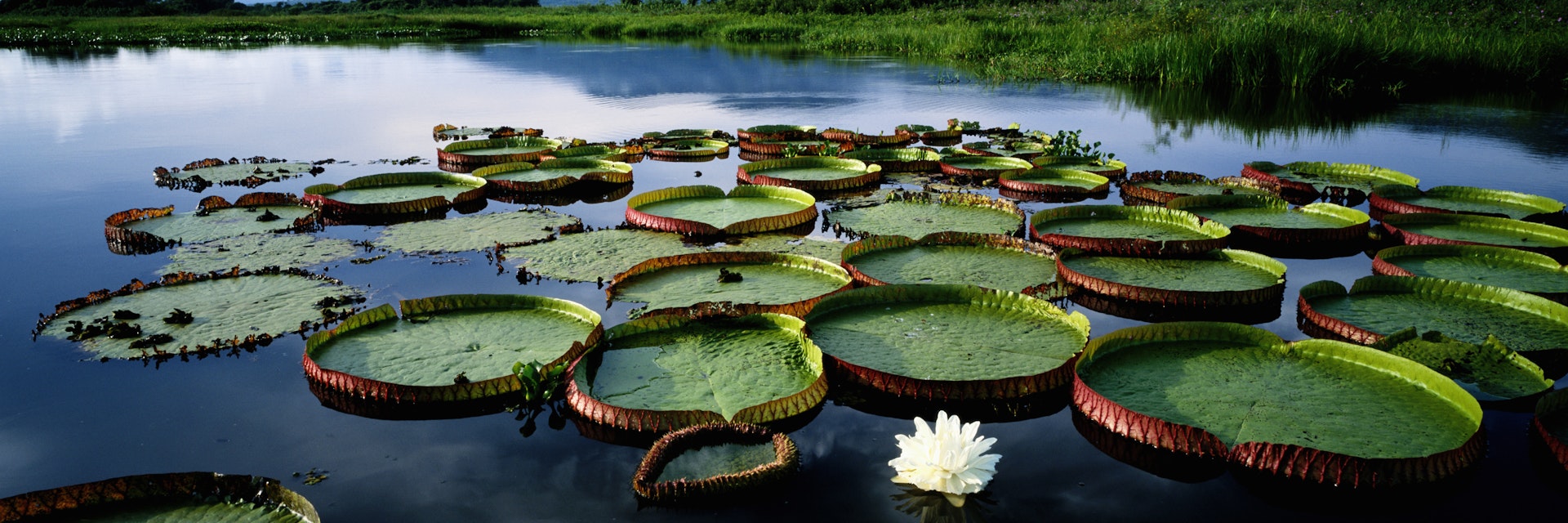
©Nat Photos/Getty Images
One of the world's most captivating places, Brazil is a country of powdery white-sand beaches, verdant rainforests and wild, rhythm-filled metropolises.
Best Time to Visit
Best places to visit, attractions, must-see attractions.
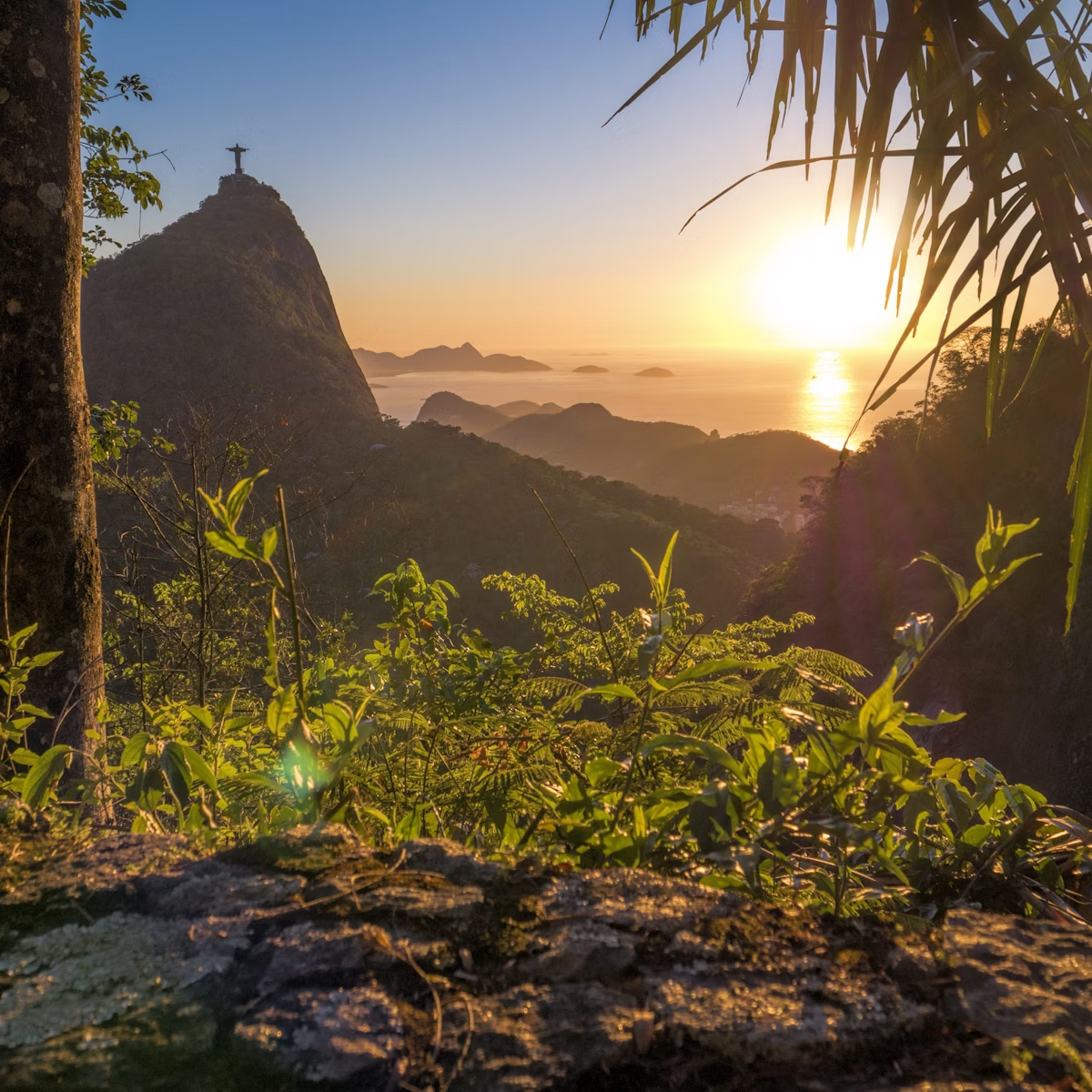
Parque Nacional da Tijuca
Rio de Janeiro
The Tijuca is all that's left of the Atlantic rainforest that once surrounded Rio de Janeiro. This 39-sq-km tropical-jungle preserve is an exuberant green…
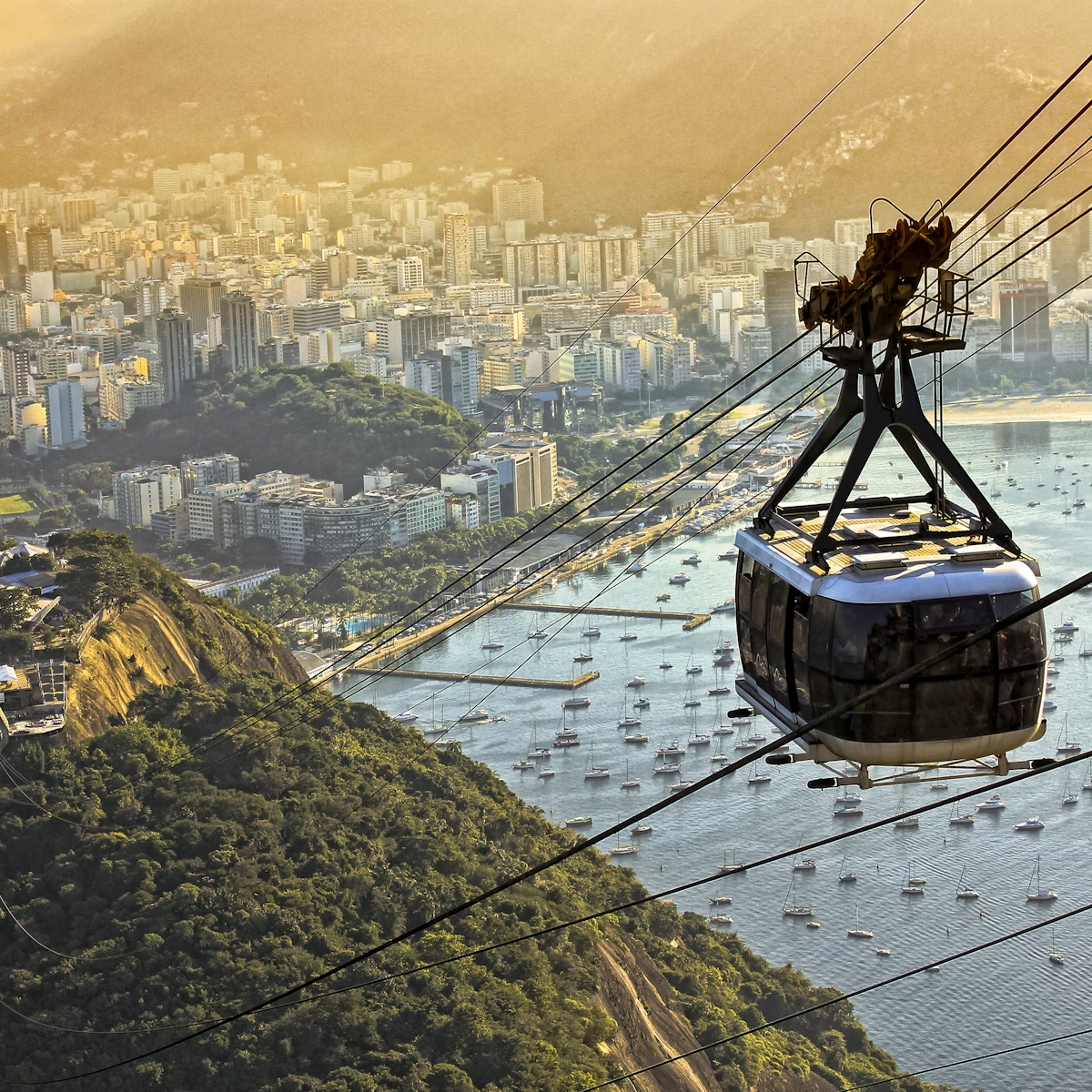
Pão de Açúcar
Seen from the peak of Pão de Açúcar, Rio is undoubtedly a Cidade Maravilhosa (Marvelous City). There are many good times to make the ascent, but sunset on…
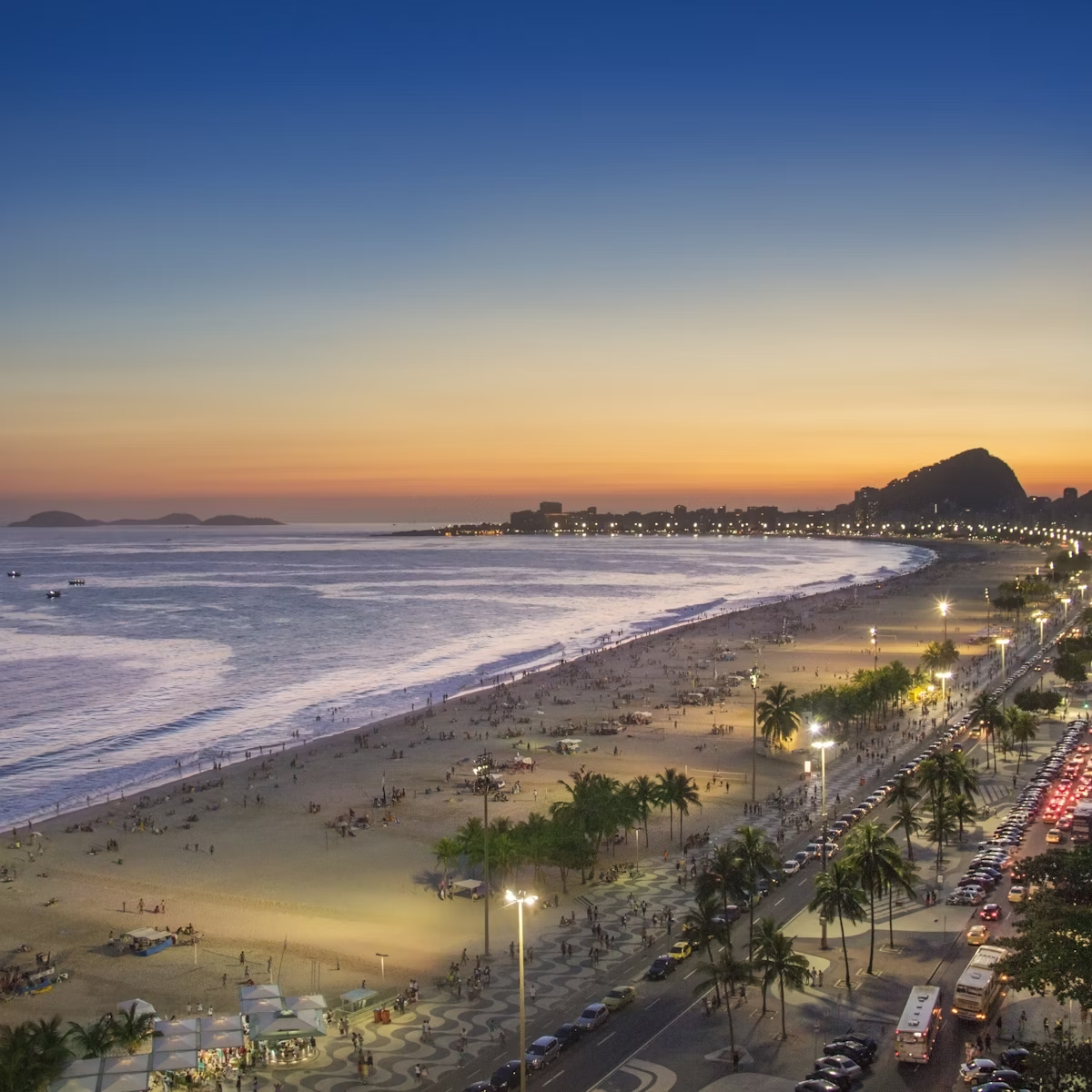
Copacabana Beach
A magnificent confluence of land and sea, the long, scalloped beach of Copacabana extends for some 4km, with a flurry of activity along its length: over…
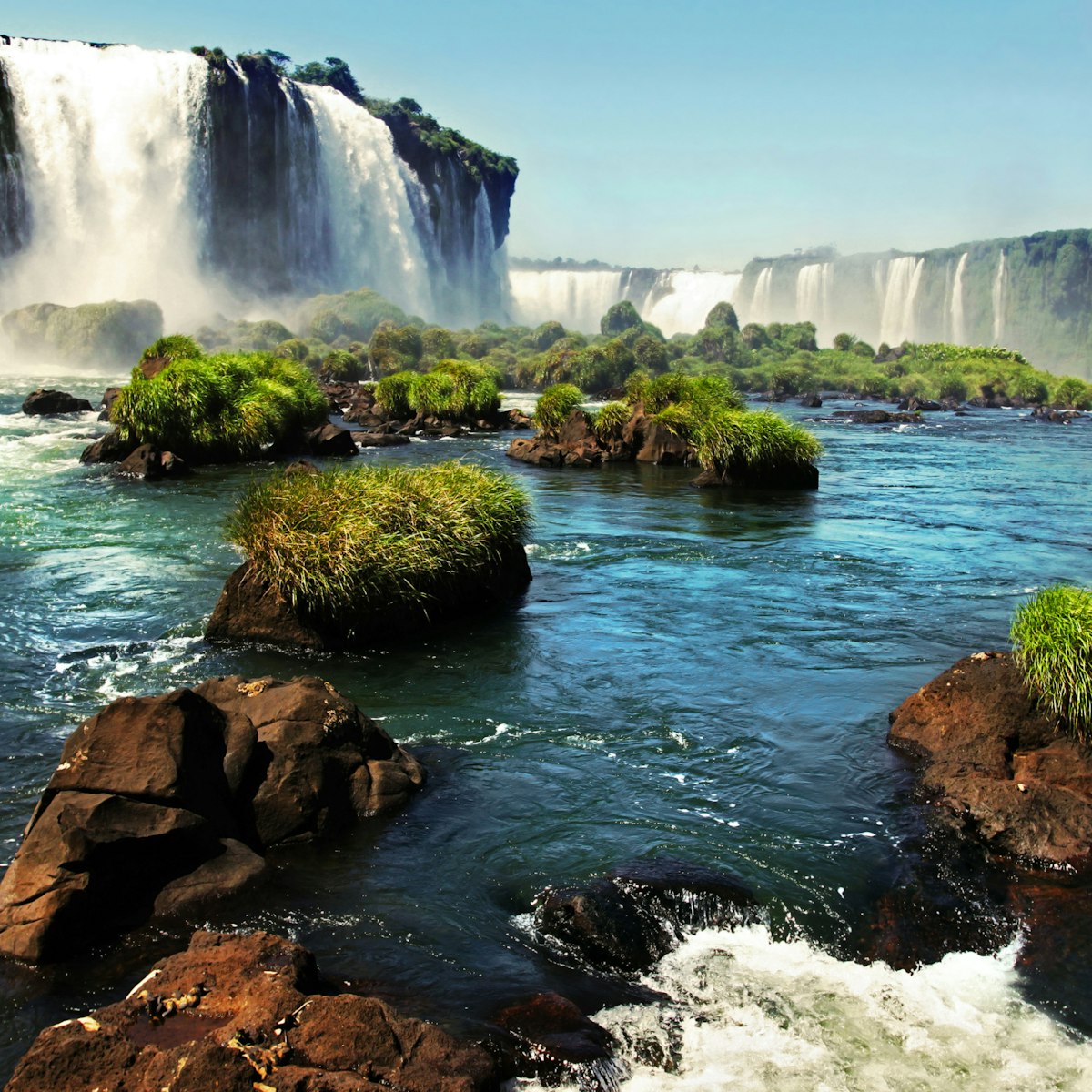
Parque Nacional do Iguaçu
Brazil's second-oldest national park, created in 1939, protects one of South America's most magical and majestic sights, Iguaçu Falls, part of the largest…
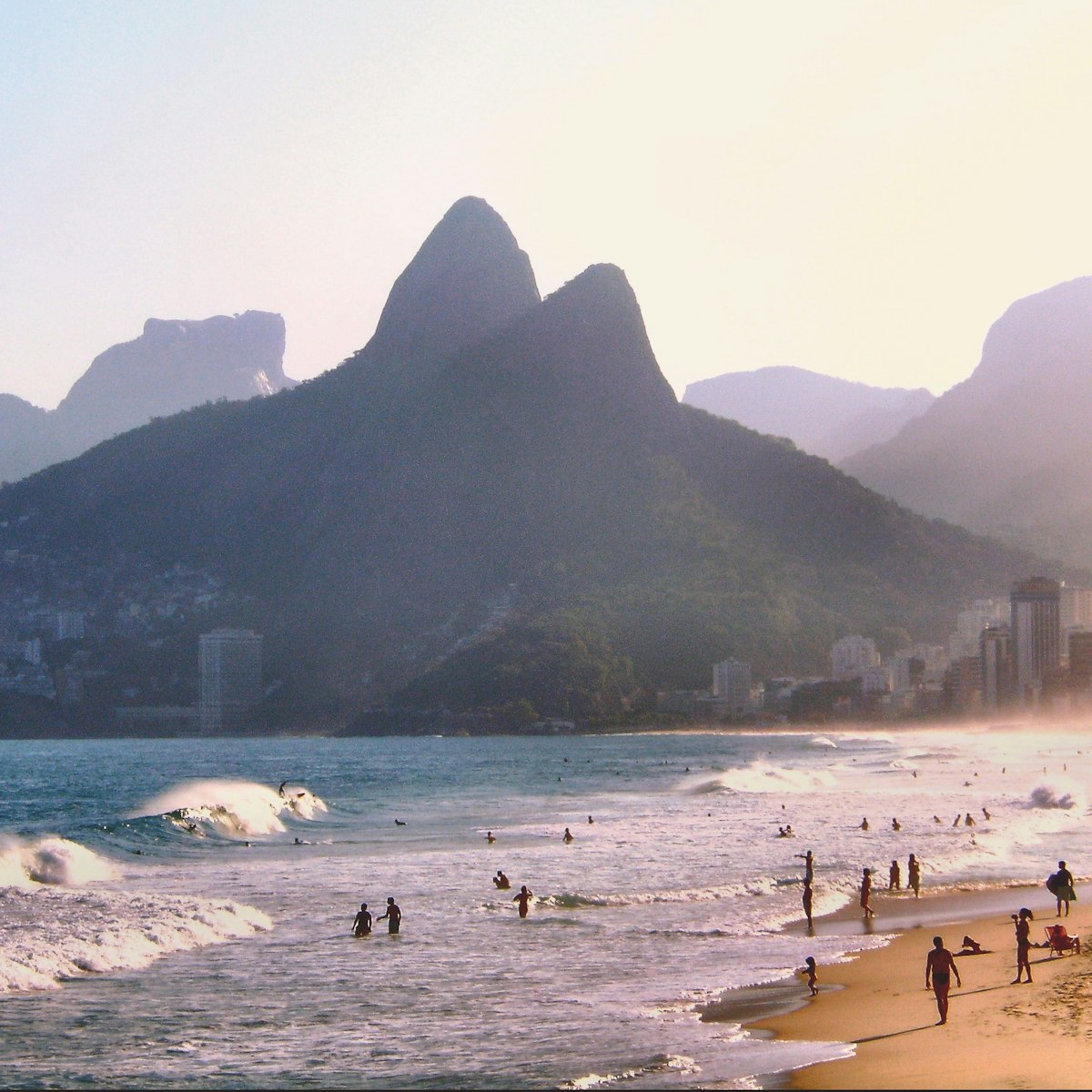
Ipanema Beach
Ipanema & Leblon
One long stretch of sun-drenched sand, Ipanema Beach is demarcated by postos (posts), which mark off subcultures as diverse as the city itself. Posto 9,…
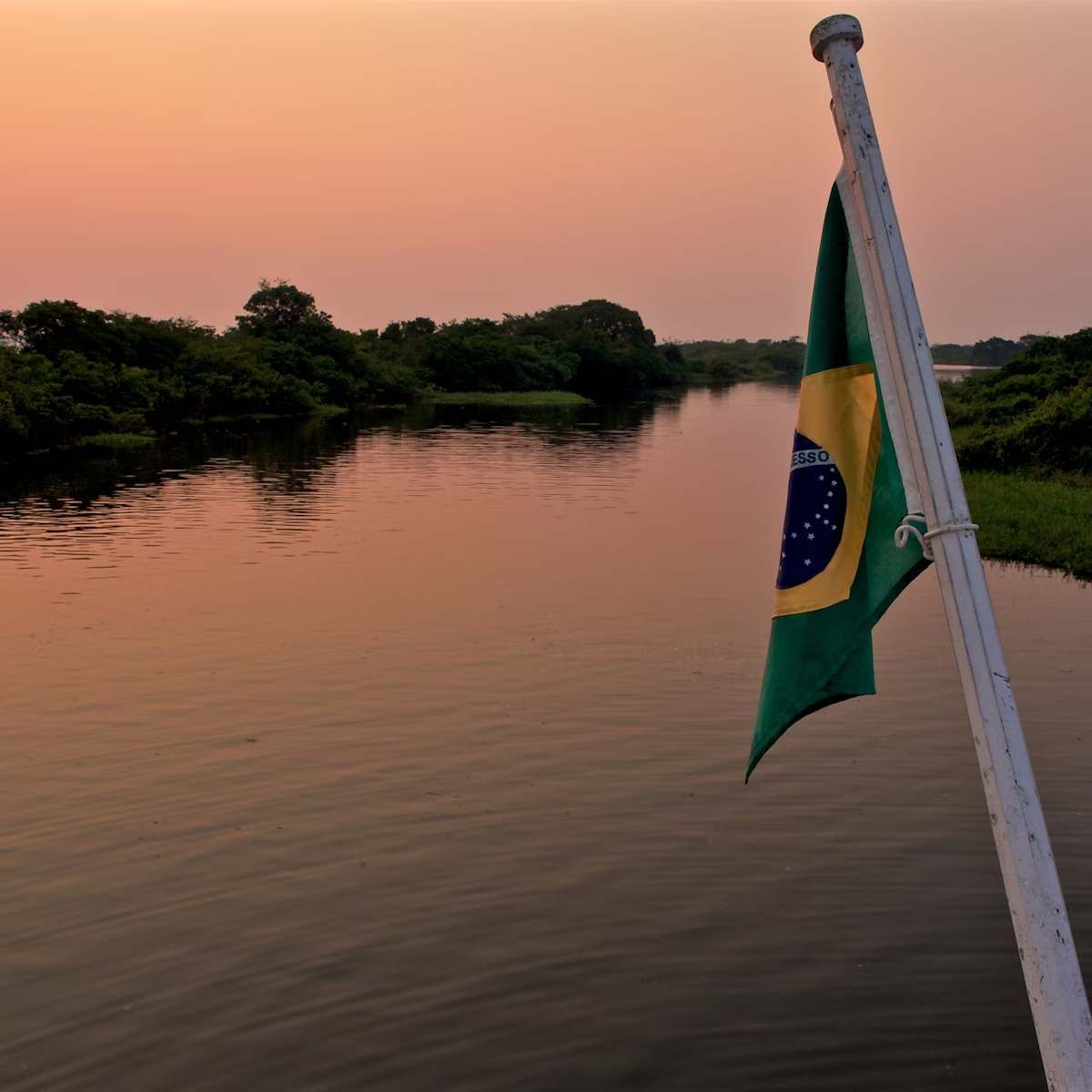
Reserva Extrativista Baixo Rio Branco-Jauaperi
This newly minted extractive reserve is an outstanding place to immerse yourself in the best the Amazon has to offer, with excellent wildlife-watching –…
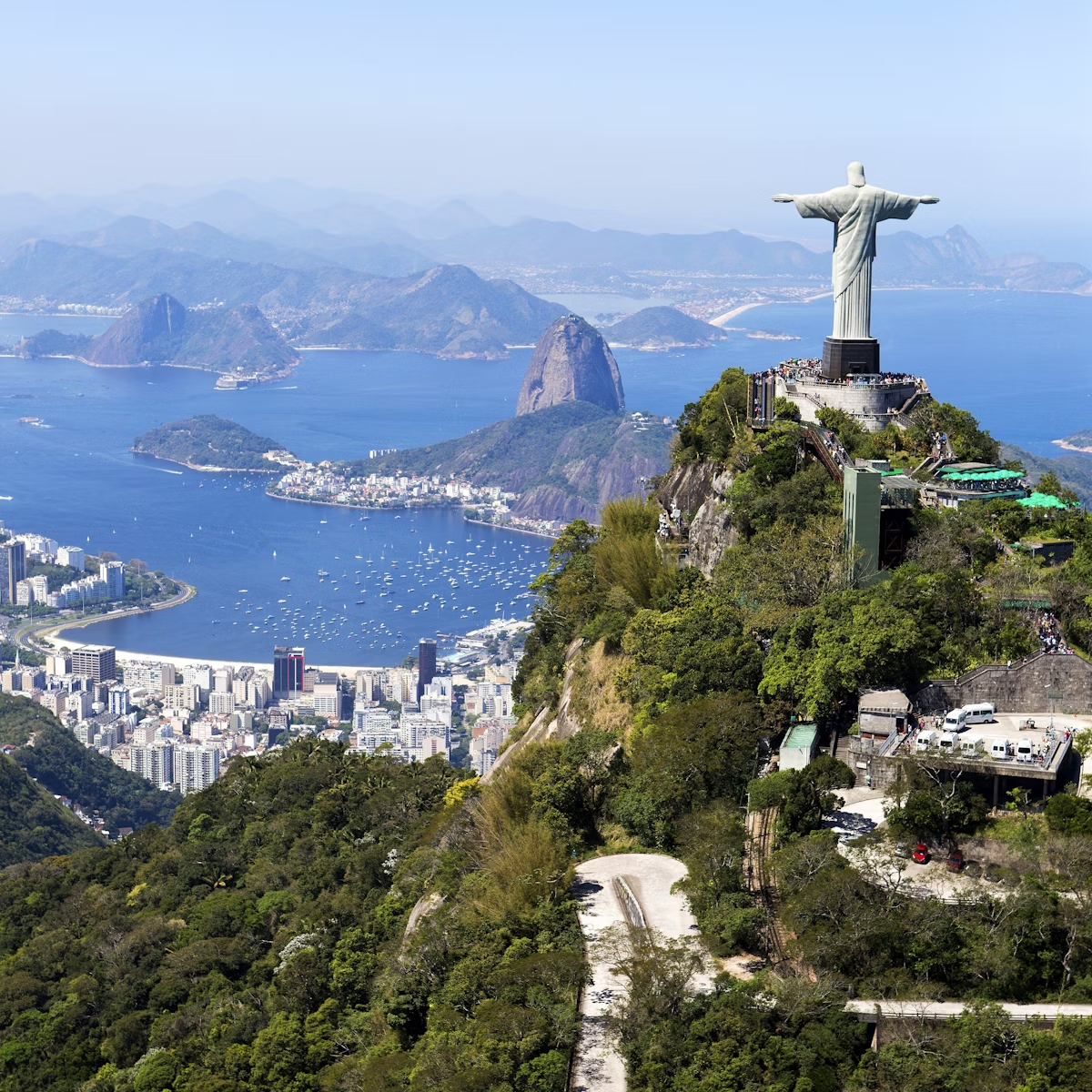
Cristo Redentor
Flamengo & Around
Standing atop Corcovado (which means ‘hunchback’), Cristo Redentor gazes out over Rio, a placid expression on his well-crafted face. The mountain rises…

Parque Nacional da Chapada Diamantina
Spanning over 1520 sq km and containing within it innumerable species of plants and animals, deafening waterfalls and vast, rugged plains, Parque Nacional…
Top picks from our travel experts
15 things to do in brazil that will amaze you.

Parque das Aves
Foz do Iguaçu
This 5-hectare bird park, located 300m from the entrance to Parque Nacional do Iguaçu, is home to 800-plus species of birds, including red ibis, bare…

Museu de Arte de São Paulo
Sampa’s pride, this museum possesses Latin America’s most comprehensive collection of Western art. Hovering above a concrete plaza that turns into an…

Farol das Conchas
Built in 1872 on orders from Dom Pedro II, this lighthouse stands picturesquely atop a hill at the island’s most easterly point. From here you have…

Museu do Futebol
Tucked under the bleachers of colorfully art deco Pacaembu Stadium, this fantastic museum is devoted to Brazil’s greatest passion – football (soccer). Its…

Maracanã Football Stadium
Rio’s Maracanã stadium is hallowed ground among football lovers. The massive arena has been the site of legendary victories and crushing defeats. Maracanã…

The epicenter of Rio’s Carnaval, the Sambódromo was designed by Oscar Niemeyer and completed in 1984. During big parades, come here for fantastic views…

Beco do Batman
One of São Paulo's premiere street-art locations, 'Batman's Alley' has slowly risen from secret location for band promotional shots and Brazilian films to…

Cumbuco, 35km from Fortaleza, has a long wide beach with soft sand, an expanse of dunes and a few lagoons that make it very popular for buggy rides and…

Parque Nacional da Serra da Capivara
One of Brazil's most important national parks, this 1300-sq-km reserve contains more than 40,000 rock paintings among spectacular panoramas of immense…
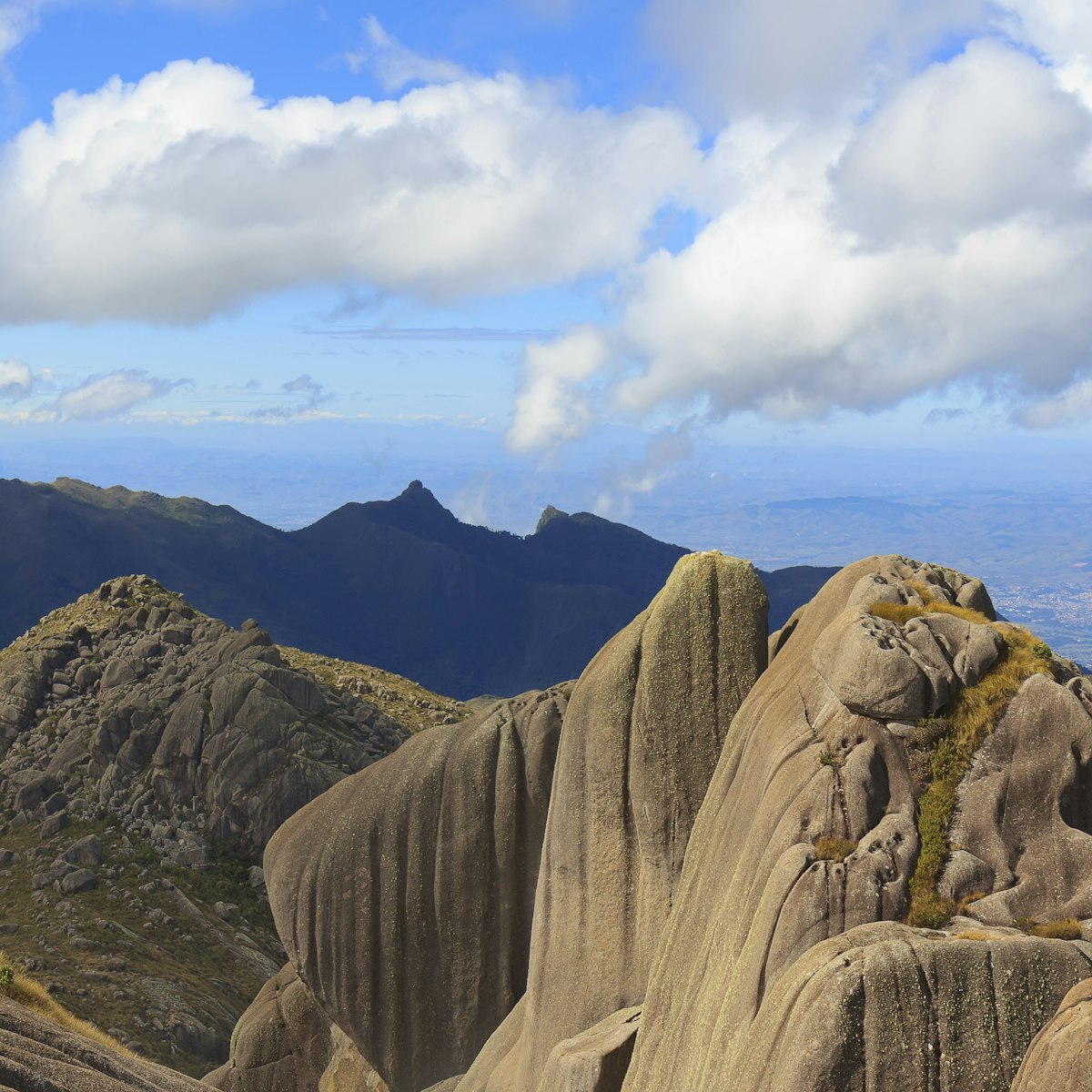
Parque Nacional do Itatiaia
Rio de Janeiro State
Brazil’s oldest national park, Itatiaia shelters a stunning variety of landscapes, from dense rainforests to spare and rugged upland peaks. Most visitors…

Itaipu Binacional
With a capacity of 14 million kilowatts, this binational dam is the world's second-largest hydroelectric power station, and the one that produces the most…
Planning Tools
Expert guidance to help you plan your trip.
Best Things to Do
Whether you prefer magnificent nature or exciting cities, Brazil has an experience lined up for you. Here’s our guide to the top things to do in Brazil.
Things to Know
Visiting a community to better understand the lives of the people who live there – that's the sort of positive impact tourism is supposed to have.
Transportation
Find your way around in Brazil with this guide to the country's transportation.
Visa Requirements
Brazil offers different visas depending on the purpose of travel and country of origin. Here’s everything you need to know about getting a visa for Brazil.
Money and Costs
Everything you need to know to make your money go further in Brazil.
Traveling with Kids
With top tips on safety and places to go, find the perfect activities for all age groups on your family trip to Brazil.
Best Road Trips
From coastal drives to winding mountain roads, getting behind the wheel in Brazil opens up a world of natural wonders. Here are Brazil's best road trips.
Plan with a local
Experience the real Brazil
Let a local expert craft your dream trip.

Latest stories from Brazil
Filter by interest:
- All Interests
- Adventure Travel
- Art & Culture
- Beaches, Coasts & Islands
- Food & Drink

Tips & Advice
Mar 1, 2024 • 9 min read
Don't get overwhelmed by the scale of Brazil – get organized! Here are our top 10 favorite places to visit in this South American sensation.

Dec 2, 2023 • 7 min read

Nov 9, 2023 • 4 min read

Nov 8, 2023 • 5 min read
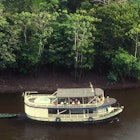
Oct 7, 2023 • 8 min read

Oct 6, 2023 • 4 min read
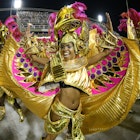
Sep 28, 2023 • 12 min read

Sep 28, 2023 • 3 min read

Sep 20, 2023 • 9 min read
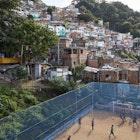
Mar 15, 2023 • 6 min read
in partnership with getyourguide
Book popular activities in Brazil
Brazil and beyond.
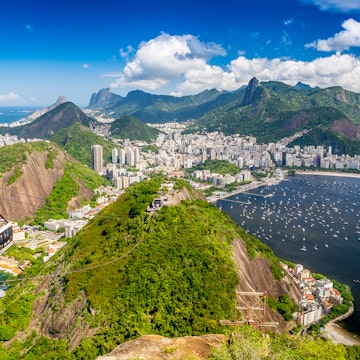

14 Top-Rated Attractions & Things to Do in São Paulo
Written by Barbara Radcliffe Rogers and Michael Law Updated Dec 24, 2023 We may earn a commission from affiliate links ( )
The largest city in South America, São Paulo sits on the Piratininga plateau and is surrounded by rivers that fan out into the interior. Almost from its founding in 1554, São Paulo became the gateway to the sertão (Brazil's backcountry), and explorers known as bandeirantes made expeditions from the city into this region. Today's main highways to interior cities still follow the routes of the bandeirantes.
Immigrants from all over the world have always been a part of São Paulo, and you'll still see the influence of Portuguese, Spanish, German, African, Jewish, Arab, and Japanese residents on its life and culture. There is an entire museum devoted to Japanese immigration, for example, and another to the contributions of Africans in Brazil.
Perhaps the most difficult thing to grasp about the city is its sheer size. A good way to get an idea of how far it spreads is from the observation deck of the 46-story Itália Building on Avenida Ipiranga. Many of São Paulo's tourist attractions are widespread, so you'll find the Metro a good way to travel between them.
Discover the best places to visit in this lively metropolis with our list of the top attractions and things to do in Sao Paulo.
See also: Where to Stay in São Paulo
1. Museu de Arte
2. museo do futebol (football museum), 3. parque do ibirapuera (ibirapuera park), 4. museu de arte contemporânea (contemporary art museum), 5. avenida paulista, 6. parque da independància and museu paulista, 7. sé (cathedral), 8. teatro municipal (city theater), 9. beco do batman (batman alley), 10. pátio do colégio, 11. mosteiro de são bento (benedictine monastery), 12. pinacoteca do estado (art gallery of the state of são paulo), 13. nossa senhora da luz, 14. largo de são francisco, where to stay in são paulo for sightseeing, tips and tours: how to make the most of your visit to são paulo, map of attractions & things to do in são paulo, sao paulo, brazil - climate chart.
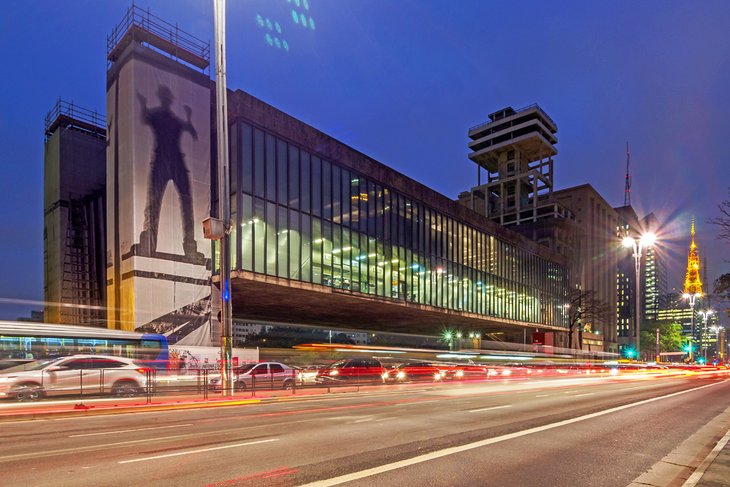
The São Paulo Museum of Art, known locally as MASP, only opened in 1968 but has the most representative and comprehensive collection of western art in Latin America. You'll see works by Impressionists and modern masters - Renoir, Van Gogh, Matisse, Manet, Debret, Picasso, Miró, along with 73 works of bronze sculpture by Degas alone.
Although it reaches back to the Renaissance artists, this is one of the first art museums on the continent to focus on artists of the mid-20th century and later, as well as on contemporary artists in Brazil, including Portinari and Di Cavalcanti. Its outstanding collections put it in the league with the Tate Modern, MoMA, and the Centre Pompidou.
The building itself, designed by Brazilian-Italian architect Lina Bo Bardi, is a classic of Modernism. The plaza under its suspended structure hosts a Sunday antiques market and frequent concerts.
Address: Avenida Paulista 1578, São Paulo
Official site: https://masp.org.br
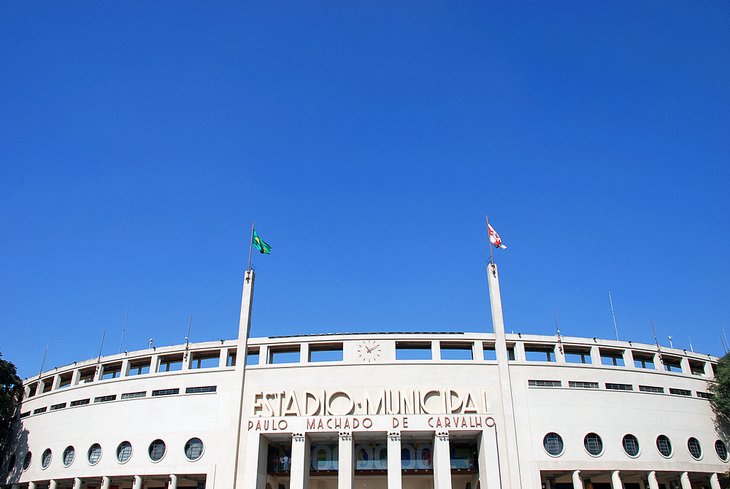
In this football (soccer) mad country, a city like Sao Paulo would be bereft if it didn't have a museum dedicated to the "beautiful game." This fantastic museum provides insight and information on the game and how it occupies a special place in the heart of all Brazilians.
Spread out over 6,000 square meters and 15 galleries are interactive exhibits that are engaging and entertaining. Each gallery focuses on different aspects of the game and the development of sport in Brazil. Jumbo screens mounted on the walls showing famous plays, games, and happenings almost induce a feeling of sensory overload. Other galleries have hundreds of framed photos and other treasured memorabilia.
Think you are a hotshot player? Test your skills by taking a penalty kick against a virtual goalie. The machine will tell you your results, including the speed of the ball. The museum is located at the world famous Pacaembu stadium.
Official site: https://museudofutebol.org.br/en/pagina-inicial-en/
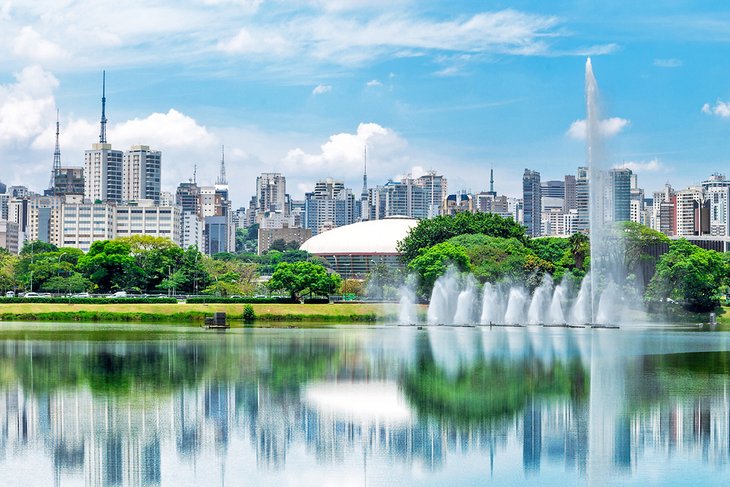
Ibirapuera Park was laid out by landscape architect Roberto Burle Marx, with buildings designed by Oscar Niemeyer. The immense green space with its monuments, museums, playgrounds, gardens, trails, lakes, and performance spaces is a leisure paradise for the people of São Paulo, as well as a showcase of modern architecture and culture. The park is immensely popular, with over 14 million people visiting each year.
Commemorating the pioneers from São Paulo who opened up Brazil's interior, the Bandeiras Monument is a magnificent work by Brazilian sculptor Victor Brecheret, with imposing heroic figures. An obelisk commemorates those who died in 1932 in the struggle for a new constitution.
Auditório Ibirapuera , the ultra-modern music hall designed by Oscar Niemeyer, is considered one of São Paulo's best concert venues. Museu da Aeronáutica e do Folclore , the Aeronautics and Folk Art Museum , displays aircraft models and flight equipment on the ground floor, with nearly 20,000 exhibits devoted to folk art and traditions from all over Brazil filling the remaining floors. The large Museu Afro-Brasil celebrates the contributions of Afro-Brazilians and their social and cultural history.
The Japanese Pavilion dates from 1954 and has exhibits of sculptures, Samurai clothing, pottery, and other treasures. The gardens out front contain volcanic rock from Japan along with a variety of beautiful plants. The fish pond nearby is stocked with colorful carp that are always looking to be fed.
Address: Avenida Pedro Alvares Cabral, São Paulo
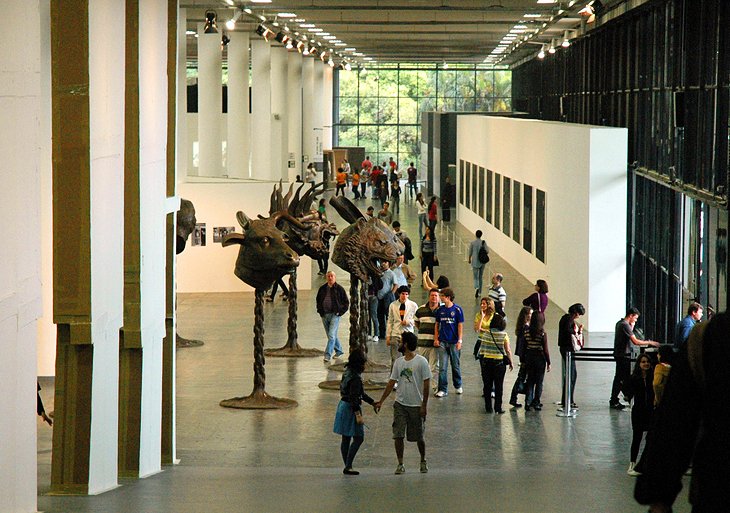
Inside Parque Ibirapuera, the Pavilhão da Bienal de Artes , designed by Oscar Niemeyer and completed in 1957, houses the excellent Museum of Contemporary Art along with special exhibitions and shows. The museum's more than 5,000 pieces represent a wide range of art schools, from Picasso, Modigliani, and Léger to leading Brazilian painters Tarsila do Amaral, Anita Malfatti, Portinari, and Di Cavalcanti.
Among Latin America's largest collections of 20th-century Western art, the museum also displays works by Marc Chagall, Wassily Kandinsky, and Joan Miró. The Sculpture Garden was designed by Roberto Burle Marx and displays 30 large works in an outdoor setting.
Address: Gate 3, Parque Ibirapuera, São Paulo
Official site: http://mam.org.br/
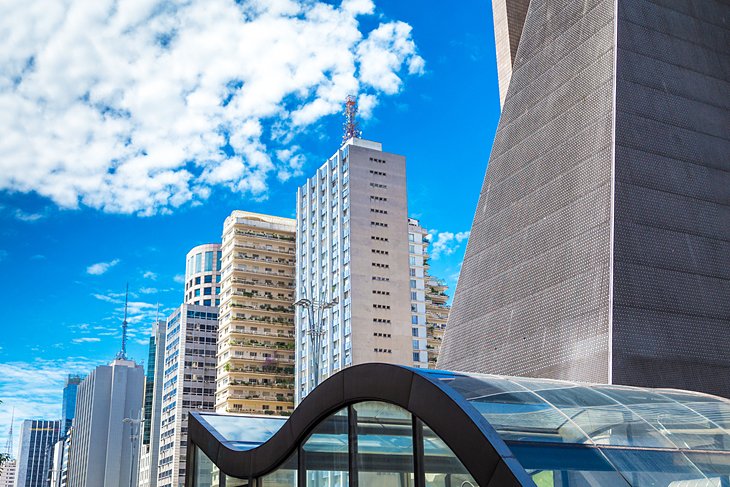
Avenida Paulista is São Paulo's center of activity, full of things to do and a favorite destination for both tourists and locals. This is an ideal spot for people-watching from one of the numerous sidewalk cafes. The area is home to many shops, theaters, galleries, and museums, including the São Paulo Museum of Art (MASP).
Nearby and within walking distance are parks, like Parque Trianon, which provides a foliage-dense oasis right in the city center. This main avenue hosts numerous festivals and celebrations throughout the year, often closing to traffic to become a pedestrian mall.
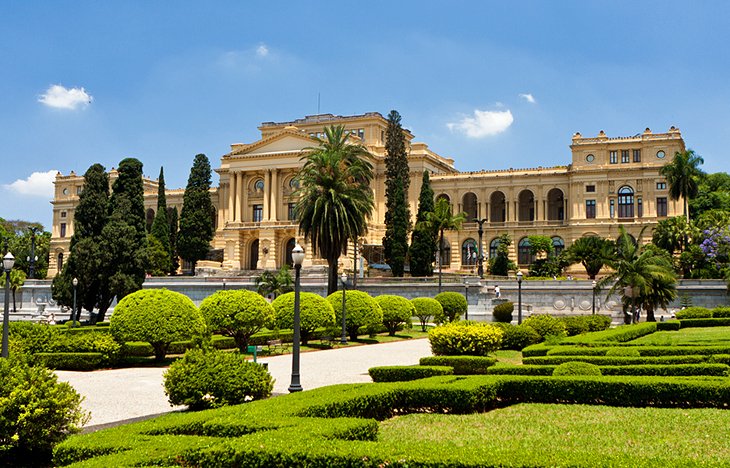
In São Paulo's Ipiranga district, traversed by the stream alongside which the independence of Brazil was proclaimed by Prince Pedro, Independence Park commemorates that 1822 event. Overlooking the formal gardens of roses, topiaries, and fountains inspired by those at Versailles, is the Museu Paulista, more commonly known as the Museu do Ipiranga.
Its Italian architect, Tommaso Gaudenzio Bezzi, created an eclectic design modeled on Italian Neoclassicism, reminiscent of Renaissance palaces. Inside are large collections of costumes, decorative arts, paintings, and furniture of the Imperial Period.
Address: Parque da Independência, Ipiranga, São Paulo
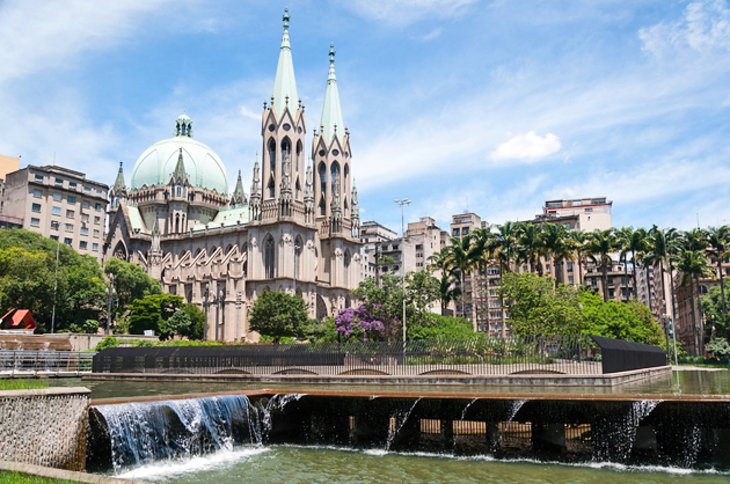
The neo-Gothic cathedral was built on the site of an earlier cathedral and took from 1913 to 1967 to complete. Its building was interrupted by two world wars, which made it difficult to get the mosaics and other decorative elements from Italy. It was consecrated in 1954, on the 400th anniversary of the foundation of São Paulo.
On the façade are statues of Old Testament prophets and Christ's disciples. Although the rest of the church is neo-Gothic, it is capped by a Renaissance-style dome. The interior has several interesting features, including the 10,000-pipe organ and stained glass windows picturing the history of Catholicism in Brazil.
Be sure to notice the capitals on the columns, carved to represent Brazilian flora (branches of coffee and pineapples) and fauna, including armadillos. You can tour the crypt below the main church to see marble sculptures and tombs. The cathedral sits at the historic center of São Paulo, and is a good place to begin a walking tour of the old town.
Address: Praça da Sé, São Paulo
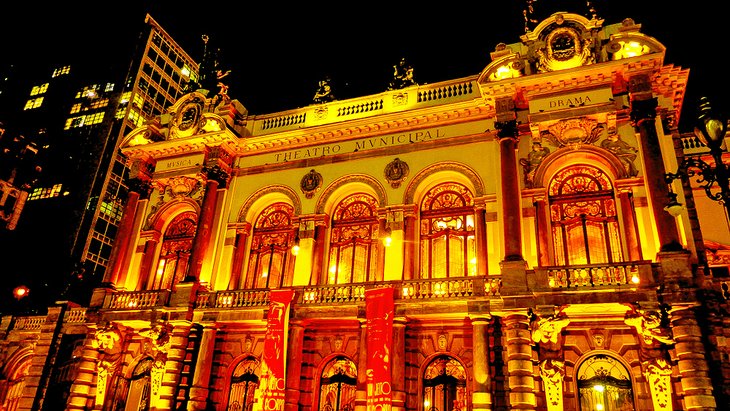
Architect Ramos de Azevedo modeled São Paulo's Municipal Theater after the Paris Opéra, drawing on an eclectic mixture of Art Nouveau and Italian Renaissance themes. Almost immediately after its completion in 1911, it became a major city attraction. This status was enhanced in 1922, when it was the venue for a landmark event that revolutionized the arts in Brazil.
The Week of Modern Art introduced and spotlighted artists who were to become icons of the Brazilian Modernist Movement, celebrated names including painters Emiliano Di Cavalcanti, Tarsila do Amaral, Anita Malfatti, and Menotti Del Picchia; composer Heitor Villa-Lobos; playwright Mário de Andrade; and sculptor Victor Brecheret.
A major center for the performing arts in South America, the theater has hosted performances by internationally renowned singers, dancers, musicians, and performing artists that have included Carla Fracci, Rudolf Nureyev, Titta Ruffo, Enrico Caruso, Maria Callas, Arturo Toscanini, Heitor Villa-Lobos, and Mikhail Baryshnikov.
The building was completely restored to its original grandeur and re-opened in 1991. It is home to the São Paulo Symphony Orchestra, the Coral Lírico (Lyric Choir), and the City Ballet of São Paulo.
Address: Praça Ramos de Azevedo, São Paulo
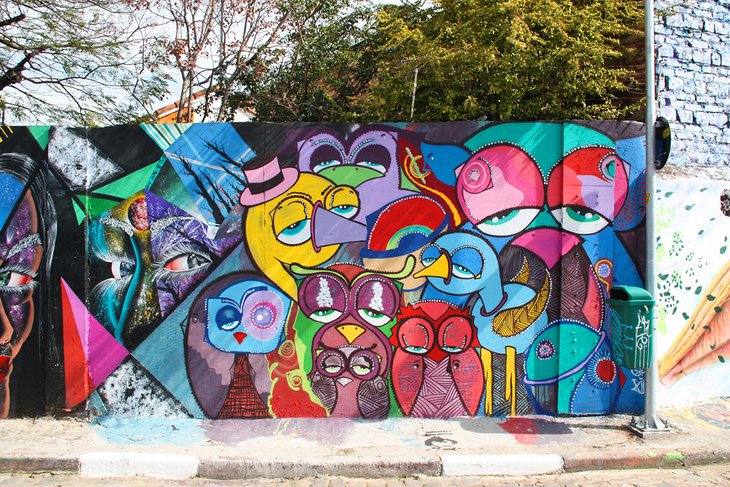
If you find yourself in the Vila Madalena neighborhood, Beco do Batman is a wild and colorful spot located between Gonçalo Afonso Street and Medeiros de Albuquerque Street. Since the 1980s, spray paint artists have been showcasing their innovative work on the walls.
The artwork is continually changing, and the creative murals make for colorful photos. There is even a good chance you'll see an artist or two at work when you visit.
If you are interested in meeting some of the artists and having your very own photo shoot with a professional photographer who will take your picture against the colorful murals, consider taking a tour. The Photoshoot of Batman's Alley includes 100 photos of you, with the results curated in Photoshop and sent to you digitally in 24 hours.
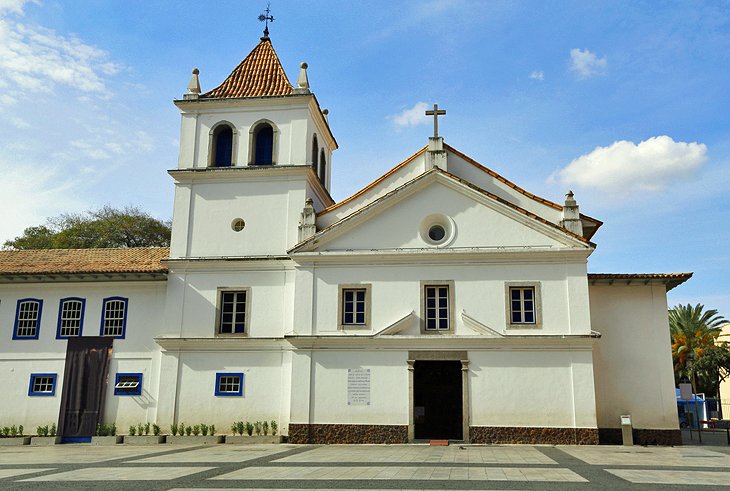
The square known as Pátio do Colégio, immediately north of Praça da Sé and the cathedral, is the original nucleus of São Paulo. Here, Manuel de Nóbrega and José de Anchieta founded the College of the Society of Jesus, a residence and center of study for Jesuits, and here on January 25, 1554, the first mass in the settlement was celebrated.
The attractive plaza is now occupied by the Historical Museum, a museum of sacred art, and the Capela de Anchieta. All that remains of the 16th-century building are the doors and a stretch of clay wall. In the gardens of the museum is a pleasant café.
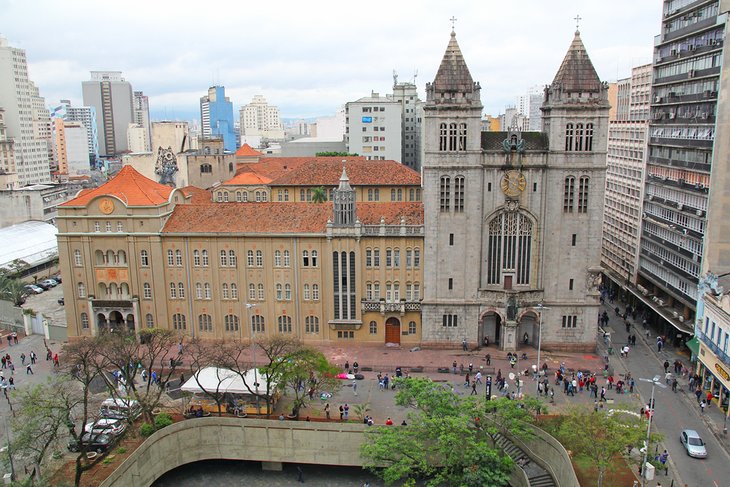
The Benedictine monastery and its church were founded in the late 16th century, but the current church dates only from 1910-22. Don't discount it for its modern origin or its rather austere exterior, as the interior is richly painted and includes 17th-century statues of St. Benedict and St. Scholastica carved by Agostinho de Jesus.
A number of other notable Benedictine artists contributed to the decoration of the monastery. Also notable are some impressive stained glass, an image of the Virgin in a robe set with pearls, and a crucifix dating to 1777. This is an active brotherhood, and the monks accompany the morning mass with Gregorian chants. Stop in the monastery shop to buy cakes, breads, and chocolates made by the brothers.
Address: Largo de São Bento, São Paulo
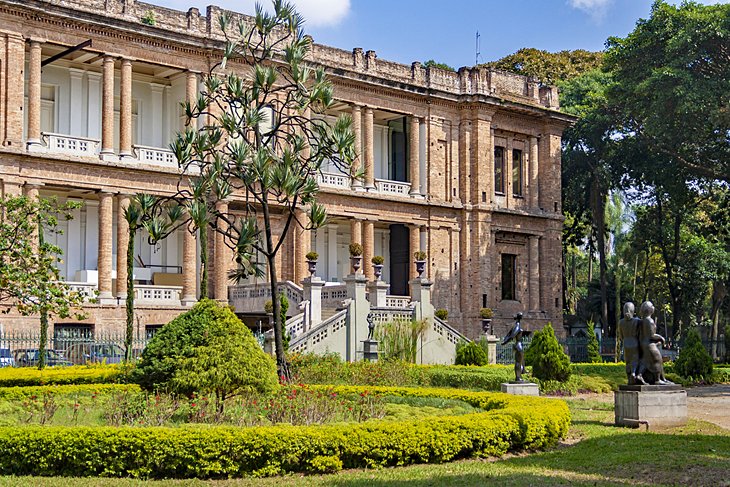
This museum is the oldest in São Paulo, opened in 1905 to showcase the works of Brazilian artists. Its 10,000 works of art include drawings, paintings, and sculpture from the 1800s through the present. Housed in the restored Liceu de Artes e Ofícios building, the architecture itself is a reason to visit.
Part of the collection is housed in the museum's second location at Pina Estação where visitors will find a memorial to the São Paulo Resistance, an extensive library of historic documents related to Brazil's political struggles, and many more examples of Brazilian art.
Address: Praça da Luz, 2, São Paulo
Official site: https://pinacoteca.org.br/en/
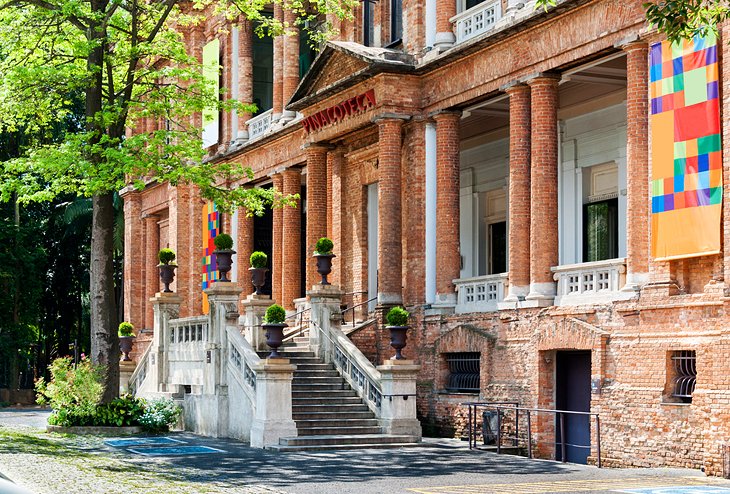
On Avenida Tiradentes, which skirts the Parque da Luz, are the convent and church of Nossa Senhora da Luz, typical examples of the traditional architecture of São Paulo: in spite of their fairly recent age – they were built in the 18th century – they are constructed entirely of clay.
The Nossa Senhora da Luz convent now houses a Museum of Sacred Art, which has a large collection of about 11,000 items, including statues, pictures, altarpieces, and furniture from the 16th through 19th centuries. Also on Praça Tiradentes is the Pinacoteca do Estado, the State Picture Gallery, the oldest museum in São Paulo. It contains about 2,500 pictures, drawings, and prints, mainly by Brazilian artists.
Address: Praça da Luz, São Paulo
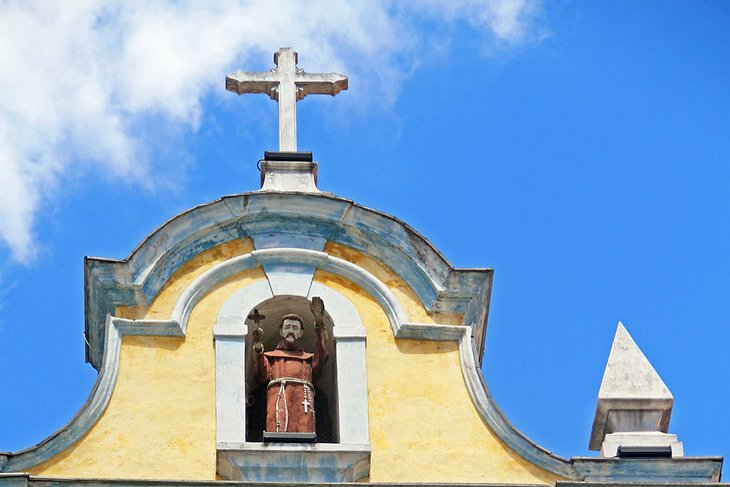
To the west of the cathedral and the Pátio do Colégio, Largo de São Francisco is a street in the city center named for the monastic complex that faces it. The Igreja de São Francisco de Assis, the church of St. Francis, was built in 1644 and is one of the city's oldest surviving churches. Its interior is clearly based on those of Portugal in that period, with a cheerful, airy feel and plentiful gold flourishes.
It was restored after a fire in 1870 and again more recently. Not so the neighboring church of the Ordem Terceira de São Francisco, the Third (lay) Franciscan Order, built from 1676 to 1791 and so seriously showing its age that it is closed to visitors. The third building in the complex, the Franciscan friary, has been occupied since 1828 by the Law Faculty of São Paulo University. The neighborhood is a little run down and is not a place to visit at night.
Address: Rua Borges Lagoa, São Paulo
Unlike many large cities, where most of the main attractions are clustered near the historic old town, São Paulo's are spread across the city. Luckily for tourists, a good Metro system brings all the sites within easy reach. It's best to choose a location in the Paulista neighborhood, close to the São Paulo Museum of Art or south of it, near Ibirapuera Park, where several other attractions are located. Here are some highly-rated hotels in this area of São Paulo:
Luxury Hotels :
- Several top hotels in the Paulista area surround the São Paulo Museum of Art, close to restaurants and shopping. Renaissance Sao Paulo Hotel has a pool and good city views from the upper floors, while InterContinental Sao Paulo offers a large fitness center along with a pool. Some rooms have balconies.
- At the edge of Paulista, a few blocks from Ibirapuera Park, Marriott Executive Apartments also has several good restaurants within walking distance.
Mid-Range Hotels:
- Close to the Trianon metro station and Museum of Art, the quiet Royal Boutique Jardins Hotel is near the public gardens.
- Still in Paulista, but only a short walk to Ibirapuera Park and its museums, the 154-room Mercure Sao Paulo Paulista is well worth a look.
Budget Hotels:
- Although it is right in the center of the busy Paulista shopping and restaurant neighborhood, rooms are quiet at Ibis Paulista .
- Melia Paulista is directly across from the Trianon metro station, and the airport bus stop is a block away.
- Also near the art museum, shopping center, and dining, Intercity Paulista has a sauna, fitness room, and small pool.
- Sightseeing Tours : Visitors can see many of the top tourist attractions on the three-hour City Tour of São Paulo , which begins at the P acaembu Football Stadium and includes tours of several significant neighborhoods. Highlights include the Museu de Arte (MASP) in the Paulista neighborhood and the Municipal Theater and Pátio do Colégio in downtown São Paulo. The tour also visits Sé Square and its historic cathedral, as well as several public squares and historic monuments, including the stunning Ibirapuera Park .
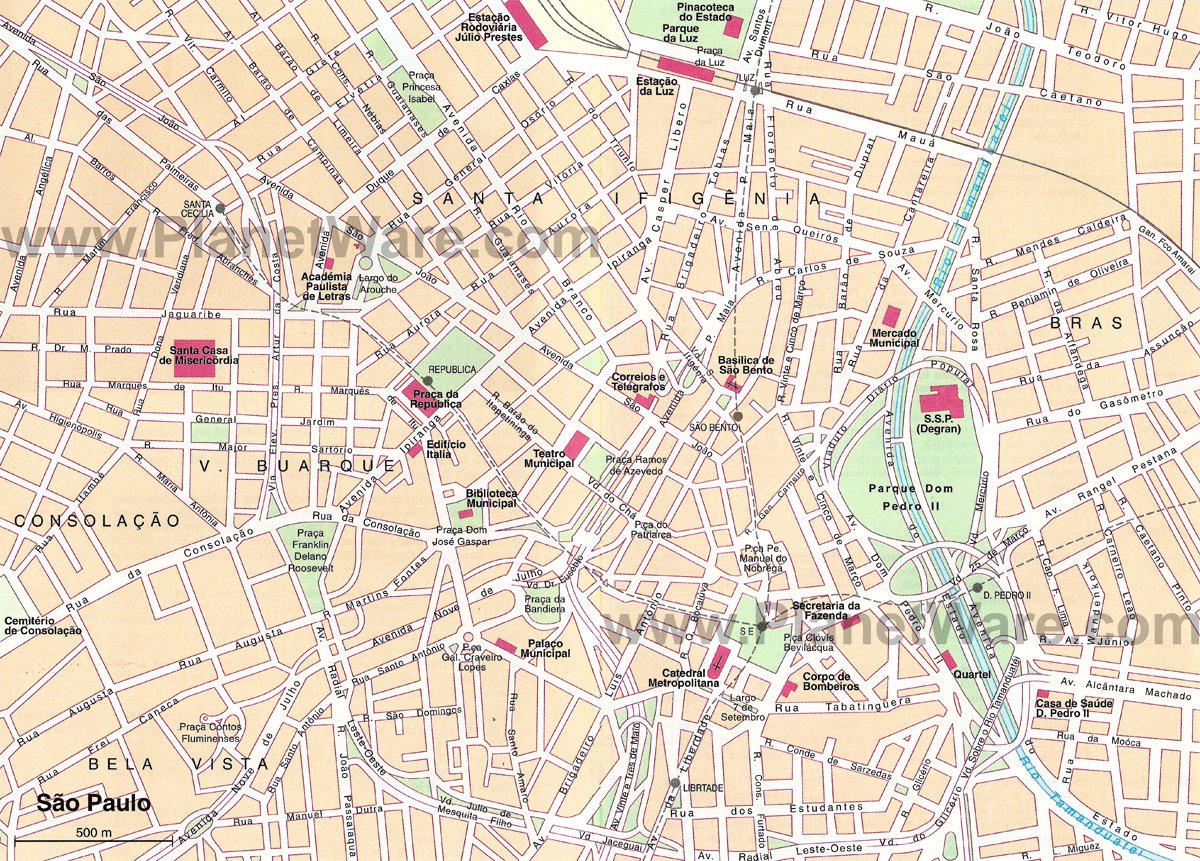
More on Brazil
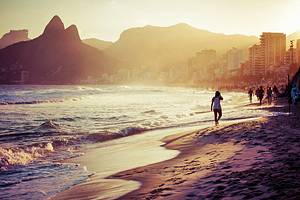

Small Towns, Big Impact: 10 Examples Of Sustainable Tourism in Picturesque Locations
- Small towns like Giethoorn, Hallstatt, and Cinque Terre showcase sustainable tourism practices with car-free streets, eco-friendly transportation, and a focus on waste management, preserving natural beauty while promoting responsible travel.
- Travelers can appreciate the commitment to sustainability in towns like Sintra, Gimmelwald, and Bled, where eco-friendly transportation, regional products, and conservation efforts ensure a minimal impact on the environment and support local communities.
- Tasiilaq and Portree exemplify sustainable living with self-sufficiency, renewable energy sources, traditional practices, and preservation of cultural heritage, setting a standard for eco-conscious practices and responsible exploration.
Sustainable tourism has never been so discussed, and people have been significantly seeking trips that support sustainable tourism . Luckily, many small towns are committed to sustainability , promoting responsible travel practices that respect local communities, protect fragile ecosystems, and preserve cultural heritage.
When it comes to eco-friendly tourism, small towns have a lot to teach the world. From car-free streets and efficient public transportation to encouraging local producers, these places prove that finding a balance between tourism and preservation is possible.
Embracing sustainable tourism is an ethical choice and a crucial step towards ensuring a harmonious coexistence between humans and the environment, forging a path to a more balanced and resilient world. Here are 10 examples of sustainable tourism in some of the world's most scenic towns.
RELATED: Here Are 10 Ways You Can Be Eco-Minded When Visiting National Parks Sustainably
Giethoorn, The Netherlands
Giethoorn, often called the "Venice of the North," is a picturesque village in the Netherlands. The only way to navigate this town where cars aren't allowed is by bike, boat, or foot.
Giethoorn stands out as a model of sustainable tourism, promoting eco-friendly practices such as electric boat transportation and maintaining a car-free town center. This commitment to preserving its idyllic waterways and natural surroundings has earned Giethoorn a reputation as a leading example of how tourism and environmental conservation coexist.
Visitors can explore this tranquil village while appreciating its dedication to sustainability.
- Population: 2,135
There are no train stations in Giethoorn , and the closest station is located in Steenwijk, where travelers can get a bus or rent a bike.
Hallstatt, Austria
Travelers spending the weekend in Hallstatt , Austria, will discover more than a breathtaking Alpine scenery, but a place committed to sustainability.
This village has implemented various eco-friendly initiatives, such as restricting car access in the center during the daytime. It's a way to encourage cycling and promote renewable energy sources.
Additionally, Hallstatt emphasizes waste management and conservation of its pristine environment. Visitors can explore the village's stunning lakeside setting and charming architecture while appreciating its dedication to preserving natural beauty for generations to come.
- Population: 734
Cinque Terre, Italy
Cinque Terre is arguably Italy's most stunning coastal area . Despite its popularity and increasing number of tourists, the country created rules to mitigate the environmental impact. Initiatives focus on waste management, protecting the marine environment, and educating both residents and visitors about sustainable practices.
The use of cars is limited, with an efficient train system connecting the villages. Businesses focus on sustainability, promoting local products like wine producers , farmers, and fishermen.
- Population: 3,500
Sintra, Portugal
Sintra is a lovely town in Portugal where travelers can spend at least two days . It attracts visitors due to its colorful constructions and history heritage, as it's a UNESCO World Heritage site.
When visiting, many travelers might not be aware of Portugal's efforts to make it a sustainable destination, as it ranks among the world's 100 Green Destinations . The town promotes eco-friendly transportation and encourages visitors to explore on foot or via electric trams, and strict zoning laws prevent overdevelopment, ensuring the historic charm remains intact.
Local businesses emphasize regional products, reducing the carbon footprint. Efforts are made to manage waste effectively, and conservation programs protect the lush surrounding forests.
- Sustainable accommodations: Penha Longa , Rosegarden House
RELATED: 10 Countries In Europe Perfect For Sustainable Tourism
Gimmelwald, Switzerland
Gimmelwals is located 300 meters above sea level, and its small-scale tourism bolsters the local economy and fosters a sense of community. Tourism became possible by creating an efficient local train and cable car. Nestled in the Swiss Alps, the villages in this region are entirely car-free , which helps to preserve the clean mountain air.
Hiking trails lead through pristine landscapes, and traditional wooden chalets seamlessly blend with the scenery. Locally-owned accommodations and eateries prioritize regional fare, reducing food miles.
- Population: 130
- Sustainable accommodations: Pension Gimmelwald , Mountain Hostel Gimmelwald
Bled, Slovenia
Bled, Slovenia, has been committed to sustainable tourism for many years. It also ranks among the Top 100 Sustainable Destinations thanks to initiatives such as efficient public transportation, allowing travelers to leave their cars behind.
Some areas in the city have walking-only areas so people won't damage the site. The pristine Lake Bled is central to the community's commitment to conservation, with electric boats available, leaving no environmental footprint.
Bled's compact size encourages exploration on foot or by bike, minimizing reliance on motorized transportation. Additionally, efforts to preserve cultural heritage and support the local economy further contribute to its sustainable ethos.
- Sustainable accommodations: Hotel & Glamping RIBNO Bled
Jalapão, Brazil
Located in the heart of Brazil, Jalapão has been recently discovered by the tourism hub. This paradise is home to South America's largest savanna, waterfalls, vast fields of golden grass, dunes, and natural water springs where it's impossible to sink.
The best thing about Jalapão is that locals run tourism, including tourism agencies, hotels, and restaurants in local communities. The locals are committed to preserving the fragile ecosystem, and it's forbidden to use sunscreen when entering the natural water springs as it can affect the fish.
- Recommended agency: Jalapão Brasil
Portree, Scotland
Portree is a coastal town that thrives on renewable energy sources, harnessing wind and water power. Locals are also committed to sustainability and are familiar with eco-conscious practices, from recycling initiatives to community gardens.
Portree's compact layout encourages walking or cycling, reducing car needs. The town's rich Gaelic heritage is preserved through cultural events and initiatives.
Accommodations often prioritize energy efficiency and local sourcing. By harmonizing with its breathtaking natural surroundings, Portree showcases a model of sustainability for small communities worldwide.
- Sustainable accommodations: Skeabost Country House Hotel
Tasiilaq, Greenland
Tasiilaq, Greenland, is home to several Viking settlements , and it's a beacon of sustainable living in the Arctic. With a mere 2,000 residents, this remote town champions self-sufficiency. Energy is primarily sourced from renewable hydroelectric power, minimizing reliance on fossil fuels.
Locals engage in traditional hunting and fishing practices, respecting ecological balance. The Visit Greenland's website highlights the country has been recognized as an "Eco-tourism and Responsible Travel Destination."
- Sustainable accommodations: The Red House
RELATED: Eco-Tourism For Dummies: 10 Ways To Get Involved With Sustainable Missions While Traveling Abroad
Tahoma, California ( Vikingsholm)
Nestled in the picturesque town of Tahoma, Vikingsholm, located on the shores of Lake Tahoe, California, embraces the historic Scandinavian-style mansion and showcases early 20th-century architectural brilliance while prioritizing eco-conscious practices. Surrounded by the Emerald Bay State Park, it encourages responsible exploration and education on local flora and fauna. Visitors can access the site through emission-reducing shuttle services, minimizing individual carbon footprints. Vikingsholm serves as a testament to preserving natural beauty while offering a glimpse into the past.
They encourage visitors to take the Traveler Responsibility Pledge .


Touropia Travel
Discover the World
23 Top Tourist Attractions in Sao Paulo
By Alex Schultz · Last updated on May 4, 2024
As it is the largest metropolis in the Americas, Sao Paulo offers an intense cultural experience. Tropical plants, charismatic people, and lively, bright colors, sounds and scents surround every traveler here, from the moment they step from the plane.
A concrete jungle punctuated by picturesque parks, the sprawling Sampa is the commercial, cultural, and culinary capital of the country. It is a melting pot city, and has large, integrated populations of Italian and Japanese cultures among others. This fusion of culture has created beautiful combination art, culinary scene, and music that are well worth exploring.
Along and around Avenida Paulista, its main thoroughfare, are tons of tourist attractions with terrific shops and top cultural institutions like MASP to explore.
With famous football teams and world-class concerts to watch, there are always exciting and new things to do in Sao Paulo. Often overshadowed by other cities in Brazil, Sao Paulo’s thriving cultural scene, pounding nightlife, and the range of international cuisine available make it well worth a visit.
23. Independence Park
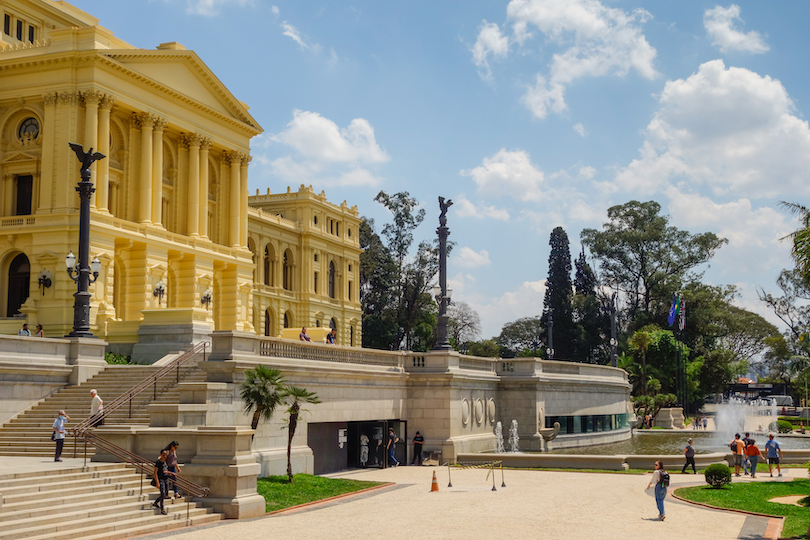
Home to some of the most important monuments and museums in Sao Paulo, Independence Park lies just a short public transport journey southeast of the center. One of the largest green spaces in the city, it has lots of lush, landscaped gardens to wander around.
Remarkably enough, it was along the park’s small stream that Brazil’s independence was proclaimed by Prince Pedro in 1822. A marvelous monument adorned with dozens of sculptures and bas-reliefs now commemorates this auspicious event. These depict key moments and figures from the country’s history with the later emperor and his wives being buried in a crypt below all the dramatic scenes.
To learn more about Brazil’s fascinating past, head to the excellent Ipiranga Museum in the park. Its Eclectic-style palace houses all kinds of artifacts and exhibits, furniture, and photos, mainly relating to its empire. The highlight though is definitely its Independence or Death painted by Pedro Americo.
22. Batman Alley
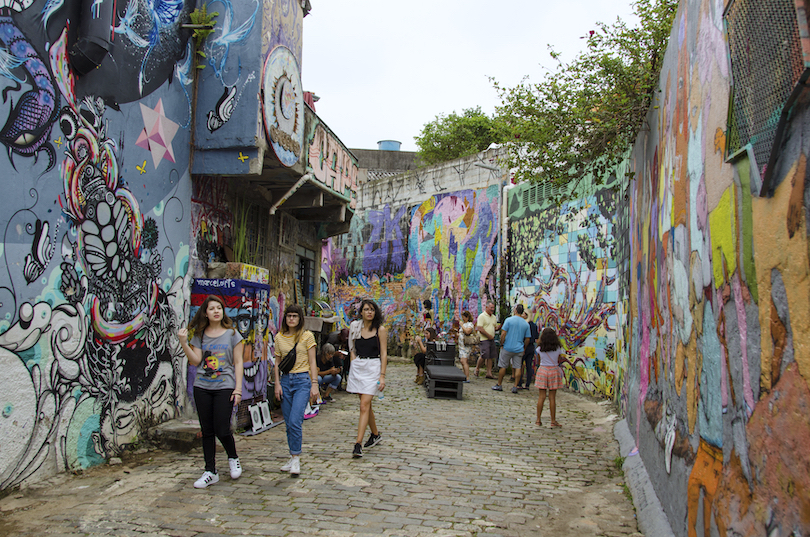
While the city, country, and even continent as a whole is known for its awesome street art, the best place to visit in Sampa for it is certainly Batman Alley. Named after an early piece of artwork that is now long gone, its many colourful, creative murals are ever-changing.
Located in Vila Madalena, Beco do Batman (as it is called in Portuguese) formerly contained a rather sweet mural of the fierce crime fighter hugging world-famous football legend Pele. Long since spray painted over, the alley feels like an open-air gallery with new works displayed all the time. Expect to see everything from brightly-colored animals and flowers to social commentary, lucid scenes, and of course comic book heroes.
Once you’ve snapped some photos and new, cool profile pics, make sure to explore the surrounding neighborhood. As well as trendy restaurants and bars, there are yet more murals to stumble across in the streets nearby. Its bohemian vibe and, of course, the brilliant Batman Alley made it one of our favorite parts of the city to amble around.
21. Instituto Tomie Ohtake
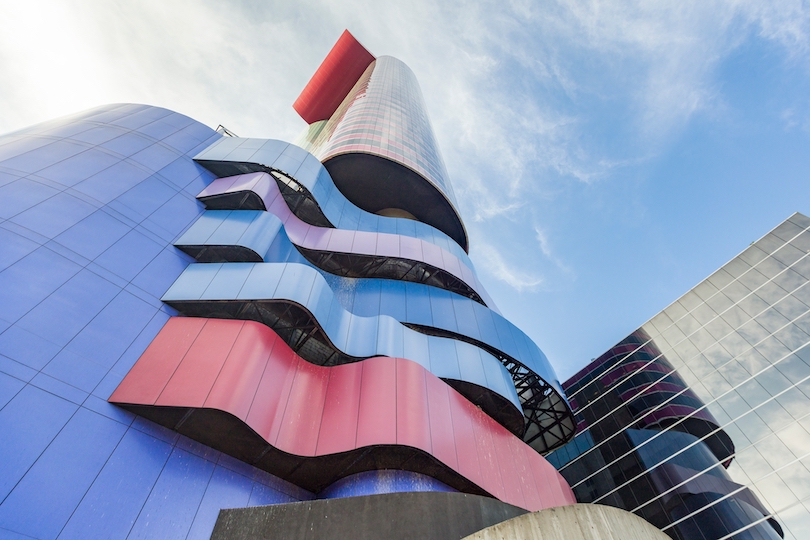
Not far away too is the Instituto Tomie Ohtake which also displays loads of thought-provoking pieces. Housed in a very intriguing-looking skyscraper, the cultural center puts on countless art, design, and architecture exhibitions.
First opened in 2001, the outstanding institute is named after the renowned Japanese-Brazilian artist who’s architect son also actually designed the eye-catching building. Its distinctive curved shape is only fitting considering his mother was a key representative of informal abstractionism in the country.
Now a landmark of the city’s skyline, its two towers also contain a convention center, restaurant, and theater. In its seven spacious exhibition halls, guests can inspect avant-garde sculptures, interesting visual art installations or award-winning photo displays. Very highly rated for its rotating exhibits, the institute is one of Brazil’s most important contemporary art venues.
20. Italian Building Observation Deck
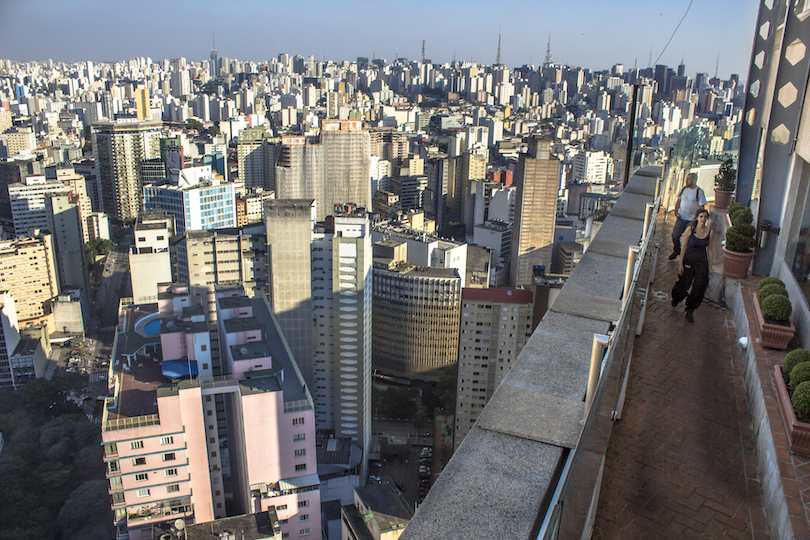
For some of the best views imaginable over the sprawling metropolis, head up to the Italian Building Observation Deck. From the 46th floor, you can gaze out over its vast sea of skyscrapers spreading endlessly away toward the horizon.
One of the tallest buildings on the continent, Edificio Italia stands a staggering 165 meters in height, having been built between 1956 and 1965. Designed by Brazilian architect Franz Heep, it is located within the Republica district of the city center.
Up high, you really appreciate the immense size and scale of the city with sunset being a particularly memorable time to visit. The enormous office tower also has a fancy restaurant and piano bar where you can enjoy a drink or meal. Make sure to check all the entrance requirements beforehand though as there is a dress code and only online bookings are allowed…
19. Cycle or Walk the Minhocao
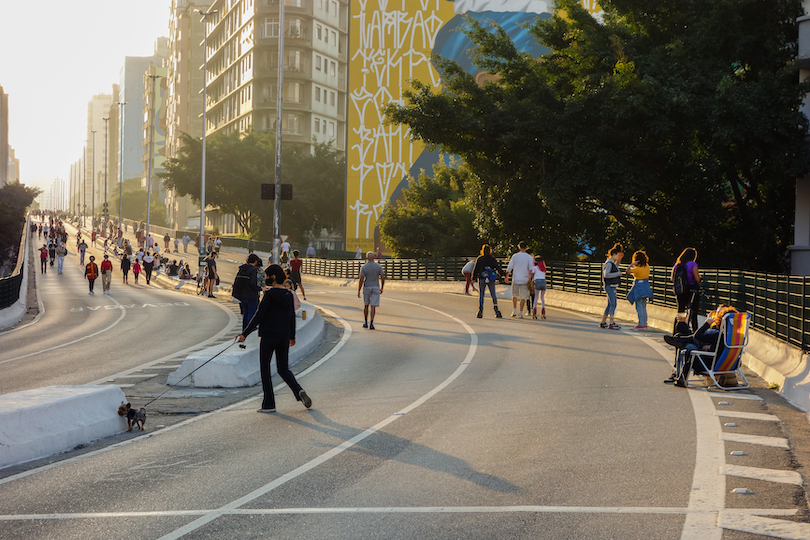
One of the most fun things to do in Sao Paulo and a wonderful way to take in its vibrant atmosphere is to walk, run or cycle along the Minhoção. At weekends and after 8 PM on weekdays, the elevated highway is closed off to traffic. At these times, pedestrians and cyclists take over, creating a lovely laidback ambience.
Literally translated as ‘Big Worm’, the busy highway is often described as an urban planning disaster. Stretching three kilometers in length, it winds its way above the congested streets of the city center, passing right next to apartment block windows for most of the route.
In the evenings and during both weekends and holidays, the vibe of the viaduct changes completely. Instead of honking and fumes, skateboarders, cyclists, dog-walkers, and families flock to the highway en masse. Here they exercise and picnic or simply hang out, sunbathe, and enjoy the silence.
18. Afro Brazil Museum
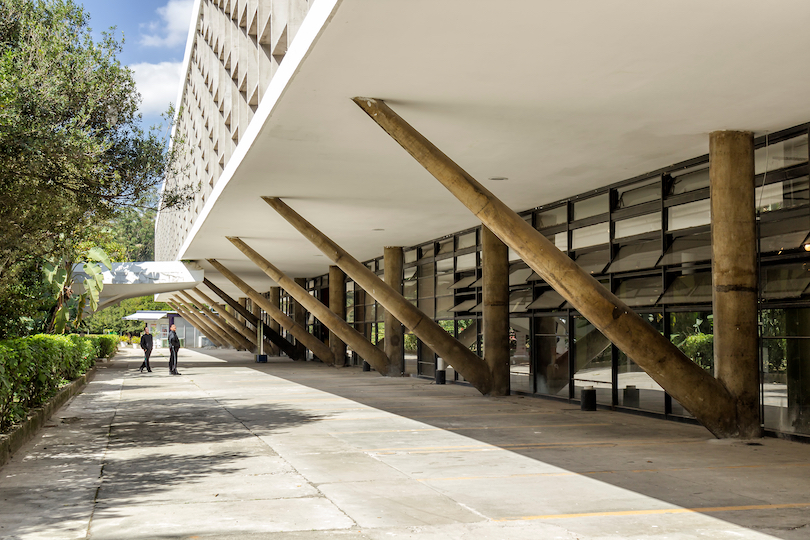
Packed with interesting artifacts and exhibits, the Afro Brazil Museum offers a fascinating look at the history, culture, and heritage of black people in the country. Across its two huge floors, there are tons of paintings and photos, traditional costumes, textiles, and statues to peruse.
Part of the very popular Ibirapuera Park, it was only established in 2004 with its humongous building having been designed by revered architect Oscar Niemeyer. Its exhibits focus on everything from the impact of slavery and Afro-Brazilian cultural spheres to religion, work, and famous figures.
While we really enjoyed all its incredible artifacts and artworks, the museum maybe could have been a bit better laid out. You’ll also want to pick up an audio guide as barely any exhibits are explained in English. We’d highly recommend the collection though and were a bit sad that there were almost no other visitors around when we stopped by.
17. Galeria do Rock
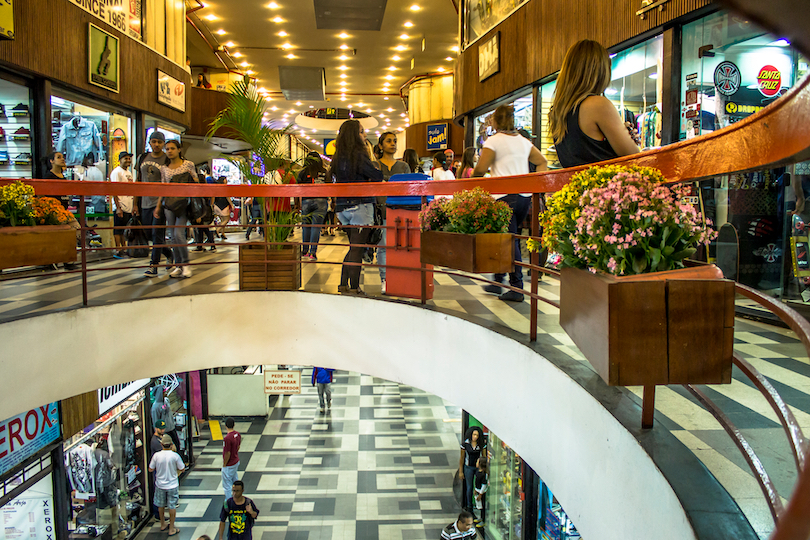
For a fun shopping experience and an alternative vibe, hit up the Galeria do Rock in the Republica part of town. An absolute must for rockers and metalheads, its six floors are full of stores selling CDs and skateboards, band t-shirts, sneakers, and other music-related merch.
Built back in 1962, the massive mall now has roughly 450 shops crammed across its floors to check out. As well as all the endless stores catering to skaters, goths, and hip-hoppers, others specialize in anime, piercings, and tattoos.
While it lies just around the corner from the chic, sophisticated Municipal Theatre, the atmosphere of the streets surrounding the shopping center couldn’t be more different. Quite run down, they have a sketchy feel though are safe enough – just keep an eye on your possessions.
Just two minutes walk from the Galeria do Rock is the absolutely brilliant Brazil Tattoo Museum. Well off-the-beaten-path, the renowned Polaco Tattoo Shop has lots of super cool artworks, paintings, and old pieces of equipment to examine. We really loved seeing all the amazing ink designs after having wandered around the heart of Sao Paulo’s underground scene.
16. Butantan Institute
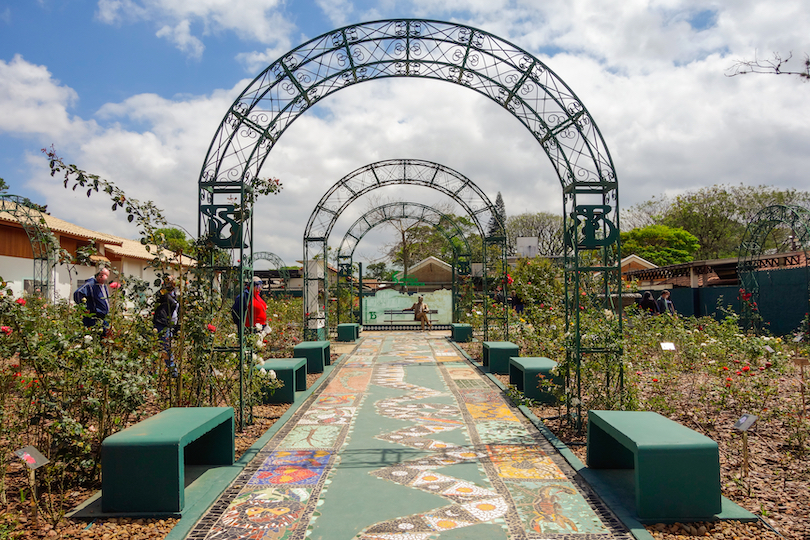
Lying just across the Pinheiros River from Vila Madalena, Batman Alley, and Instituto Tomie Ohtake is the Butantan Institute. One of the world’s most important scientific centers, it has three museums and a never-ending number of reptiles, spiders, and snakes to see.
Now the largest immunobiological and biopharmaceuticals producer in Latin America, the research institute was established in 1901. At its expansive site in western Sao Paulo, guests can learn about microbiology, vaccines, and how venom is extracted and used in experiments. Other parts also cover the history, achievements, and evolution of the prestigious science center.
The highlight though has to be seeing all its venomous scorpions, snakes, and creepy crawlies. After ogling at its brightly-colored insects and lizards, you can stroll around its leafy, landscaped grounds.
15. Paroquia Nossa Senhora do Brasil
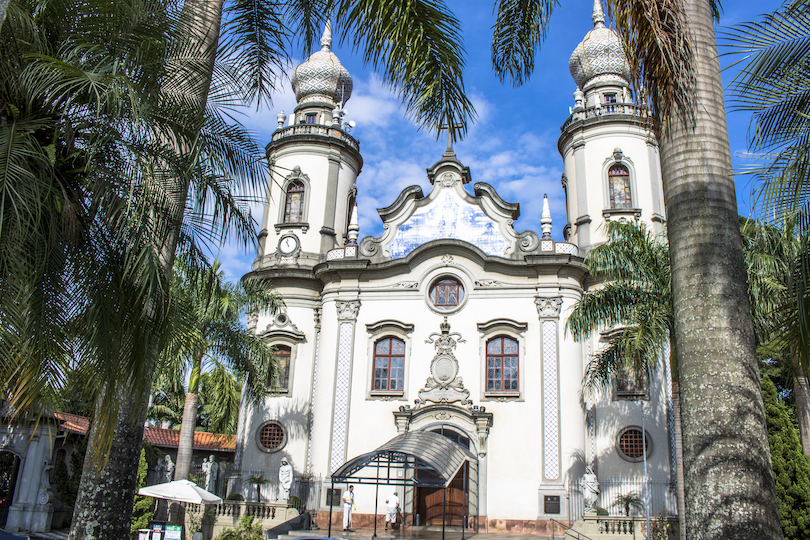
With its two terrific onion domes, fine facade, and exquisitely decorated interior, the Paroquia Nossa Senhora do Brasil is definitely worth stopping by if you have the time. Located just up the road from the Museum of Image and Sound, it is a very popular place to host baptisms and weddings.
Dating to 1940, the beautiful Baroque church has some very pretty Portuguese tiles placed above its already ornate entrance. Yet more of the distinctive blue and white scenes cover its walls inside and the borders around its stunning stained-glass windows. Hand-painted, these depict various religious figures and famed stories from the Bible.
Particularly eye-catching is its phenomenal ceiling painting of a starry sky above the glittering golden altar. Leading up to it too are dozens of delightfully painted scenes that are styled after those of the Sistine Chapel. Many multi-colored tiles and artworks also decorate parts of the lovely little church.
14. Jardim Botanico de Sao Paulo
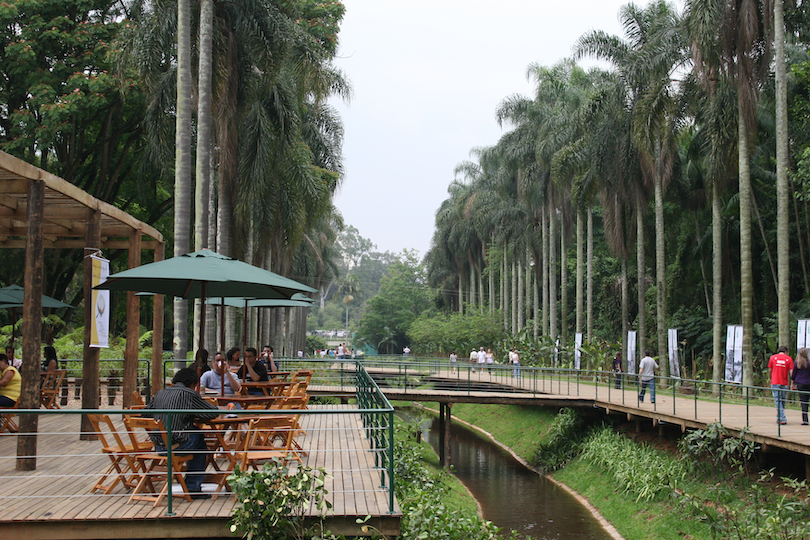
Sprawling across a ginormous area in the city’s South zone is the gorgeous Jardim Botânico de São Paulo. Full of colourful plants, flowers, trees, and shrubs, its winding paths and reflective ponds are a treat to amble about.
Once a state park, its lush green confines and vast swathes of Atlantic Forest were transformed into a botanical garden back in 1928. Amidst all its towering trees and dense undergrowth there are now plenty of paths to explore. While moseying along, you may spy some monkeys playing in the canopy or adorable armadillos and agoutis at ground level. There are also a couple of greenhouses home to orchids and aquatic plants to enter.
After the hustle and bustle of the center and all its endless concrete, the picturesque gardens make a very pleasant change of pace and scenery. To make the trip more worthwhile, you can always visit the city zoo right next to it too.
13. Mosteiro De Sao Bento
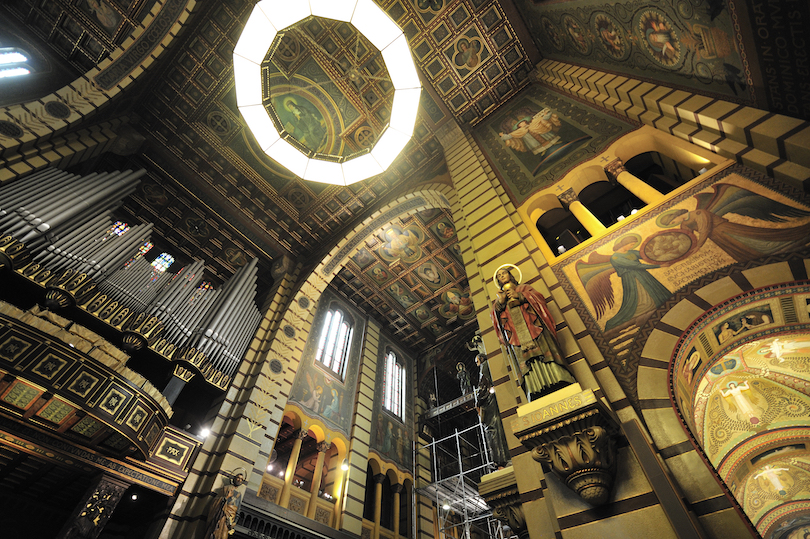
In between Sao Paulo’s Municipal Theater and Municipal Market is the magnificent Mosteiro De Sao Bento. Exhibiting some astounding architecture and artworks, its church is often listed as a must-visit with glorious Gregorian chanting also taking place on Sunday mornings.
Although the Benedictine Monastery was founded in the sixteenth-century, the current complex only dates to the early 1900s. Almost certain to be unlike any other church you’ll come across in Brazil, its dark, atmospheric interior is coated in muted murals inspired by the Beuron Art School. Only adding to its awe-inspiring look and feel are its wonderful wood statues of saints and its hulking great organ. Sparkling stained-glass windows let in some light while graceful arcades look out over its long nave.
The church’s rather austere yet imposing facade also makes for some fabulous photos as do all the artworks inside. Still a working monastery home to a brotherhood of monks, its memorable Sunday morning masses are accompanied by Gregorian chanting and organ music. You can also dine at the religious complex afterwards or pick up some cakes, biscuits, and bread at their bakery.
12. Museu Catavento
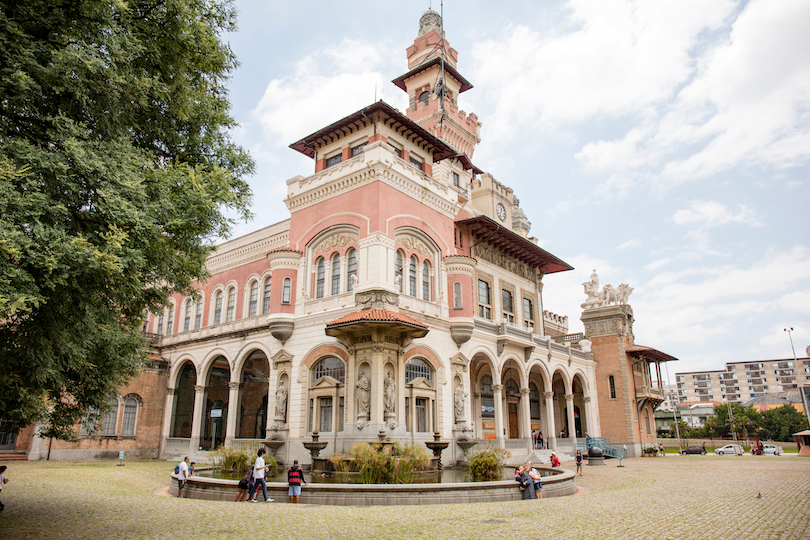
Yet another interesting and unique building to see is the Museu Catavento which lies just across the Tamanduatei River. Long a firm favorite with families and school trips, it now houses lots of thrilling science and technology exhibits.
While the museum was only opened back in 2009, the Eclectic-style palace was completed almost a hundred years earlier. After having originally hosted industrial exhibitions and later even a legislative assembly, it served briefly as the City Hall. The building certainly is grand enough as its lofty, turreted tower overlooks an imaginative-looking facade and old trains and planes dotted around its grounds.
Although we really came for the museum’s extraordinary exterior, its hands-on exhibits, and activities were good fun too. These shine a light on everything from Earth and the universe to subjects like the human body, electricity, and engineering. Despite only being explained in Portuguese, they were very well-done with tanks full of fish and butterflies also on show.
11. Sala Sao Paulo
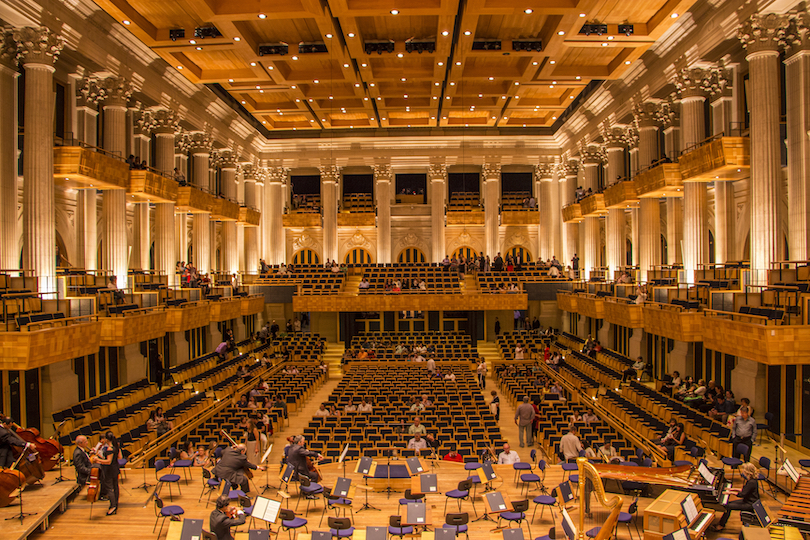
If after all the museums, historic sites, and nature spots you want to see a show, then Sala São Paulo is one of the best places to go. Renowned for its excellent acoustics, the irresistible auditorium puts on a packed schedule of top-class classical concerts and orchestra performances.
Absolutely jaw-dropping, its majestic main concert hall actually occupies what was formerly the Julio Prestes Train Station. Built between 1926 and 1938 by the coffee barons, the enormous neoclassical building was renovated in 1997 to host the Sao Paulo State Symphonic Orchestra.
The plan certainly succeeded as the cavernous ‘shoebox-style’ hall both looks and sounds out of this world thanks to its adjustable ceiling. Warmly lit, the colossal columns lining its walls are set between fine wooden balconies and mezzanines overlooking the stage. Wherever you sit, you’re guaranteed marvelous music in a stunning setting.
10. Mercado Municipal
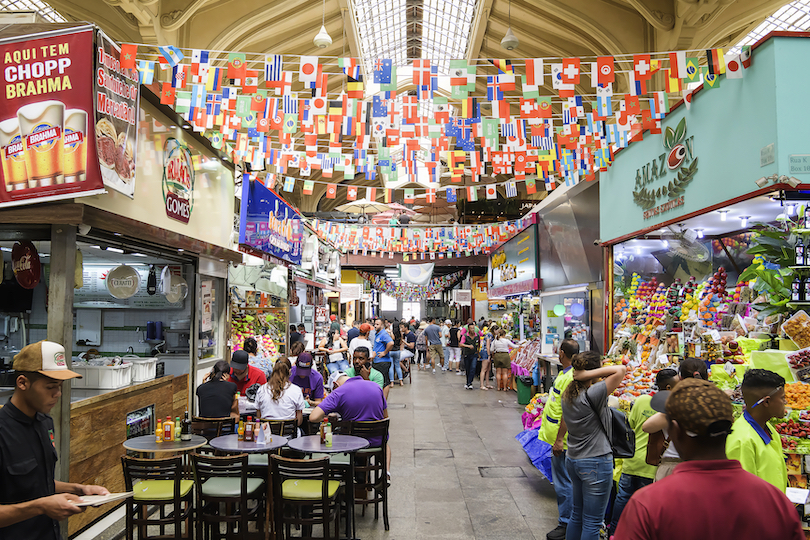
Back towards the river is the massive Mercado Municipal de Sao Paulo. Loads of fun to explore, its stands and stalls sell all kinds of fruit, vegetables, and artisanal food products. Numerous little cafes and restaurants are also scattered here and there.
Similar in style to the Sala, the vast 1933 market building is noted for its soaring columns, vaults, and stained-glass windows. Once past its fetching facade, you’ll find rows and rows of endless shops to wander about, all delightfully presented. From its rather boisterous vendors, you can buy exotic fruits and spices or cheeses, meats, and regional wines.
Must-tries here include its signature mortadella sandwich – packed with an absolutely absurd amount of meat – and the bolinhos de bacalhau (fried balls of cod). While the lively atmosphere and artisanal products from the Amazon are fantastic, watch out for the seemingly friendly fruit sellers. As you can see from all the reviews online (and as we experienced!), they are experts at scamming tourists and selling fruit for scandalous prices.
9. Museu da Lingua Portuguesa
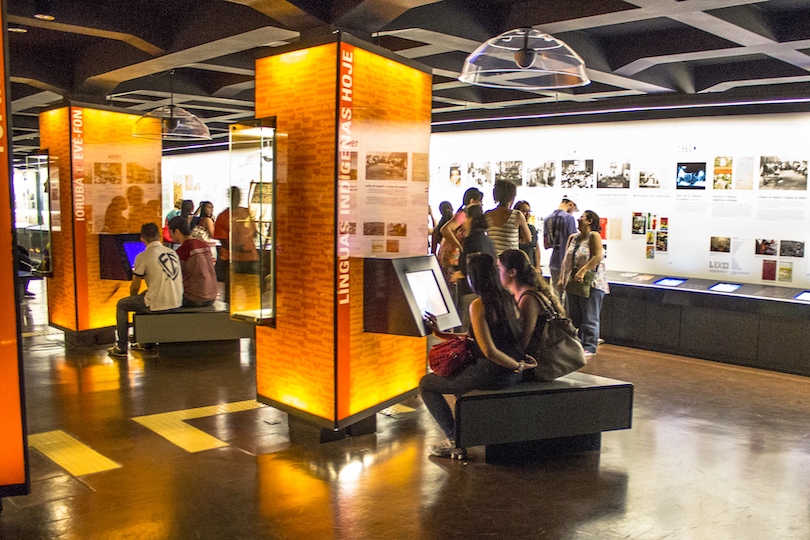
Located right next to the Sala and Pinacoteca, the Museu da Lingua Portuguesa covers the origins, history, and evolution of the lovely language. Across its three floors are tons of interactive exhibitions, images, and sounds with talks and film screenings sometimes taking place.
Founded in 2006, the museum is housed in the very busy Estacao da Luz – the former headquarters of the Sao Paulo Railway. The reason this location was chosen is that thousands of immigrants used to arrive here, ready to start their new lives in the Portuguese-speaking country.
After admiring its formidable facade and famous clock tower, you can learn all about accents, idioms, and cultural influences inside. The museum also contains a small cafe and viewing platform that lies above the station and its adjacent park.
Be aware before heading here though that almost all of its exhibits are only in Portuguese. If you do speak the language, we’d also recommend the moving Memorial da Resistência de Sao Paulo along the same road. The small museum mainly focuses on resistance and repression in the city under the Brazilian dictatorship.
8. Museu do Futebol
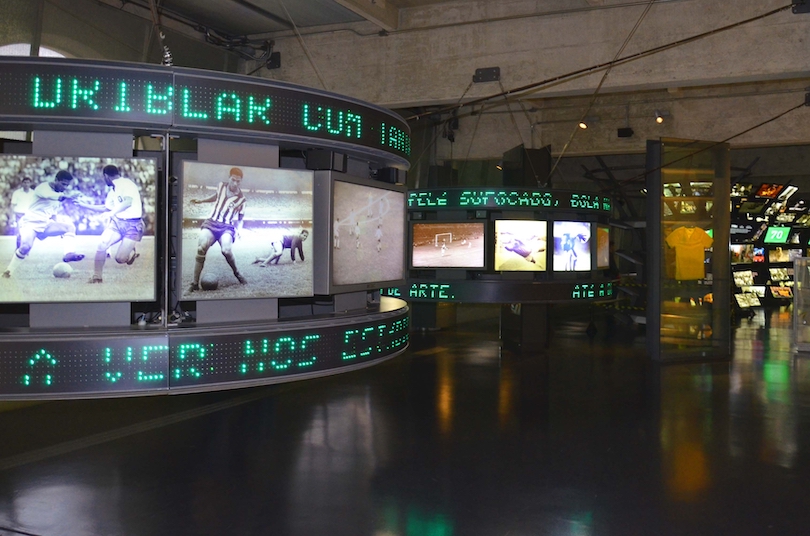
As no other country is so synonymous with the sport as Brazil, you just have to check out the Museu do Futebol if you have the chance. Set within the Art Deco Pacaembu Stadium, it boasts a veritable treasure trove of classic shirts, flags, photos, and trophies.
Inaugurated in 2008, its galleries look at the huge impact football has had on the nation’s history and culture. Giant screens play out famous World Cup wins with other rooms covering legendary players like Pele, Garrincha, Ronaldo, and Ronaldinho. All its emotive images and radio interviews perfectly highlight why it is such a key part of Brazil’s identity,
Although its exhibitions are again mostly only in Portuguese, its epic videos, photos, and memorabilia still make it a must. There is also a fun shooting game to try and tours to take of this iconic stadium. Die-hard fans of the beautiful game will find it impossible to leave the museum shop without at least a couple of retro jerseys in hand.
As the city is home to some of the biggest teams in Brazil – Corinthians, Sao Paulo, and Palmeiras – it is a great place to catch a match. Thanks to the heaving crowds of passionate fans, the atmosphere promises to be utterly intoxicating and unforgettable.
7. Sao Paulo Cathedral
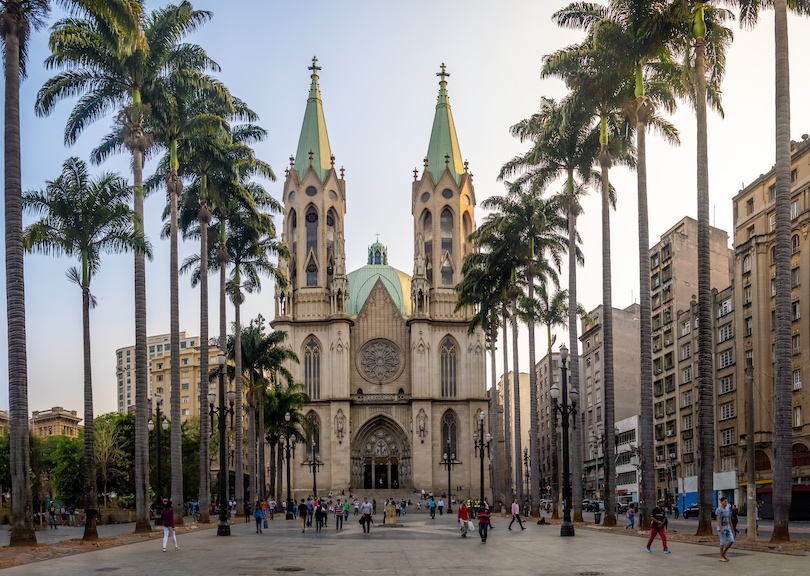
Certainly one of the city’s most beautiful buildings, São Paulo Cathedral’s gigantic dome, and tall twin towers rise up dramatically above the large square and palm trees below. Exhibiting some gorgeous Gothic Revival-style architecture, it also has a cool crypt for you to enter.
Slowly completed over the course of four decades, it was eventually consecrated in 1954, right in the heart of town. Remarkably enough, a church has now stood in the exact same spot since 1589 when only a small settlement existed. Both from up close and afar, it makes for some phenomenal photos, what with the leafy palms all around it.
Inside is just as spectacular as fine religious artworks and superb stained glass windows decorate its walls. We really liked seeing the cathedral’s atmospheric crypt which contains marble sculptures and the tombs of influential figures. This includes the final resting place of Tibirica – the friendly local chief who made the city’s founding possible.
Despite the large police presence around the cathedral, the surrounding area is still decidedly dodgy to walk around. Watch out when taking photos outside and keep an eye on your possessions.
6. Teatro Municipal De Sao Paulo
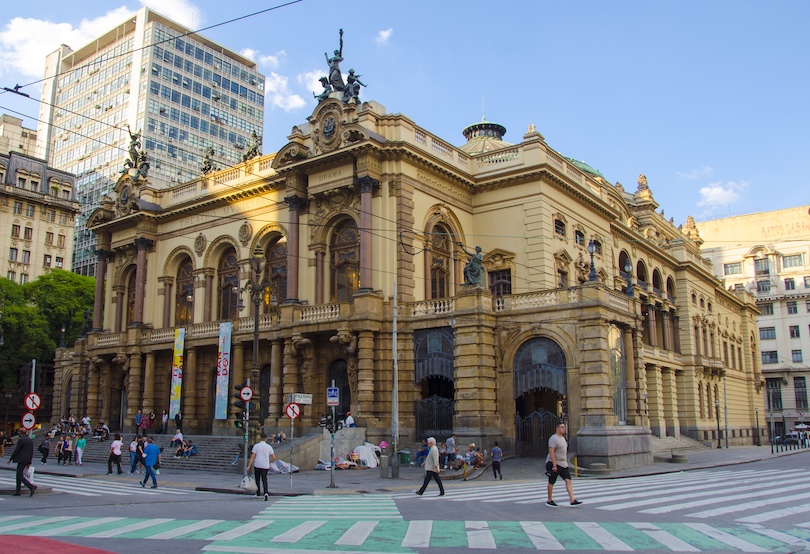
Rivaling the cathedral in terms of its splendor though has to be the Teatro Municipal De Sao Paulo. One of South America’s most important venues for the performing arts, it hosts outstanding operas, ballets, and concerts.
As most of the Brazilian bourgeoisie lived in the city in the twentieth century, the decision was made to build an opulent opera house. In 1911, the lavish theater was unveiled with everyone admiring its arresting mix of Baroque, Renaissance, and Art Nouveau architecture. Over the decades, big names such as Bidu Sayao, Tito Schipa, and Carla Fracci have all graced its hallowed stage.
Now home to the city’s ballet, choir, and symphony orchestra, its lobby, Noble Room and Great Hall are resplendently decorated. If you don’t manage to grab a ticket to a show, you can take tours of all their rich red and gold interiors instead. Besides learning about the landmark theater’s past, you can see all its sumptuous stuccowork, sculptures, and stained-glass windows.
5. Pinacoteca do Estado
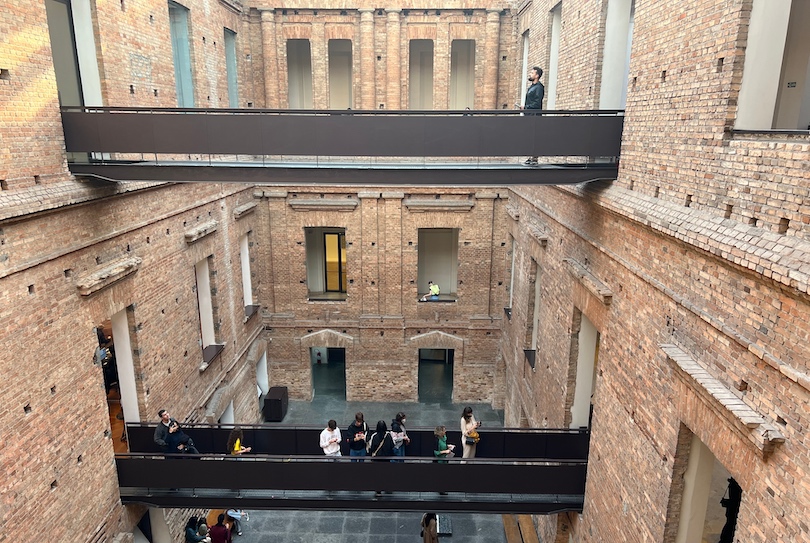
Another of both the city and country’s main arts institutes is the prestigious Pinacoteca do Estado. At the very highly-rated museum, you can examine some of the best Brazilian paintings and sculptures from the nineteenth century.
The oldest art museum in Sao Paulo, the Pina was established back in 1905. Its extensive collection of some 10,000 or so artworks now occupies what was once the headquarters of the Lyceum of Arts and Crafts. The renovated building’s exposed brickwork, airy central atrium, and impressive staircase already make it memorable to visit.
On display in its light-filled rooms are wonderful masterpieces by Tarsila do Amaral, Anita Malatti, and Lasar Segall among others. With drawings, engravings, and photos also featured, the Pinacoteca is a must for many. It also conveniently lies right next to many of the city’s other main sights, just behind the Estacao da Luz in a green park.
4. Avenida Paulista
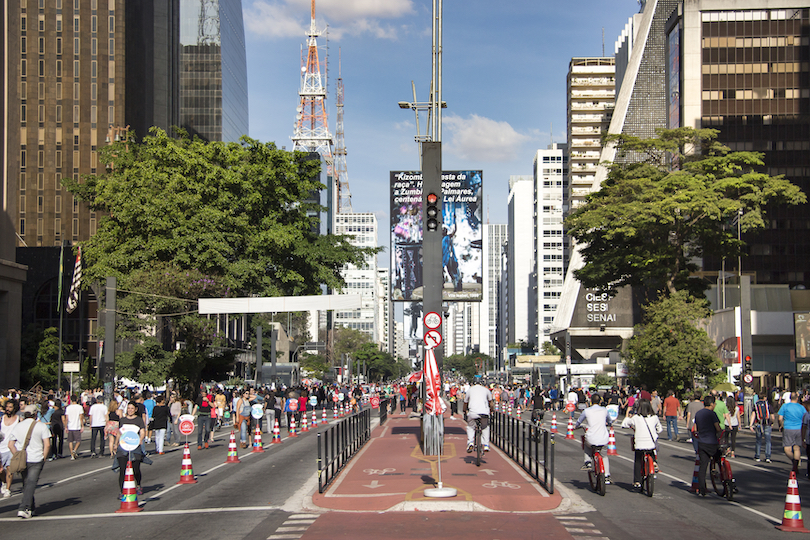
Running its way right through the city is the iconic Avenida Paulista. The pride of Paulistas, the busy thoroughfare is lined by countless shops, restaurants, galleries, theaters, and museums. Overlooked by glinting glass high-rises, it is both an important center of finance and politics and an entertainment and cultural hub.
Connecting numerous neighborhoods together, the seemingly endless, straight avenue stretches almost three kilometers in length. Its bustling sidewalks bristle with cafes, bars, and shopping centers with exclusive private schools and financial institutions also dotted about. At any time of day, it has a very vibrant ambience with something always going on. Along here, we really enjoyed the Itau Cultural Centre’s old maps and drawings of the country and Sesc’s spellbinding viewpoint.
While we didn’t really get all the fuss above the avenue, we admittedly didn’t visit on Sundays when it is closed off to traffic. As with the Minhoção, people exercise, picnic, and listen to street performers or shop and hang out with friends and family. Avenida Paulista also hosts some very popular events with both New Year’s Eve parties and Pride taking place here.
3. Museu de Arte de Sao Paulo (MASP)
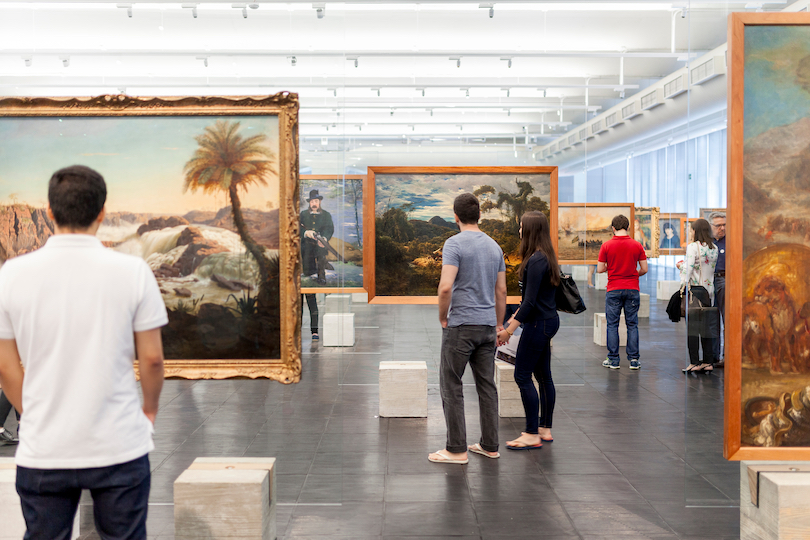
Along it too is the must-see MASP which is yet another of the continent’s most celebrated museums. With its distinctive building, delightfully different layout, and hundreds of thought-provoking art pieces, it was definitely one of the best places we visited in Sao Paulo.
Internationally recognized for its collection of European art, the magnificent museum was founded in 1947 with Brazilian, African, and Asian works also featuring. Displayed in its large, open galleries are fabulous paintings by Picasso, Monet, and Van Gogh alongside many others. As they are all mounted on glass in the middle of the floor, you can inspect them from every angle.
Immediately recognizable, the museum’s gigantic glass construction is suspended in the air between two bright red concrete supports. One of Brazil’s best-known Brutalist structures, it was designed by architect Lina Bo Bardi. Almost as interesting as all the artworks themselves, the imposing modernist building makes for some fantastic photos.
2. Liberdade District
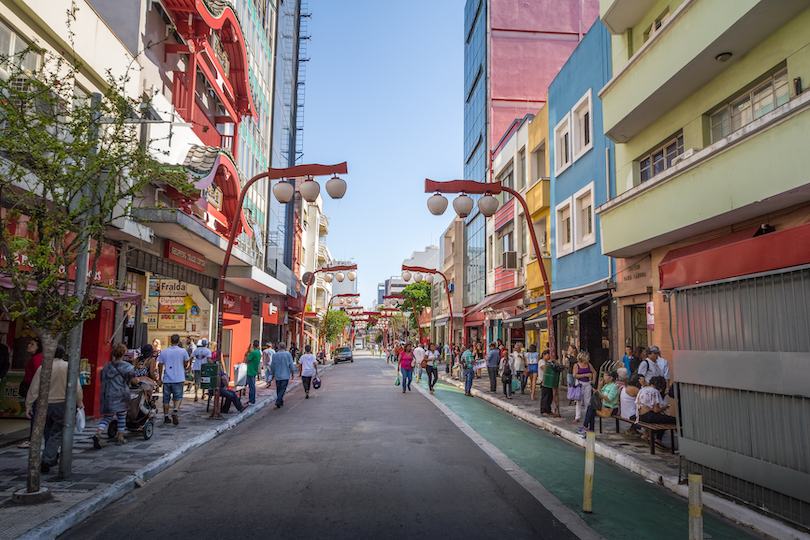
One of the coolest parts of the city to explore has to be the Liberdade District which has a distinctly Japanese look, feel, and identity. As well as all its sushi joints and specialist supermarkets, countless cramped shops sell cheap electronics, manga comics, and souvenirs.
Believed to be home to the largest Japanese community outside of Japan, its origins date to around 1912 when thousands of families moved here for the cheap rent. Loads of Chinese, Taiwanese, and Koreans now also live in the area. As a result, you can find shops and restaurants selling tasty food and traditional products from all three countries.
Although we really liked the Japanese District’s different flavor, we did expect the neighborhood to be a bit bigger. It was fun though walking beneath its torii gate along lantern-lined streets and seeing all the cute, colourful eateries. On Sundays, there is also a little street market where you can pick up arts, crafts, and artisanal food products.
1. Ibirapuera Park
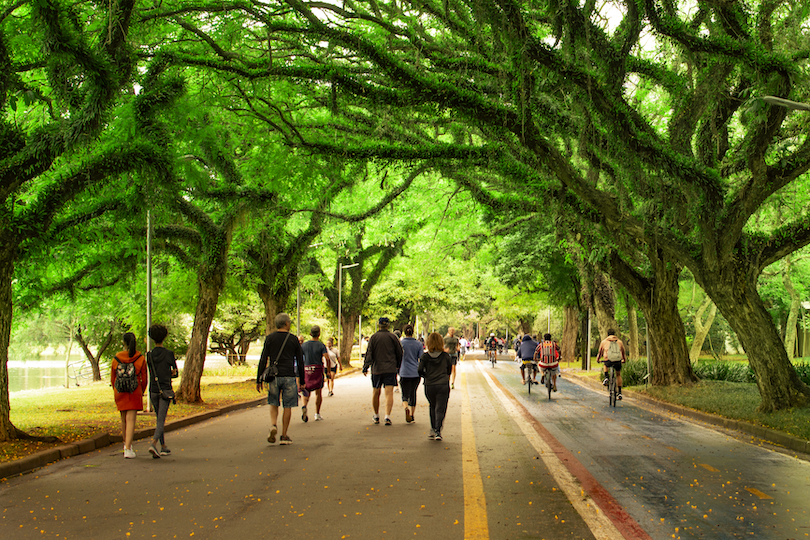
Sampa’s answer to Central Park, Ibirapuera Park serves as a major recreational site and is one of the main tourist attractions in Sao Paulo. An oasis of peace and calm, its gorgeous green grounds have lots of paths to walk, run or cycle along. Some of the metropolis’ best monuments and museums can also be found here.
One of the largest urban parks in Latin America, it covers a ginormous part of the city’s south side. In addition to the Afro Brazil Museum and Ibirapuera Auditorium, there are a handful of other excellent museums to check out, many designed by Oscar Niemeyer. Among its most photographed sites are its enormous obelisk and the Monument to the Bandeiras.
Other than seeing all its statues, artworks, and the Japanese Pavilion, there are plenty of picturesque nature spots to enjoy. Many locals also picnic in the park or practice capoeira, yoga, and play football.
Amidst all its lush woodland and reflective ponds, you can relax and unwind after a hectic time spent exploring the largest city in all the Americas.
Best Time to Visit São Paulo
As Sao Paulo is such a massive metropolis and has just so much to see and do, it’s a great year-round destination. That said, there are of course better times to visit weatherwise with all kinds of exciting events also drawing large crowds to the city.
While the summers are hot and wet, most people still visit between December and February (the seasons in Brazil are opposite to those in the Northern hemisphere). Aside from all the Christmas and New Year’s celebrations, there is of course Sampa’s fun-filled carnival to take part in. Prices and temperatures are at their highest with averages of 26 to 28°C (79 to 82°F).
If you want to avoid the worst of the crowds and humidity, then both autumn and spring are better bets. Much drier, March to May has massive events like Fashion Week to attend. While wetter, spring (October and November) instead has its exciting Grand Prix going on.
June to September (winter in Brazil) sees average temperatures of 22 to 24°C (71 to 75°F). Both domestic and international tourists flock here as the dry weather is ideal for sightseeing and strolling around Ibirapuera Park. Parades are also held for Sao Paulo Pride and concerts for the Festa de Sao Vito.
Map of Things to Do in Sao Paulo
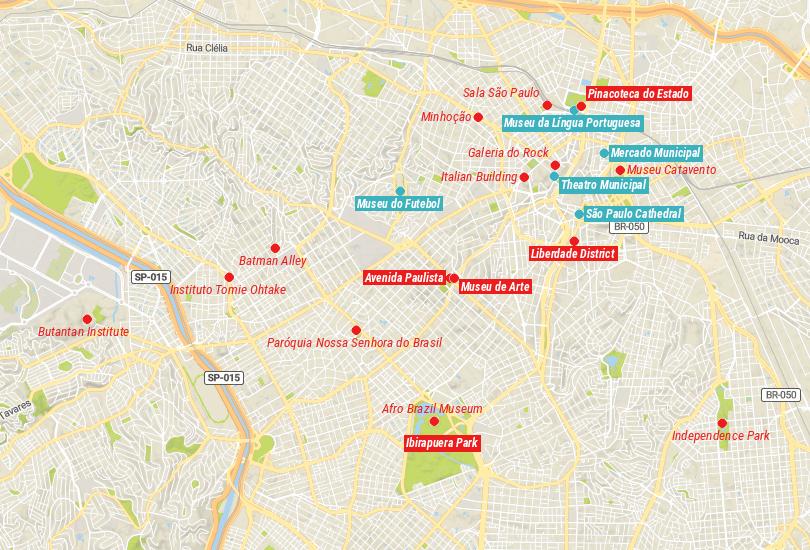
Share this post:

10 Best Things to Do in Manaus, Brazil
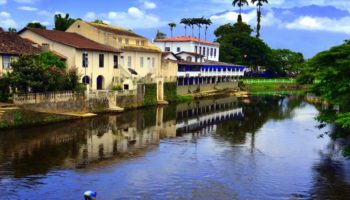
10 Most Amazing Destinations in Southern Brazil
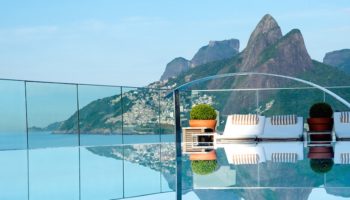
11 Most Awesome Places to Stay in Brazil

17 Best Places to Visit in Brazil
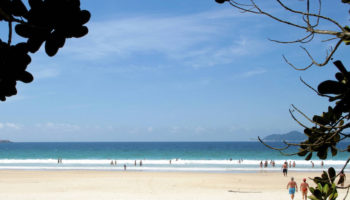
10 Best Beaches in Brazil
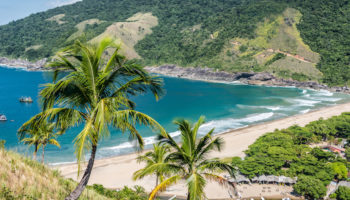
10 Most Beautiful Islands in Brazil
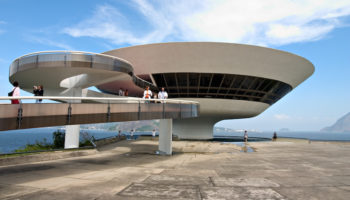
27 Top Tourist Attractions in Brazil
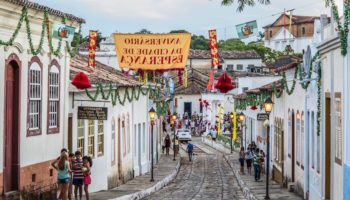
14 Most Beautiful Small Towns in Brazil
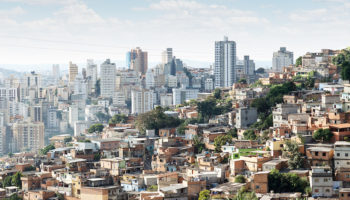
17 Best Cities to Visit in Brazil
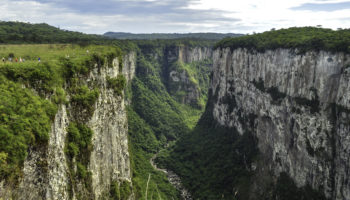
10 Most Beautiful National Parks in Brazil
Reader interactions, leave a reply cancel reply.
Your email address will not be published. Required fields are marked *
This site uses Akismet to reduce spam. Learn how your comment data is processed .

COMMENTS
To discover the best places to visit and things to do, use this handy list of the top tourist attractions in Brazil. 1. Cristo Redentor and Corcovado, Rio de Janeiro. 2. Sugar Loaf, Rio de Janeiro. 3. Iguaçu Falls. 4. Copacabana, Rio de Janeiro.
Things to Do in Brazil, South America: See Tripadvisor's 17,737,000 traveler reviews and photos of Brazil tourist attractions. Find what to do today or anytime in June. We have reviews of the best places to see in Brazil. Visit top-rated & must-see attractions.
27. Porto de Galinhas. 27. Porto de Galinhas. Porto de Galinhas, or "Port of Chickens," on the south coast of Pernambuco in the district of Ipojuca, is a beach town home to some of the most famous beaches in Brazil. A prominent tourist spot, Porto de Galinhas is breathtaking, with natural crystalline-clear pools, thriving reefs, and white ...
7. Fernando de Noronha. An archipelago of islands some 320km (200 miles) off the northeast coast, Fernando de Noronha is high on many honeymoon wishlists. Of Noronha's 21 islands, only the largest one is accessible to tourists - and even then, its boundaries lie safely within Brazil's largest marine park.
Christ the Redeemer. One of Brazil's most iconic monuments and Rio's most visited attraction, the statue of Christ the Redeemer was completed in 1931 and stands 98 feet tall, with horizontally outstretched arms spanning 92 feet. The work of Polish-French sculptor Paul Landowski and Brazilian engineer Heitor da Silva Costa is made of ...
Aerial view of Copacabana Beach in Rio de Janeiro Pelourinho, Bahia. Of all Brazil tourist attractions, Pelourinho in the historic center of Salvador is a unique place with universal values in the country (and it also is a UNESCO World Heritage Site).. As Brazil's first capital, from 1549 to 1763, Salvador witnessed the blending of African, Amerindian, and European cultures.
5. Florianopolis. The capital of Santa Catarina state, Florianopolis lies in the south of Brazil, with half of the city set on the mainland and the other on a beautiful island. Due to its scenic setting, it is a very popular tourist destination and is widely considered one of the best places to live in the country.
1. Iguazu Falls. 45,445. Historic Sites. The colossal power of these thundering falls, viewable from both Argentina and Brazil, and accessible from Paraguay, is a mesmerizing sight: 275 separate falls in a U-shaped formation pound the water…. See ways to experience (120) 2023. 2. Sugarloaf Mountain Cable Car.
2. Spot whales in Praia do Rosa. Once a sleepy fishing hamlet, Praia do Rosa is now a top surf destination, with charming guest houses and hotels tucked into the hillside above a bay. In the winter months (June to November), surfers are joined by another type of visitor playing in the waves: southern right whale calves.
Parque Nacional da Serra da Capivara. Piauí. One of Brazil's most important national parks, this 1300-sq-km reserve contains more than 40,000 rock paintings among spectacular panoramas of immense….
Christ the Redeemer. One of Brazil's most iconic monuments and Rio's most visited attraction, Christ the Redeemer captures the imagination and hearts of hundreds of thousands of travellers each year. In addition to the symbolic importance in the Catholic community, the statue is also one of the New 7 Wonders of the World and provides spell ...
1. Christ the Redeemer (Cristo Redentor) Nico Kaiser, CC BY 2.0, via Wikimedia Commons. Christ the Redeemer, which stands 2,300 feet above Rio de Janeiro, is one of Brazil's most recognizable landmarks. The 130-foot-tall statue, which was built between 1922 and 1931 has become a globally recognized symbol of Rio.
Brazil is a country that is increasingly investing in public safety and is strengthening security in tourist destinations. Tourists wishing to visit the country can travel with peace of mind. In the event of an incident, there are police stations throughout the country. In most capital cities, there are also specialised tourist police stations.
Christ the Redeemer. This iconic landmark is a must-see attraction in Rio. Recognized as one of the New Seven Wonders of the World, this statue of Jesus Christ stands with arms outstretched to the ...
Brazil Tourist Attractions. According to the World Tourism Organisation (WTO), Brazil is one of the world's most popular destinations and has some of the best tourist attractions. The country offers tourists plenty of things to do, things to see, and places to visit. From leisure to adventure travel, Brazil has it all.
4. Ipanema. Ipanema. Continuing on westward from Copacabana's four-kilometer strand, the beaches of Ipanema and Leblon are separated by the Jardim de Alá Canal, which drains the lagoon, Lagoa Rodrigo de Freitas. Along the seafront promenade are large hotels, sidewalk cafés, and restaurants.
1. Iguazu Falls. 45,445. Historic Sites. The colossal power of these thundering falls, viewable from both Argentina and Brazil, and accessible from Paraguay, is a mesmerizing sight: 275 separate falls in a U-shaped formation pound the water…. See ways to experience (120) 2023. 2. Sugarloaf Mountain Cable Car.
South America. One of the world's most captivating places, Brazil is a country of powdery white-sand beaches, verdant rainforests and wild, rhythm-filled metropolises. Best Time to Visit. Best Places to Visit.
14. Theatro Municipal. Located in the city center, the Theatro Municipal do Rio de Janeiro — or Municipal Theater — is Rio's main opera house. First built at the beginning of the 20th century, this is a gorgeous neoclassical building that boasts gilded mirrors, marble columns and green onyx staircases.
6. Parque da Independància and Museu Paulista. Parque da Independància and Museu Paulista. In São Paulo's Ipiranga district, traversed by the stream alongside which the independence of Brazil was proclaimed by Prince Pedro, Independence Park commemorates that 1822 event.
Tourism is a growing sector and key to the economy of several regions of Brazil. The country had 6.589 million visitors in 2018, ranking in terms of the international tourist arrivals as the second main destination in South America after Argentina and third in Latin America after Mexico and Argentina. [2] Revenues from international tourists ...
4. Sao Paulo. This enormous city is the largest in Brazil, with over twenty million people living within its metropolitan region. As such, it is an exhausting yet exhilarating place to explore. Sao Paulo has a beehive of activity; visitors will love its vast range of world-class attractions.
Here are 10 examples of sustainable tourism in some of the world's most scenic towns. Giethoorn, often called the "Venice of the North," is a picturesque village in the Netherlands. is by bike ...
Often overshadowed by other cities in Brazil, Sao Paulo's thriving cultural scene, pounding nightlife, and the range of international cuisine available make it well worth a visit. On this Page. 23. Independence Park. 17. Galeria do Rock. 23. Independence Park.